It seems we can’t find what you’re looking for. Perhaps searching can help.


Blog
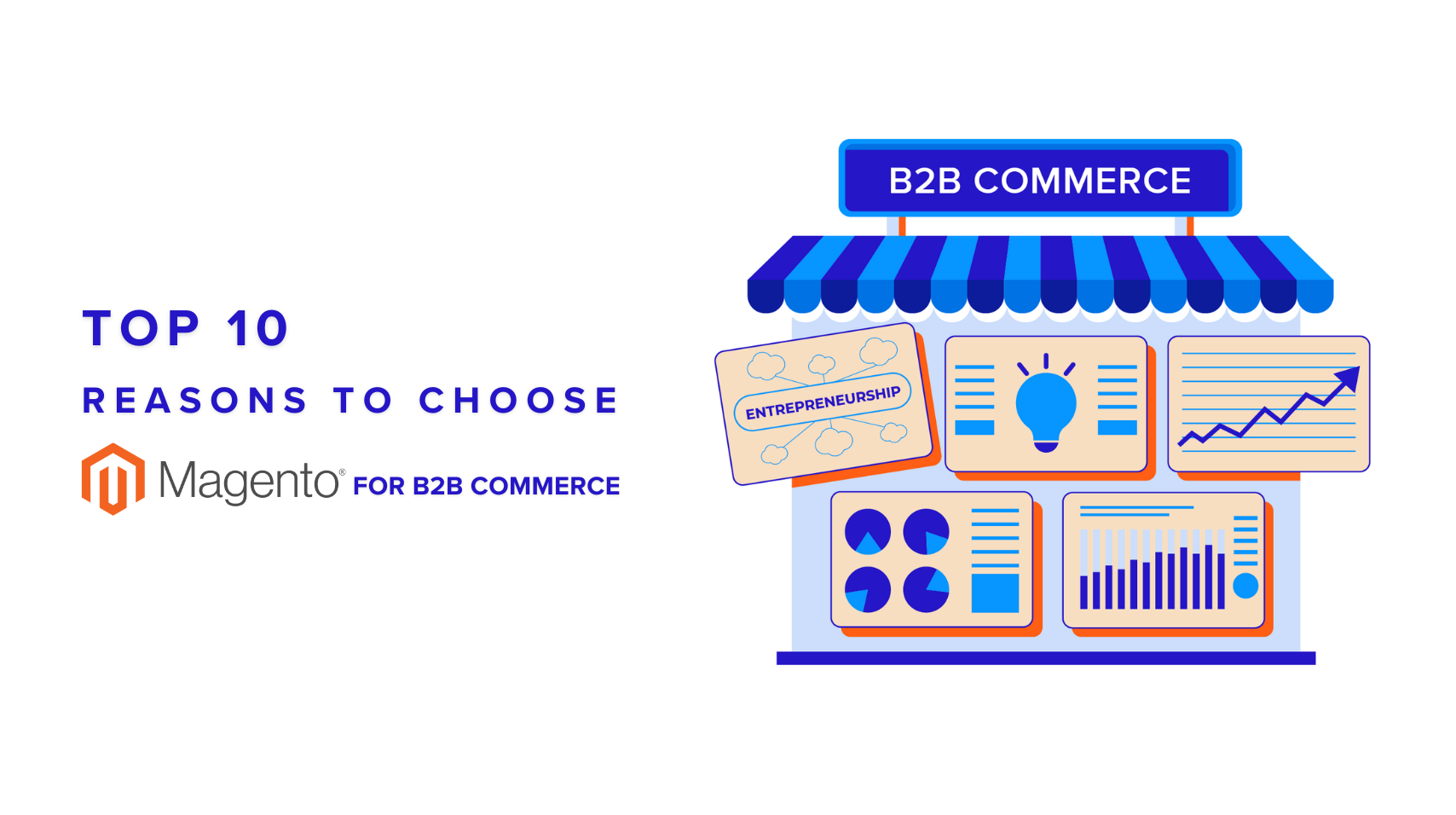
 2
2

 450
450

 0
0

 1
1
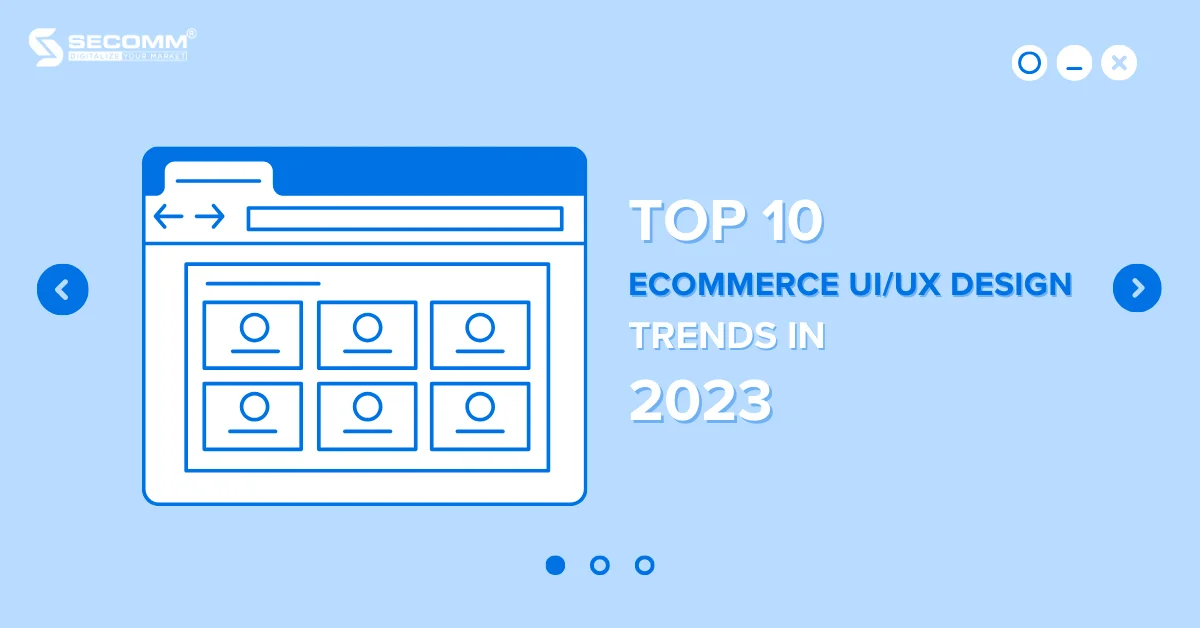
 2
2

 10,198
10,198

 0
0

 1
1
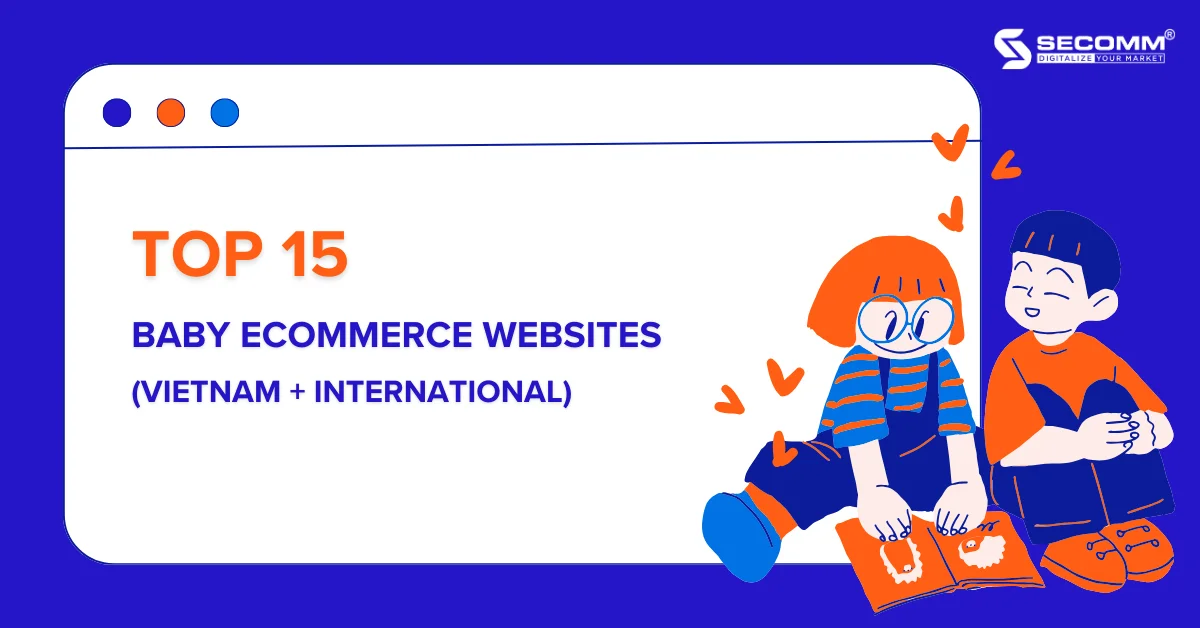
 2
2

 10,169
10,169

 0
0

 1
1
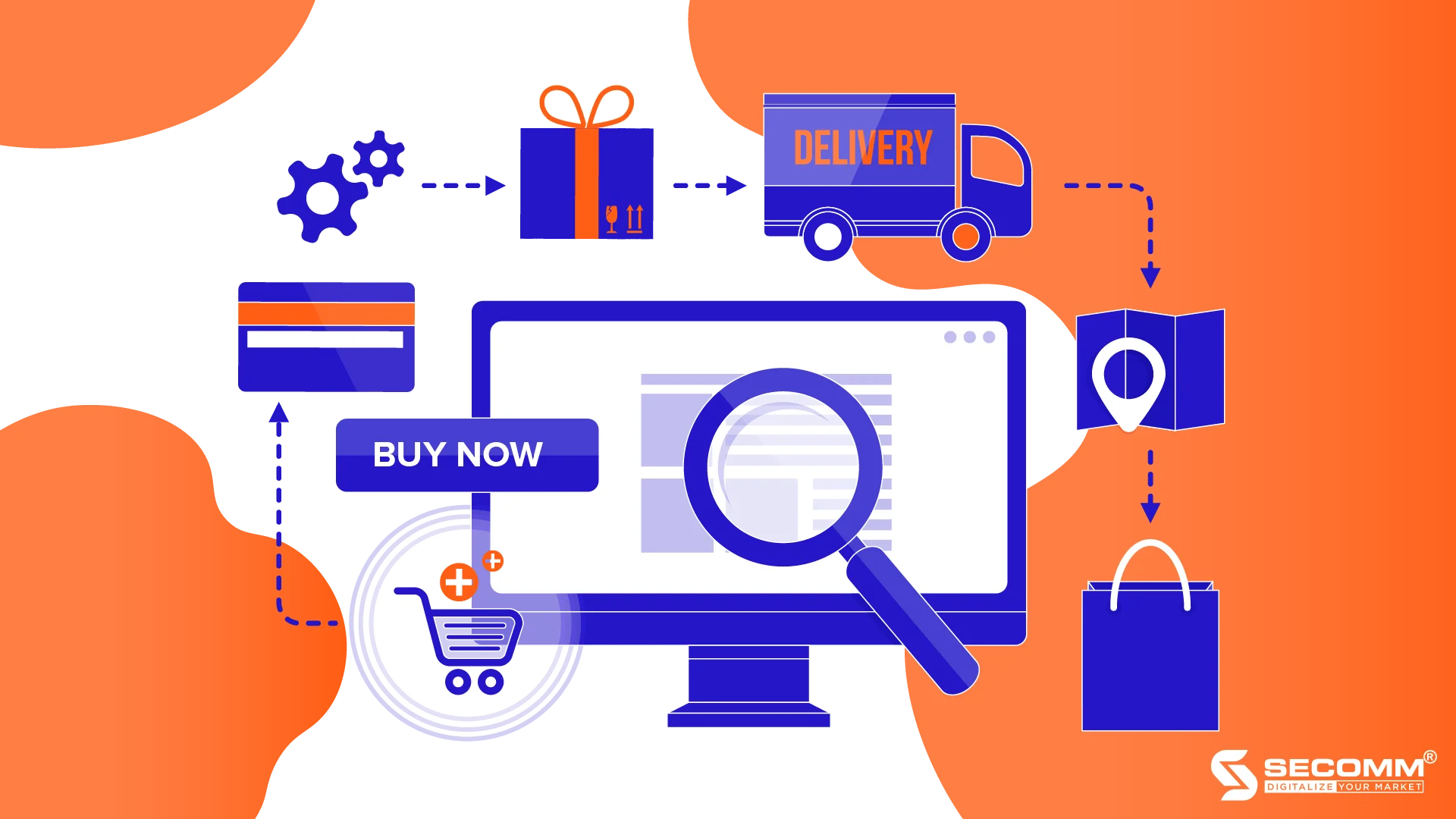
 2
2

 10,024
10,024

 0
0

 1
1
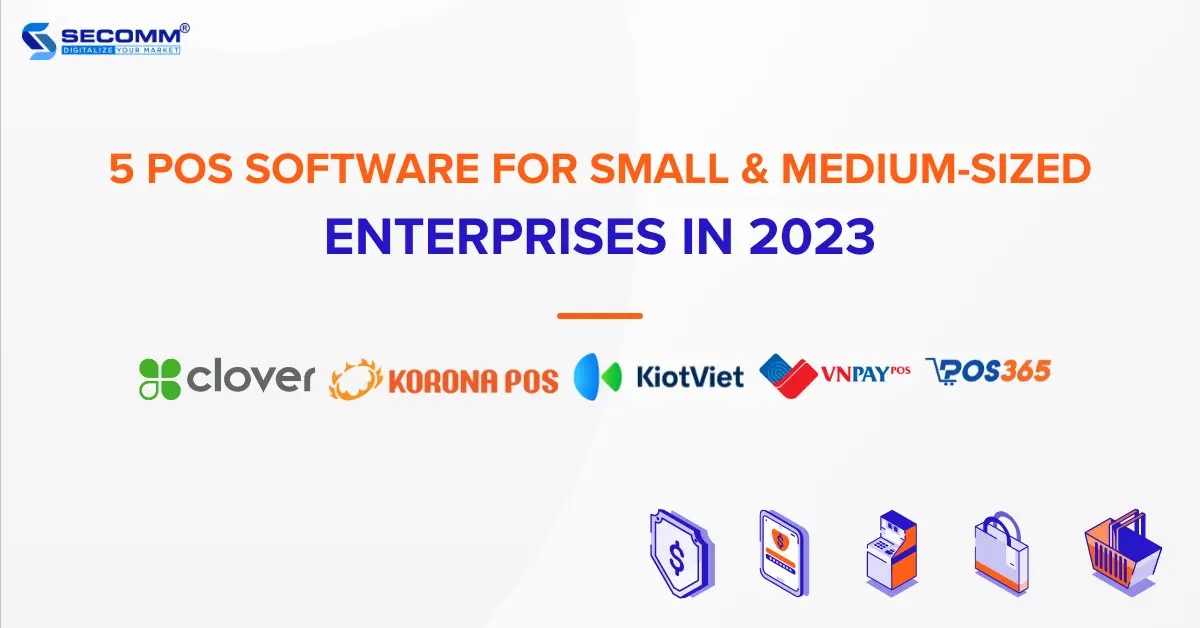
 2
2

 9,769
9,769

 0
0

 1
1




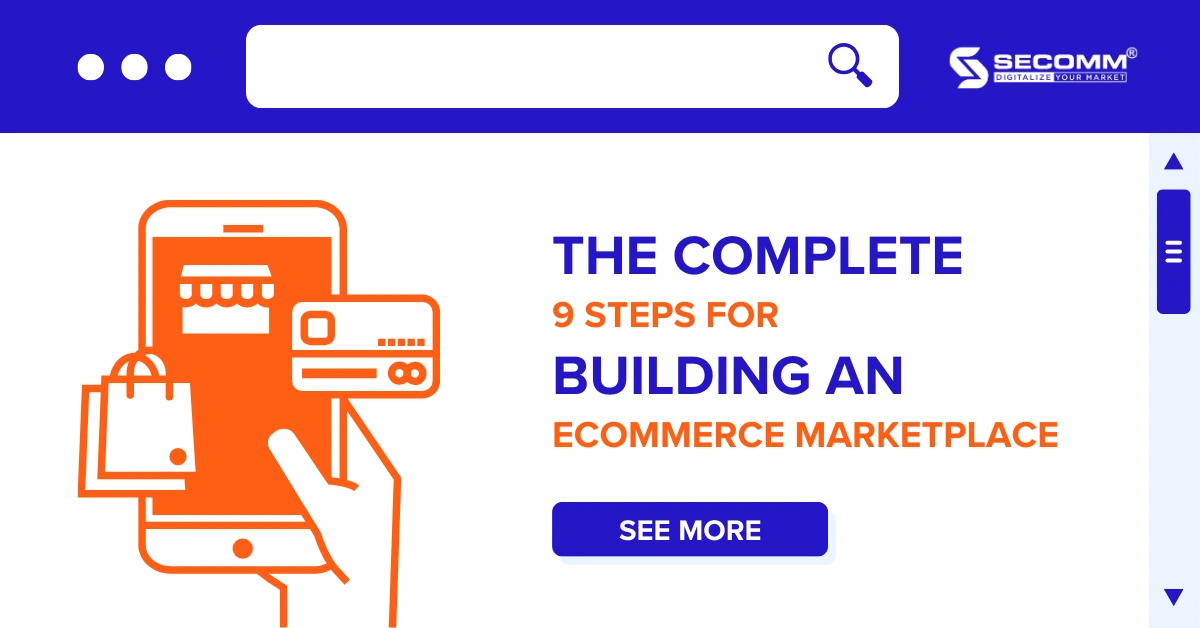
THE COMPLETE 9 STEPS FOR BUILDING AN ECOMMERCE MARKETPLACE
Table of Contents
Unlike building eCommerce websites for simpler models like B2C or B2B, implementing an online marketplace requires a higher level of technical knowledge, programming skills, database management, system administration, and more.
In this article, SECOMM will share the essential steps for successfully developing an eCommerce marketplace, from market research and business planning to designing an appealing user interface, developing functional systems, and more.
Conduct market research and business planning
Market research and business planning are essential and indispensable initial steps in starting an eCommerce marketplace or any business operation.
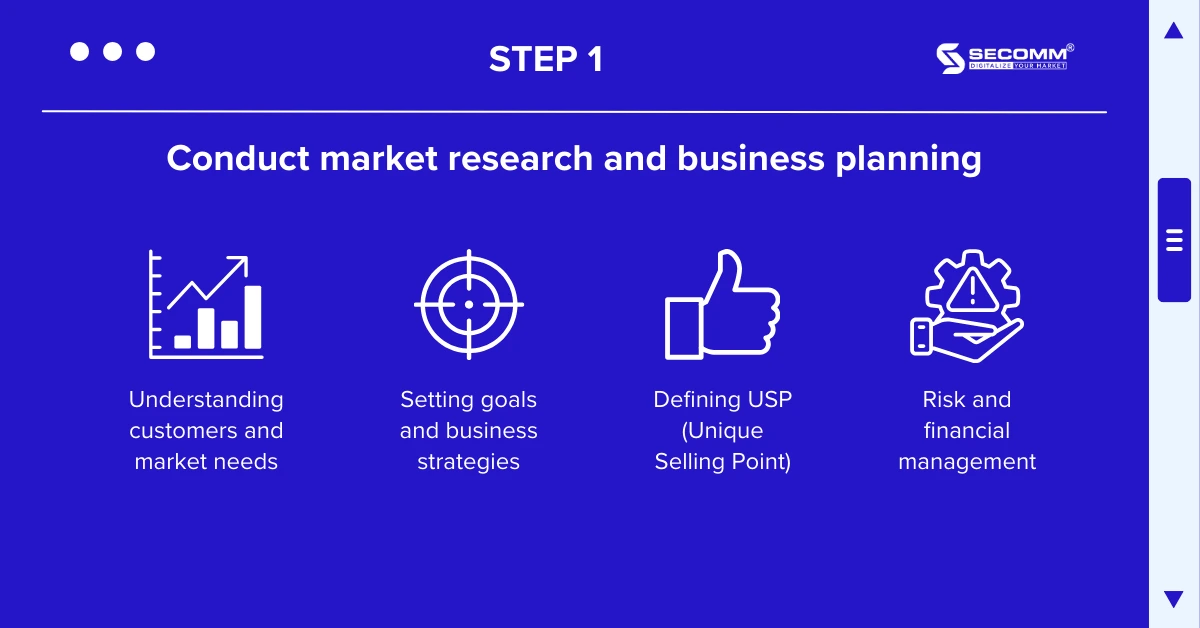
Here are some considerations for businesses when undertaking these activities:
- Understanding customers and market needs: Market research helps businesses gain a better understanding of their target customers, competitors, and industry-influencing factors. By exploring customer needs, preferences, and shopping behaviors, businesses can make strategic decisions to create the best online shopping experience and seize effective business opportunities.
- Setting goals and business strategies: Business planning helps companies identify specific objectives and devise strategies to achieve them. Companies need to define their core and secondary products/services, market access strategies, customer engagement approaches, and competitive value creation methods. A business plan helps create a detailed roadmap for how the business will build, develop, and operate its eCommerce marketplace.
- Defining USP (Unique Selling Point): Market research allows businesses to comprehend the strengths and weaknesses of their competitors. This helps businesses identify distinctive features and competitive value that their brand can provide to attract customers. Determining the USP enables businesses to leverage these elements in branding, marketing, and operational strategies to gain a competitive advantage in the eCommerce marketplace.
- Risk and financial management: Creating a financial plan and managing risks before embarking on the online marketplace development process is crucial. Businesses need to evaluate the financial resources and requirements for project implementation and establish long-term financial plans to ensure the sustainability of the business.
Select eCommerce platform
The eCommerce platform is a crucial element in the process of building an online marketplace. If the right choice is not made from the beginning, businesses may find themselves entangled in the whirlpool of technology when implementing their marketplace.
Typically, there are two types of eCommerce platforms for businesses to choose from: SaaS and Open Source.
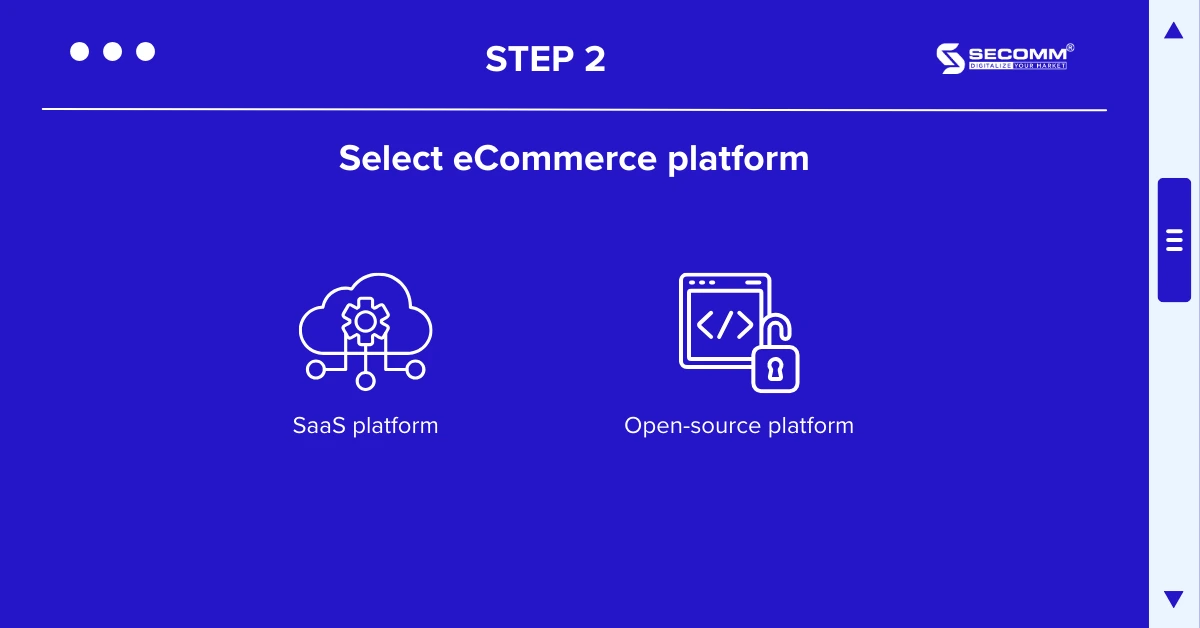
SaaS platform
SaaS (Software as a Service) eCommerce platforms are a software distribution model for building websites.
In this model, data is stored on the provider’s server, and the platform is responsible for handling technical aspects for businesses. Some popular SaaS platforms today include Haravan, Shopify, BigCommerce, and more.
- Pros: User-friendly, quick development time, high security, 24/7 customer support.
- Cons: Increasing development costs over time, limited customization, functionality, and scalability, and businesses may not own the source code and data.
Open-source platform
An Open Source platform, or open-source software, is software with publicly available source code that anyone can use for free. Open-source platforms are an optimal choice for businesses looking to develop complex eCommerce systems, especially tailored to the specific needs of an online marketplace.
Prominent examples of Open Source online marketplaces include Magento, WooCommerce (a plugin for WordPress), OpenCart, and more.
- Pros: These platforms offer high levels of customization and scalability, a wide range of additional features and utilities, and businesses have ownership of the source code and data.
- Cons: They are not very user-friendly, involve high development costs, and require extended deployment times.
Each platform type has its own set of advantages and disadvantages. Therefore, businesses should either have an in-house team or collaborate with an experienced and highly skilled eCommerce marketplace development agency to effectively advise on the selection, development, and operation of the chosen platform.
Outsource or build an in-house team
The initial decision regarding resource allocation for starting an eCommerce marketplace system has a profound impact on a company’s early business direction. Companies can choose to either collaborate with specialised development firms or establish their own in-house teams.
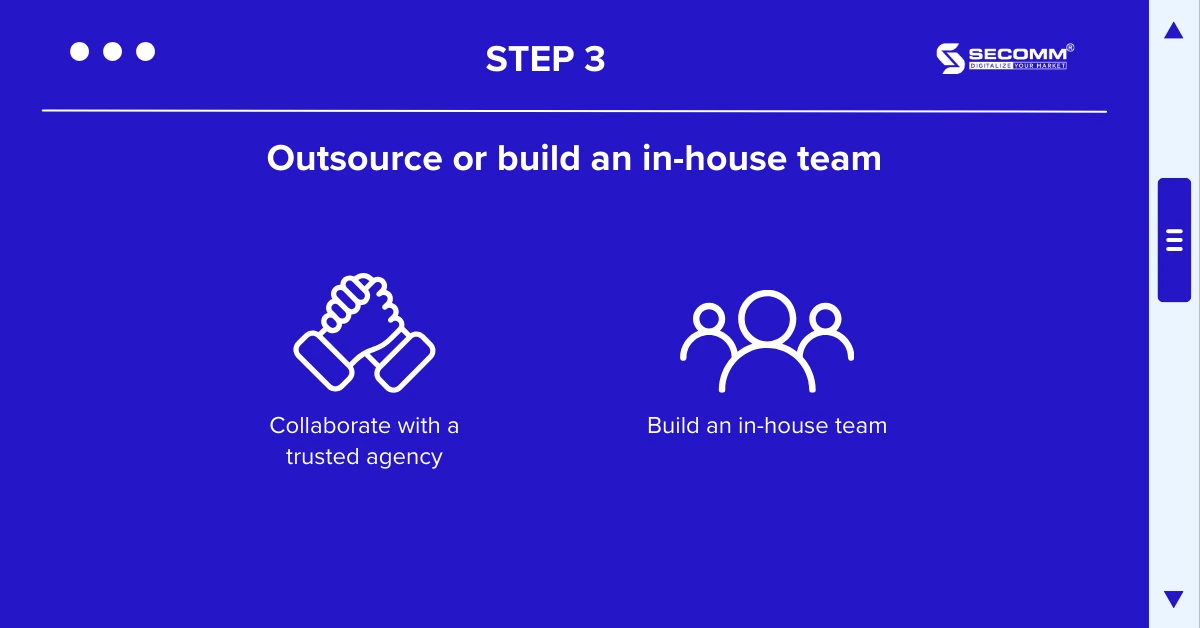
Opting for an in-house team entails investing time and budget into the recruitment and training of staff. However, it provides effective resource management, enabling businesses to adapt and develop the online marketplace system in alignment with their original vision.
Alternatively, when companies decide to seek external partners, they need to collaborate with various firms to identify the most reputable one. However, upon finding a partner with extensive practical experience in marketplaces across multiple platforms, businesses benefit from consultations and a multitude of solutions from diverse perspectives even before system development begins.
Moreover, these firms possess a wealth of experience in promptly addressing emerging issues during system development and operation. This not only ensures that the requirements are met as anticipated but also facilitates valuable knowledge and experience exchange among all parties involved.
Design UI/UX
The User Interface (UI) and User Experience (UX) are often considered two inseparable aspects in the process of designing the interface for an eCommerce marketplace.
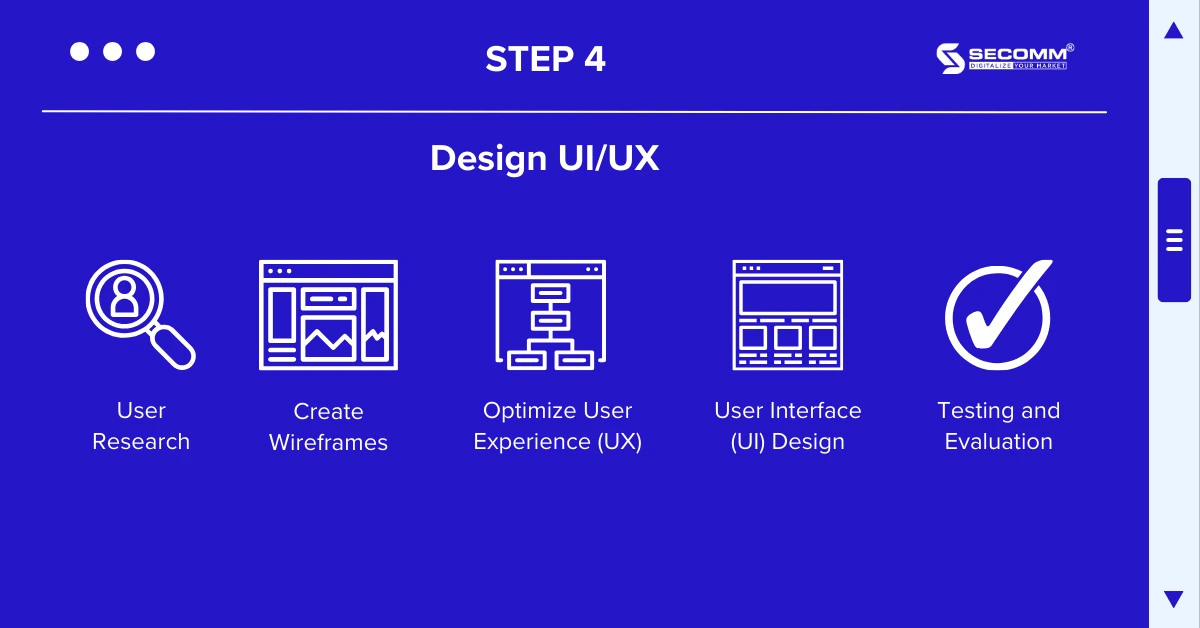
Here are the key steps in the UI/UX design process:
- User Research: Research and gain a deep understanding of the target user audience, including demographic information, behaviour, needs, and expectations. This helps the business identify important elements to focus on and design accordingly.
- Create Wireframes: Wireframes are simplified outlines of the website’s structure and layout, helping the business determine the placement of interface elements such as menus, buttons, images, and content containers. Wireframes provide an overview of the interface and assist in building the basic layout for the marketplace.
- Optimize User Experience (UX): Ensure the website is user-friendly, easy to navigate, and meets user needs, such as enhancing interactivity, mobile-friendliness, optimizing page loading speed, and more.
- User Interface (UI) Design: Create UI components such as buttons, menus, forms, images, and graphics that align with the brand. Make sure to use appropriate colors, fonts, and images to create a professional interface with a touch of the brand’s identity.
- Testing and Evaluation: After completing the UI/UX design, conduct testing with a user group or use testing tools to assess the effectiveness of the interface.
Design architecture and database
Starting from business requirements, the technical team will build the system architecture for the eCommerce marketplace based on the appropriate technology framework or platform. Various architectures can be used, such as three-tier architecture, microservices architecture, hybrid architecture, headless architecture, etc. Each type of architecture has its own advantages and limitations, so businesses need to carefully consider and work with experts on the team or partners to choose the most suitable system architecture for each stage.
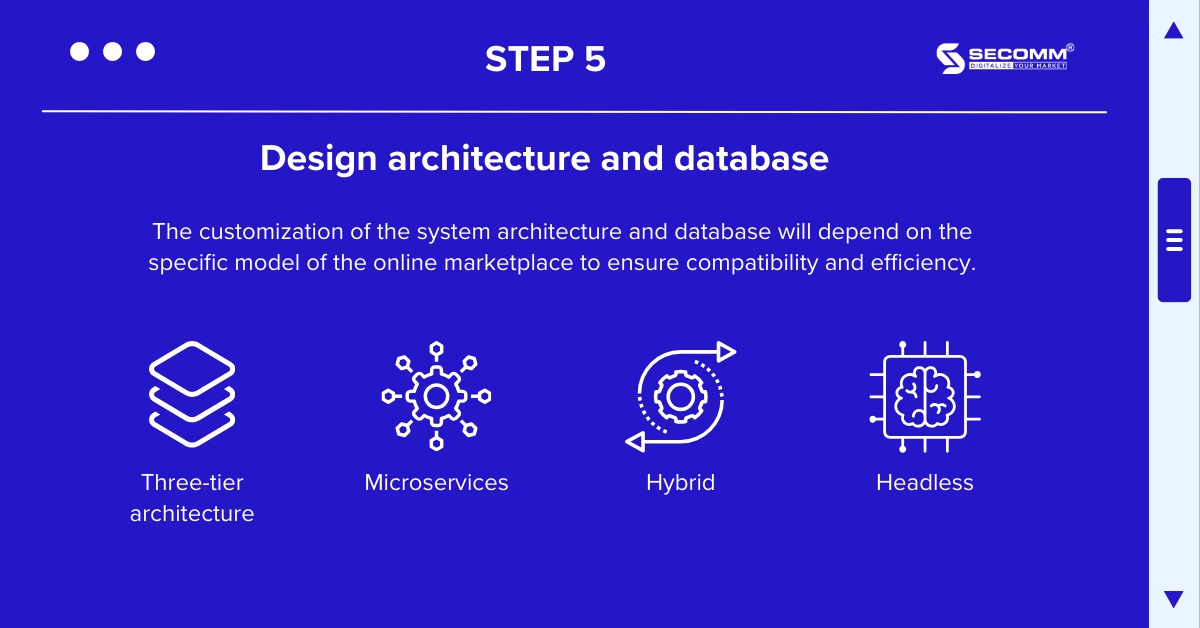
Another equally important next step is to establish security and data management. Businesses need to define security measures to protect user data, payment information, and other critical data. Ensure that data is encrypted and transmitted securely via an SSL connection. Implement data protection measures such as access control, user authentication, data encryption, and data integrity checks.
Depending on the operating model of the marketplace, system and database design may need to be customized to be suitable and effective.
Develop functional system
After completing the essential functional systems, businesses should continue to develop specific features for their online marketplace, such as:
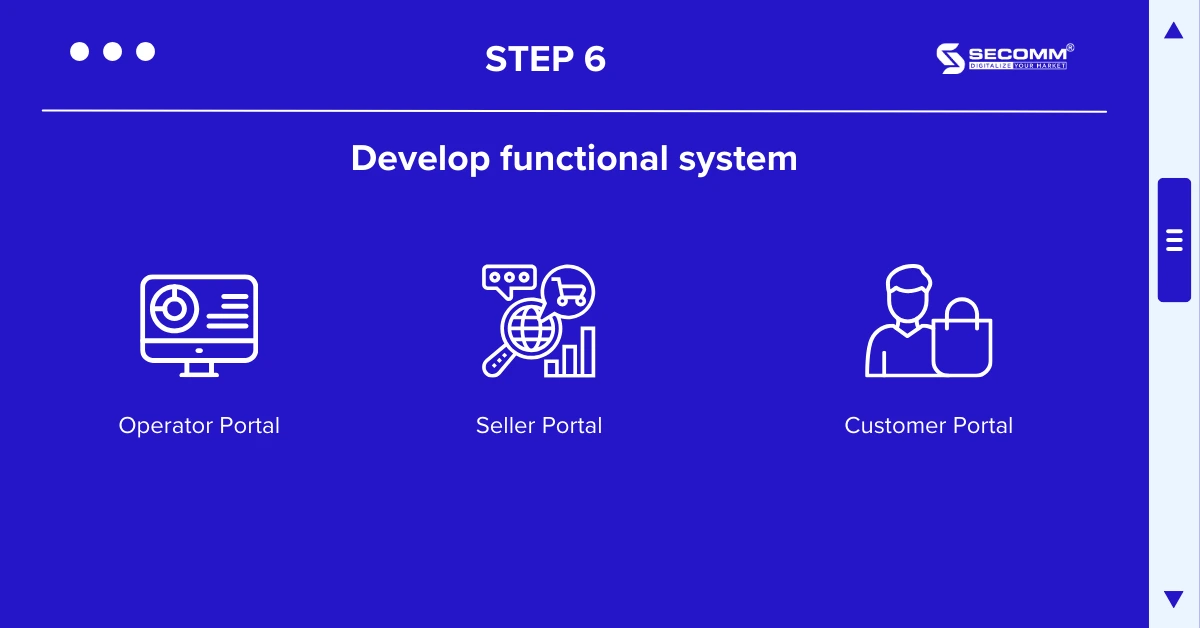
Operator Portal: Full control of platform information, including seller management, product categorization, customer segments, supply chain management, ad content control, and more.
- User Groups and Administrative Levels: Categorizing users into various groups and granting different permissions to different users.
- Supply Chain Management: Warehouse and inventory management, assisting sellers in order fulfilment by routing orders, and more.
- Marketing Tools: A range of tools support marketing strategies, including search advertising, live streaming, gamification, and more.
- User Experience Personalization: The ability to display personalized products such as favorites, similar products, past purchases, and facilitate order communication with sellers.
- Analysis and Reporting: Analyzing and measuring the performance of the online marketplace to develop future business strategies.
- Integration with Other Systems: Seamless integration with external systems.
Seller Portal: Sellers self-manage their presence in the marketplace, including product listings, orders, and activities, etc
- Category and Product Management: Add, edit, delete product categories and products within categories; manage product attributes and variations (color, size, etc.); manage inventory quantities.
- Content Management: Create and optimize content, including text, images, videos, banners, widgets, templates, branding, messaging, and more.
- Order Management: View order lists and their statuses. Track shipments and deliveries. Update order status (processing, delivered, canceled, etc.).
- Advertising and Promotions: Display advertisements, banners, promotions on the website. Manage discount codes, promotional programs, and more.
- Payment Integration and Transaction Processing: Integrate payment gateways for online payment processing. Confirm and track payment transactions.
Customer Portal: Allow users to perform and manage basic information such as phone numbers, email addresses, delivery addresses, adjust payment options, request quotes, manage shopping lists, check order status, etc.
- Account Registration and Management: Register new user accounts (buyers and sellers), log in, and manage personal information, delivery addresses, payment methods, etc.
- Product Search and Viewing: Search for products by keywords, categories, brands, etc. View detailed product information, including images, descriptions, prices, ratings, and more.
- Cart and Checkout: Add products to the cart; edit product quantities, remove products from the cart, calculate and display the total amount in the cart; select payment methods; enter payment information and delivery address; confirm and place orders.
- Reviews and Comments: Rate and write reviews about products; view reviews and comments from other users.
- Customer Support: Provide contact channels for customers to ask questions, request assistance; offer real-time support through direct chat, email, phone, and more.
Q/C Testing
Whether you’re building an in-house team or enlisting the services of external development agencies, the quality testing phase of a project holds immense significance. This critical stage is where businesses validate that the system functions as expected and complies with the initial requirements.
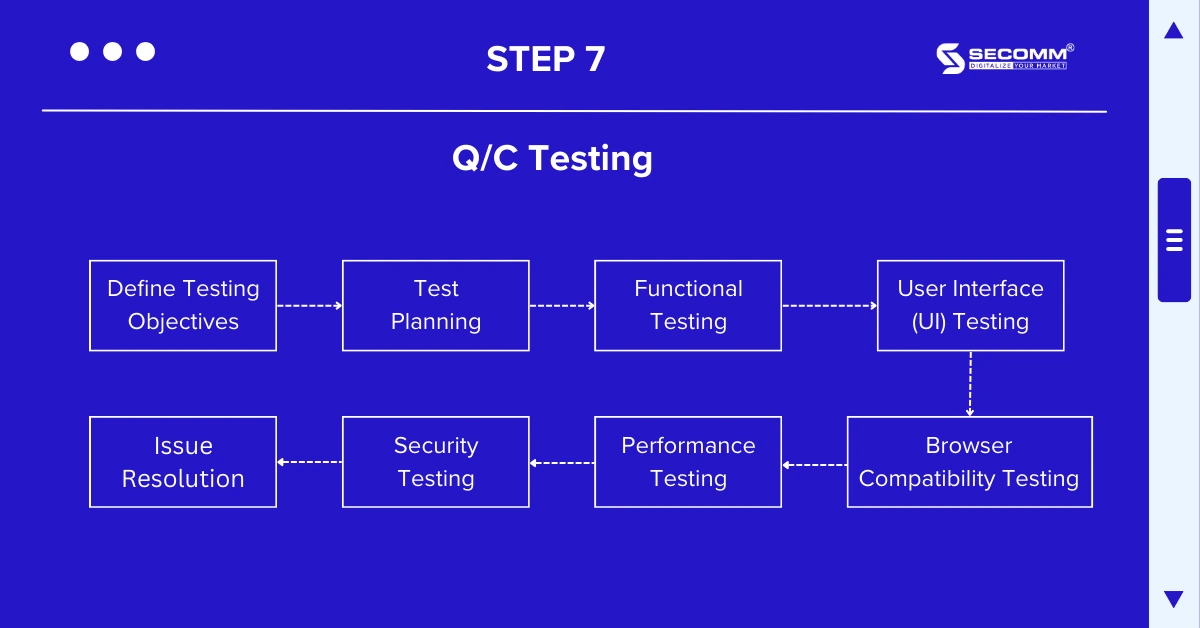
Step 1: Define Testing Objectives
Identify the objectives and scope of the testing process. Set specific criteria and requirements that the business wants to verify to ensure the platform operates accurately and meets the specified requirements.
Step 2: Test Planning
Determine a detailed test plan, including test cases, scenarios, and data. Identify the resources, timeline, and scope of the testing phases.
Step 3: Functional Testing
Verify all website functions to ensure they are working correctly as expected. If the business’s website supports multiple languages and regions, it should also verify compatibility and display of each feature in different geographical areas.
Step 4: User Interface (UI) Testing
Ensure the interface is designed beautifully and user-friendly. Evaluate information display, buttons, links, and user experience on various devices, including mobile and tablet.
Step 5: Browser Compatibility Testing
Test the website on popular browsers such as Google Chrome, Mozilla Firefox, Safari, and Microsoft Edge to ensure compatibility and correct display on all platforms.
Step 6: Performance Testing
Assess website performance, including page load speed, concurrent processing, and scalability. Ensure the website operates smoothly and can handle the expected traffic load.
Step 7: Security Testing
Examine the platform’s security by testing intrusion potential, data security, and user authentication. Verify security methods such as SSL, data encryption, and security certificates.
Step 8: Issue Resolution
Document and track any errors and issues that arise during testing. Identify the root causes, rectify the errors, and retest until the testing process is approved, and the entire system is ready for go-live and operation.
Golive
Go-live is the final stage in the process of starting an eCommerce marketplace when the system is officially launched and becomes operational.
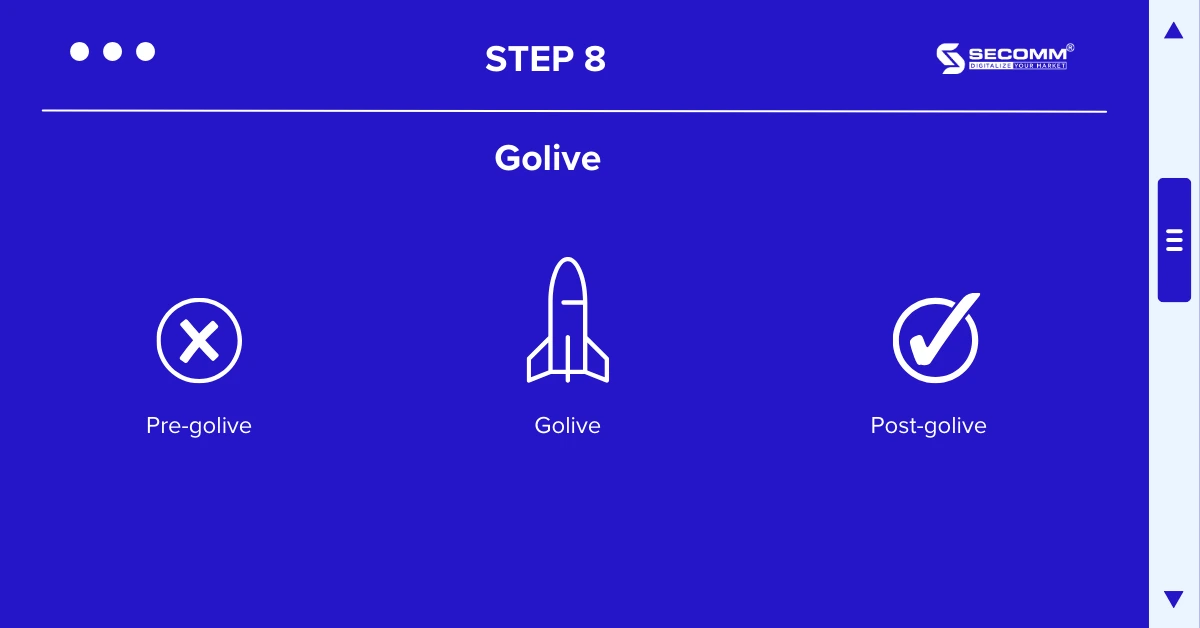
To ensure a successful go-live process, businesses should prepare a checklist known as the Go-live checklist. This is a list of tasks that the deployment team needs to perform to prepare the system for go-live. The checklist includes task items, responsible individuals, status, and how they affect the system.
Pre-golive
- Prepare the Production environment and configure the domain.
- Ensure that the entire source code of the go-live preparation system is the final version of the quality testing process.
- Data migration: Execute the data migration process from the old system to the new system using the established method. Then, verify the data after migration to ensure the integrity and accuracy of data in the new system.
- Content update: Review website content, including text, images, videos, and other materials. Ensure that the content is displayed accurately without spelling or formatting error
- Backup all website data to ensure safety and data recovery capabilities when needed
- Identify and prepare customer guide and support materials
Finally Golive
- Implement the transition process from the development environment to the actual production environment.
- Monitor website traffic and activities immediately after golive.
- Ensure system stability and performance throughout the go-live process.
Post-golive
- Monitor and analyze user feedback
- Address issues and problems that arise post-go-live
- Ensure the system’s stability and performance over an extended period after golive
- Ensure compatibility of integrations with external systems
- Train employees and managers to use and maintain the system effectively
Continuously update & develop features
Regularly updating the system is important for businesses to adapt to the ever-changing customer needs, improve customer experience, stay abreast of emerging technology trends, enhance competitiveness, and more. Moreover, continuous bug fixes and security patch updates enhance the brand’s credibility, safeguard users from internet threats, and so on.
Moreover, the development of new features empowers businesses to capitalize on market opportunities and scale their operations more professionally. For example, after a period of operation and accumulating a specific customer base, businesses can introduce features tailored to loyal customers.
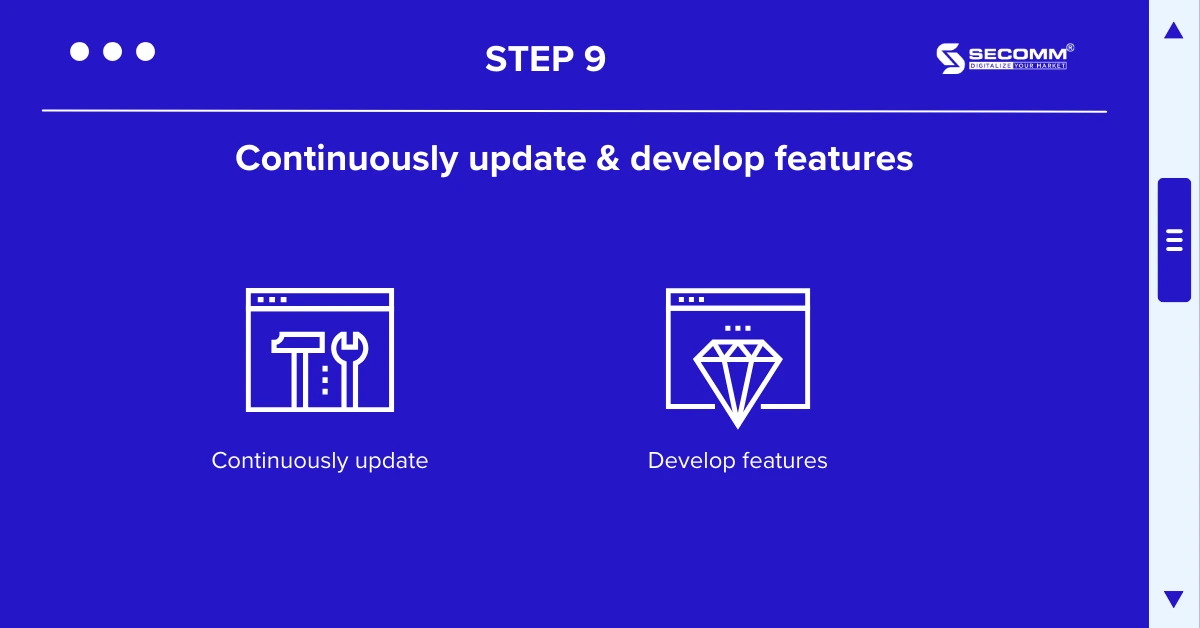
Running a thriving marketplace involves a multitude of factors, such as the business model, financial capabilities, and building strategic partnerships with diverse brands. However, a well-functioning eCommerce platform with high performance plays a vital role in the path to success. The journey of marketplace development is anything but straightforward. It requires substantial investments of time and resources for thorough research and the seamless alignment of solutions with each development phase.
Recognizing the challenges and hurdles that businesses face during the process of starting their eCommerce marketplace, feel free to contact or call SECOMM directly at (02871089908) for a free consultation.
 2
2

 13,310
13,310

 0
0

 1
1
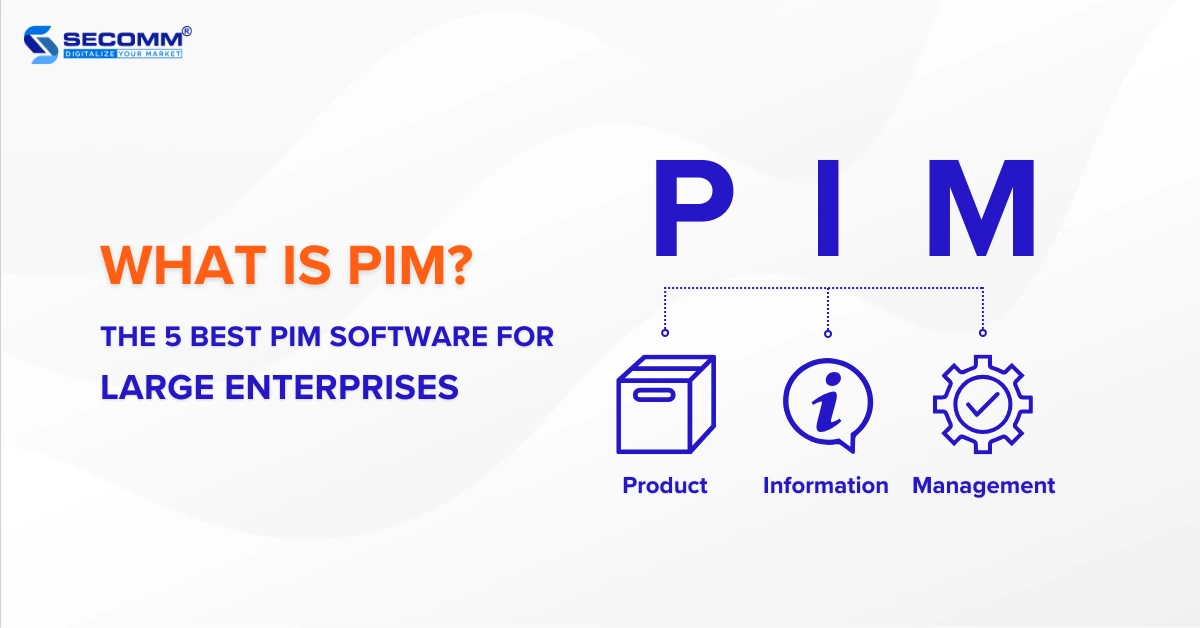
WHAT IS PIM? THE 5 BEST PIM SOFTWARE FOR LARGE ENTERPRISES
Table of Contents
PIM is an essential management system that helps synchronize product information across various systems like ERP, POS, CRM, SCM, etc., and a brand’s global sales channels. It’s considered the powerful ‘right hand’ of large corporations for comprehensive information management.
What is PIM?
PIM or Product Information Management is a system or platform used to collect, organize and manage detailed product information for businesses. PIM includes information such as product descriptions, images, prices, product attributes, customer ratings and reviews.
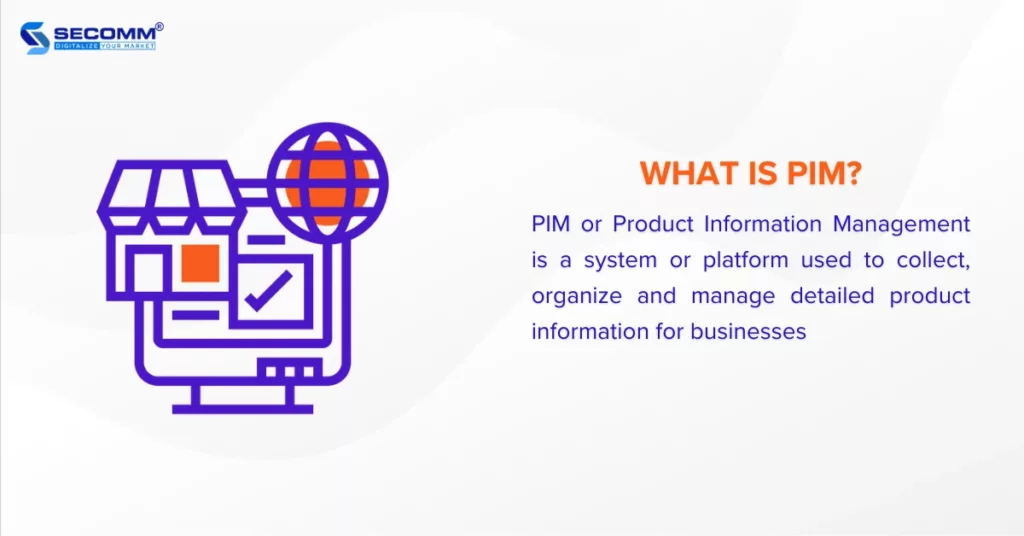
PIM systems often integrate data from ERP, CRM, POS, and other business management systems related to a company’s products. Once integrated, shared data.
Related article: What is POS? Why your eCommerce business need it?
Benefits of using PIM software
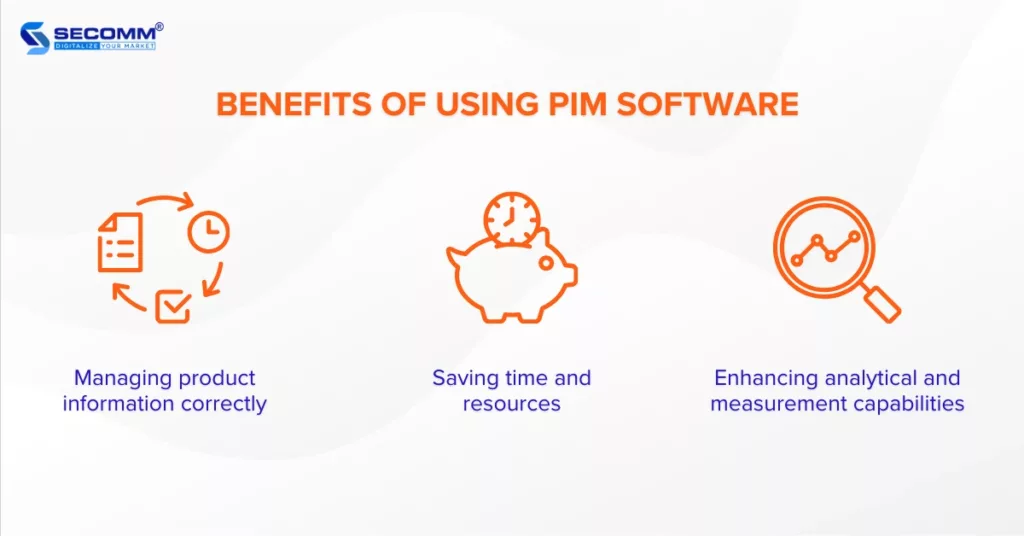
Managing product information correctly
PIM software allows businesses to accurately and consistently collect, organize, and manage product information. This ensures that product information is updated correctly and comprehensively across all sales channels, from eCommerce websites, mobile apps, and social media to marketplaces like Shopee, Lazada, Tiki, Sendo, Amazon, and more. When accurate product information is provided to customers, businesses can enhance trust and reputation for their brand.
Saving time and resources
A PIM system automates the processes of data entry, processing, and product information distribution. This saves time and effort for employees while reducing the risk of errors compared to manual data entry. With more efficient workflows in place, PIM allows employees to focus on other, more critical tasks.
Enhancing analytical and measurement capabilities
PIM software enables efficient analysis and measurement of product information. By monitoring, evaluation, and data analysis of product details, businesses can gain insights into the performance of marketing campaigns, consumer trends, customer behaviors, and more. Therefore, this empowers them to make more informed and effective business decisions for the future.
Top 5 PIM software for Vietnamese businesses
Akeneo
Akeneo is a widely embraced PIM platform known for its broad range of services, including open-source PIM and cloud-based PIM systems, etc.
Currently, Akeneo offers three primary PIM solution packages:
- Community Edition: Free of charge – Designed for small and medium-sized enterprises looking to efficiently manage and distribute product information at a minimal cost.
- Growth Edition: Starting at $25,000 per year – Tailored for mid-sized companies aiming to unlock the potential of product information management.
- Enterprise Edition: Pricing upon request – Catered to large corporations in need of a specialized PIM system.
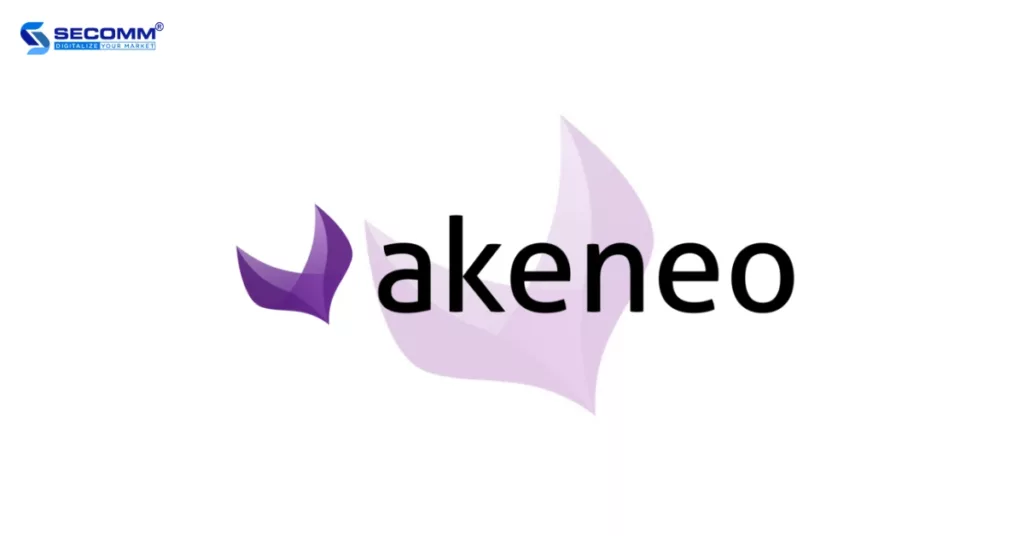
Pros:
- Effective product information management: Akeneo enables businesses to easily manage product information, from data input to classification and organization, creating a precise and consistent source of product data.
- High integration: Akeneo seamlessly integrates with other systems such as ERP, CRM, POS, and eCommerce platforms (Magento, Shopify, WooCommerce, etc).
- Scalability: Akeneo provides APIs and an open development framework, allowing businesses to expand and customize the PIM platform based on their specific needs.
Cons:
- High costs: The cost of using Akeneo is relatively high compared to other PIM systems.
- Complexity: Akeneo has some highly complex features that require time and expertise to effectively implement. Moreover, training employees and managing the Akeneo PIM system may demand a certain investment.
- Customer support: Some users find that Akeneo’s customer support can only address general knowledge and may not be able to resolve technical issues or address industry-specific concerns for each brand.
1WorldSync
1WorldSync is a company that specializes in providing solutions for managing product information and synchronizing product data for large enterprises. Their platform is built on a global network for product data synchronization, connecting suppliers, retailers, distributors, and various stakeholders worldwide.
1WorldSync currently offers four customizable solutions tailored to the needs of large enterprises:
- Base: Geared towards businesses looking for quick and efficient global product content management.
- Plus: Leverages product content to boost marketing strategies and sales initiatives, and ensures compliance with transparent information policies.
- Pro: Delivers a visual data solution along with premium support services for setting up and managing high-quality product portfolios.
- Premier: Enhances brand visibility in the eCommerce market through carefully curated. high-quality content.
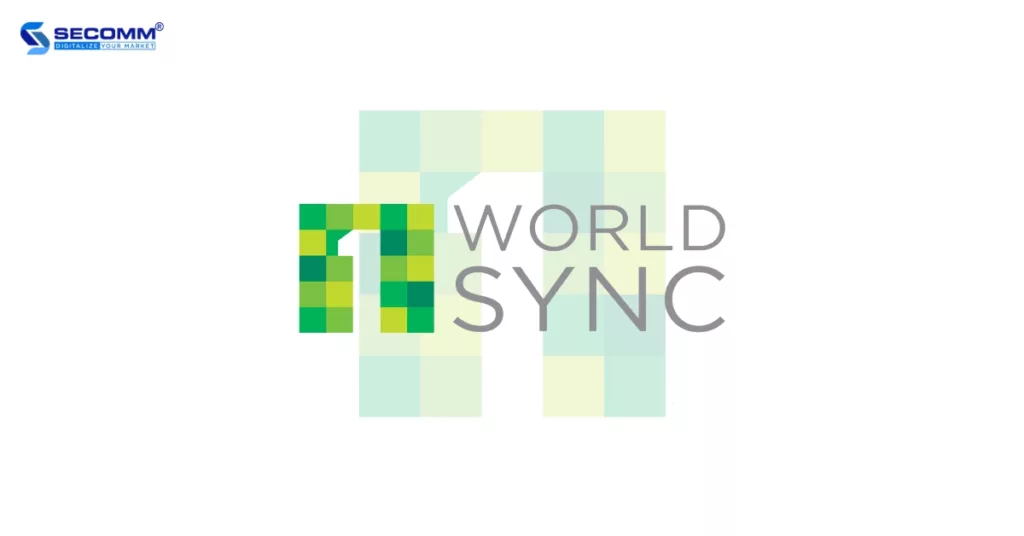
Pros:
- Comprehensive product information management: 1WorldSync offers a robust platform for managing product information, including images, descriptions, technical attributes, barcodes, and other details. This helps businesses efficiently maintain and update product information.
- Global product data synchronization: 1WorldSync establishes a global network for product data synchronization, enabling businesses to connect and share product information with partners and customers worldwide. This network ensures the consistency of product information across various sales channels.
- Enhancing customer experience: By providing detailed, accurate, and consistent product information across sales channels, 1WorldSync improves the shopping experience and product evaluations for customers.
Cons:
- High costs: Since 1WorldSync is a PIM system designed for each business, the cost of using 1WorldSync can be relatively high
- Complex regulations and standards: Businesses must ensure that managing and sharing product information on 1WorldSync complies with legal regulations and standards, such as privacy rights, data protection, and industry standards.
- Complex and user-unfiendly: The interface and workflow on 1WorldSync can be relatively complex and challenging to understand for new users. It requires time and resources to train employees and adapt to the new system.
Sales Layer
Sales Layer is a PIM platform tailored for efficient product data management across medium and large businesses on a global scale. This PIM solution is designed with customization in mind, and its pricing varies depending on specific business needs, with a starting cost of $1,000 per month.
Sales Layer currently offers several solution packages, including:
- Premium: An ideal choice for businesses seeking a swift and sustainable PIM system implementation.
- Enterprise: A comprehensive solution providing all the essential features for elevating a medium-sized business into a global enterprise.
- Enterprise Plus: A specialized PIM solution adept at effortlessly handling intricate data challenges within businesses.
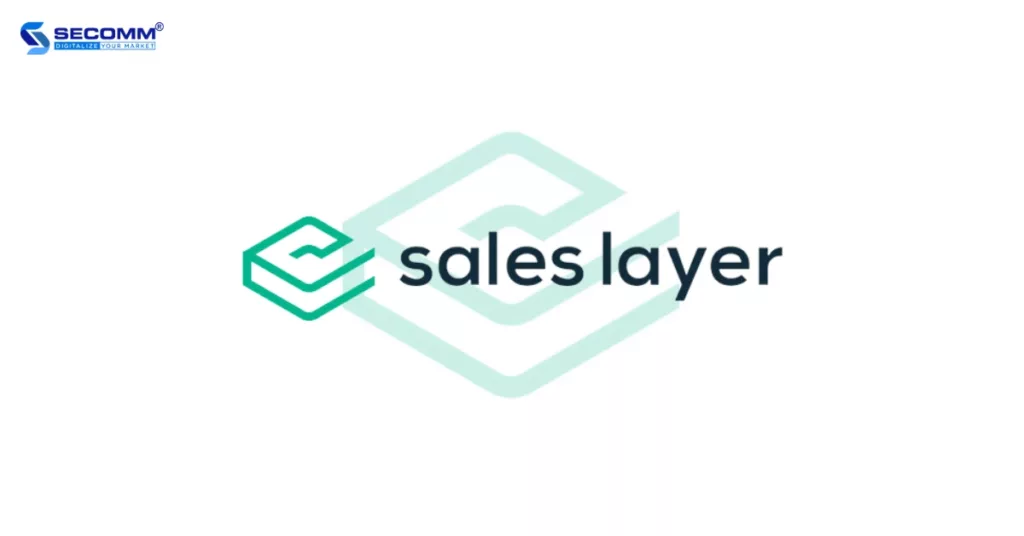
Pros:
- Centralized product information management: The Sales Layer provides a centralized platform for managing product information, ensuring data consistency.
- Workflow and process control: Sales Layer offers tools for managing workflows and work processes to organize and manage product information updates and approvals, guaranteeing data quality.
- Rapid information retrieval and search: The Sales Layer incorporates algorithms that enable swift retrieval and searching of information to meet specific user demands.
Cons:
- Complex implementation process: One of the drawbacks of the Sales Layer is its relatively intricate deployment and initial configuration, especially for businesses with existing and large-scale systems.
- Specialized training requirements: Sales Layer may necessitate a certain amount of training time to become familiar with the interface and functionalities of this PIM system. Training employees and ensuring proficiency in using the Sales Layer can be time-consuming and resource-intensive.
- Limited technical support: In the event of issues or technical problems, support from the Sales Layer may not fully meet expectations or provide a quick resolution.
Salsify
Salsify is a cloud-based product information management (PIM) platform that offers businesses a solution to efficiently manage and distribute product information across various sales channels. Salsify functions as a software a service (SaaS) application, with usage costs tailored to each business, typically ranging from $2,000 to $5,000 per month.
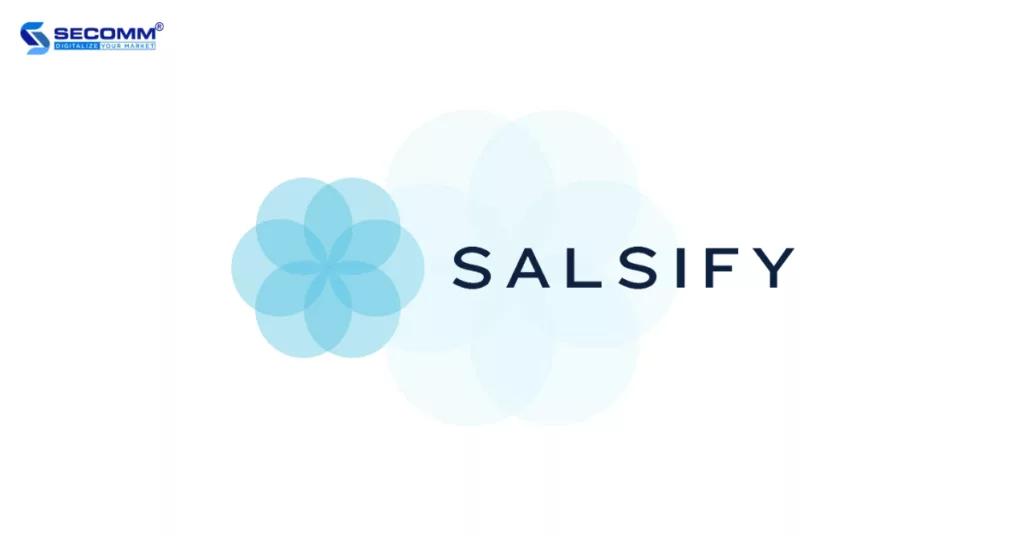
Pros:
- Comprehensive workflow management: Salsify offers the capacity to manage workflow procedures, permitting the adaptation, monitoring, and endorsement of alterations in product data, guaranteeing accuracy and proficient control of work processes.
- Multilingual and multiregional compatibility: Salsify backs the management of product data in several languages and geographic regions, facilitating effective expansion into international markets.
- Seamless integration with various systems: Salsify permits integration with diverse business management systems and tools like ERP, CRM, SCM, POS, and more, streamlining business processes.
Cons:
- High deployment and maintenance costs: The initial deployment and ongoing maintenance expenses for a PIM system on Salsify can be relatively high compared to other PIM systems. This might impact a business’s long-term financial resources.
- Initial data input challenges: Importing initial product data and information into Salsify can be challenging and time-consuming, particularly when dealing with a large volume of product details from various sources. This process requires meticulous attention to ensure accuracy.
- Complexity in usage: Salsify offers a wide array of features and product management capabilities, but it also comes with a corresponding level of of complexity. Learning how to use Salsify effectively may necessitate time spent delving into guides and documentation.
inRiver
inRiver is a PIM system developed to efficiently manage and distribute product information across various sales channels and different eCommerce platforms such as Adobe Commerce, Shopify, WooCommerce, BigCommerce, etc. The cost of using inRiver is approximately $1,000 per month.
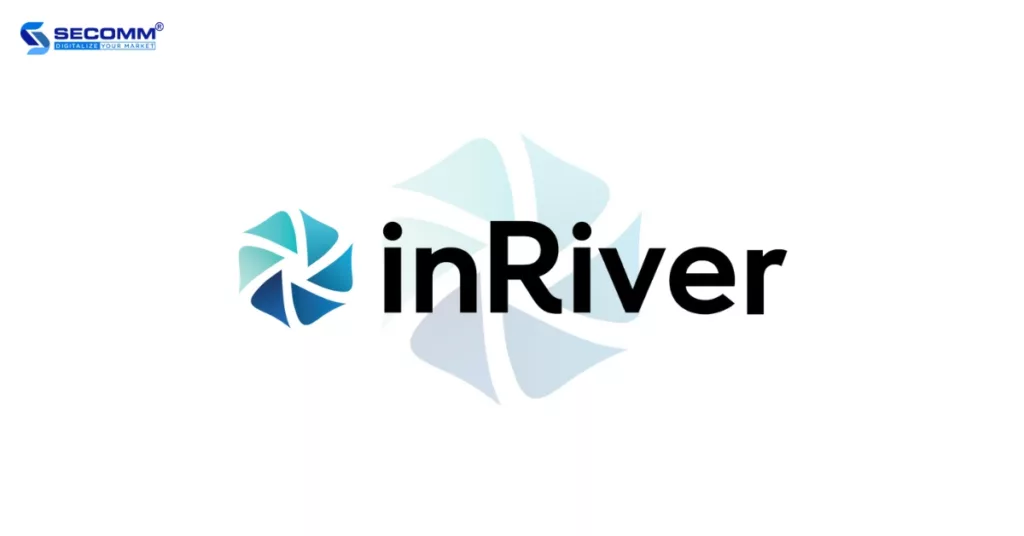
Pros:
- Product variations management: inRiver supports the management of information regarding product variations, including color options, sizes, styles, and other details. inRiver enables comprehensive and diverse product information display, effectively meeting customer needs.
- Integration with DAM support: inRiver supports integration with Digital Asset Management (DAM) systems, allowing the management and linkage of digital assets such as images, videos, and product-related documents. This enhances the management and distribution of multimedia content related to products.
- High scalability: inRiver is designed to expand its capabilities according to a business’s specific requirements, catering to diverse business needs and objectives.
Cons:
- Complex user interface: Some users may find it challenging to navigate River’s user interface due to its relatively complex nature, requiring training to become familiar with and use effectively.
- Resource-intensive PIM system implementation: Implementing and maintaining inRiver demands a highly skilled workforce.
- Complex customization capabilities: Customizing and integrating inRiver with existing systems and workflows can be intricate and require technical expertise. This can result in difficulties and increased costs associated with system integration and customization.
Above is a summary of the top 5 PIM software options tailored for large-scale businesses, each with its own unique set of advantages and disadvantages. Depending on the requirements for PIM system development and budget considerations, companies can explore and select the most appropriate PIM solution.
Get in touch with SECOMM for more information!
 2
2

 15,059
15,059

 0
0

 1
1
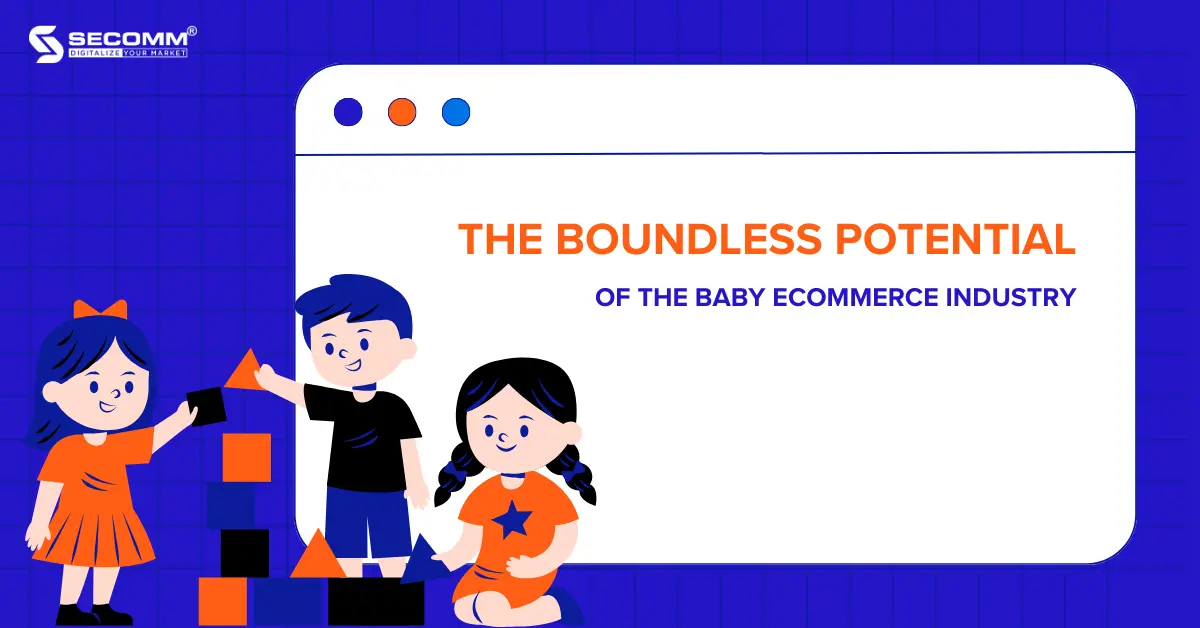
THE BOUNDLESS POTENTIAL OF THE BABY ECOMMERCE INDUSTRY
Table of Contents
Recent statistics indicate that Vietnam has a population of 24.7 million children and roughly 24.2 million women of childbearing age. Moreover, with an annual birth rate of approximately 1.5 million children, Vietnam stands out as a prospective market for the baby industry. As a result, it comes as no surprise that many baby brands have been progressively establishing and expanding their stores year by year. Additionally, the industry benefits from the momentum created by the pandemic and the evolving trend of transitioning from offline to online shopping.
3 reasons for baby brands to get on board with eCommerce
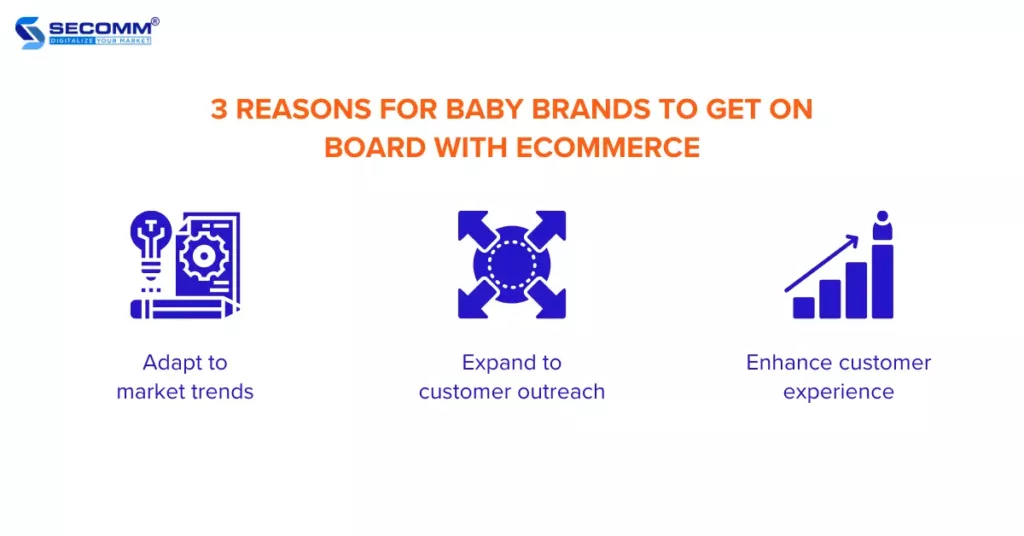
Adapt to market trends
While offline businesses experienced a downturn during the period of social distancing, leading to the contraction of many retail chains, online commerce has been flourishing. Even as society progresses towards a “reopening” phase in the post-pandemic world, the preference for online shopping remains strong. The demand for various products, spanning from timepieces, cosmetics, and groceries, to mom-and-baby essentials, on eCommerce websites and marketplaces continues to steadily surge.
Hence, the solution for Baby enterprises to align with market trends involves the implementation of an O2O (Online to Offline) model. This approach integrates offline sales (leveraging existing physical store networks) with online channels. Among these channels, establishing an eCommerce website is paramount for businesses to promptly deploy sales and marketing strategies, attracting customers and preventing potential loss to competitors.
Expand to customer outreach
When physical stores are constrained by location, staffing, and operating hours, online stores remain open and accessible from anywhere worldwide. This offers Baby businesses the opportunity to extend their reach to a large pool of potential customers on the Internet.
By implementing effective strategies like optimizing SEO, running advertising campaigns, or leveraging social media, Baby businesses can swiftly boost their brand recognition, attract a diverse clientele to their eCommerce website, and facilitate round-the-clock product sales.
Top Vietnamese Baby eCommerce sites
Con Cung
Launched in 2011, the Con Cung retail chain quickly gained recognition and became the top choice for many Vietnamese families to shop for mom-and-baby products, offering a catalog of over 2000 items. In 2016, with the investments received, Con Cung significantly expanded its store chain from 100 in 2016 to 400 in 2020 (currently at 700 stores).
Recognizing the evolving consumer landscape with a shift from offline to online shopping, the brand proactively intensified its online retail efforts through its eCommerce website and mobile app, enriching the shopping experience for its customers. With this in mind, Con Cung has set an ambitious target of reaching 1 billion USD in revenue by 2023 and aims to capture a 30% market share, envisioning a 2 billion USD in revenue by 2025, with at least 30% coming from eCommerce.
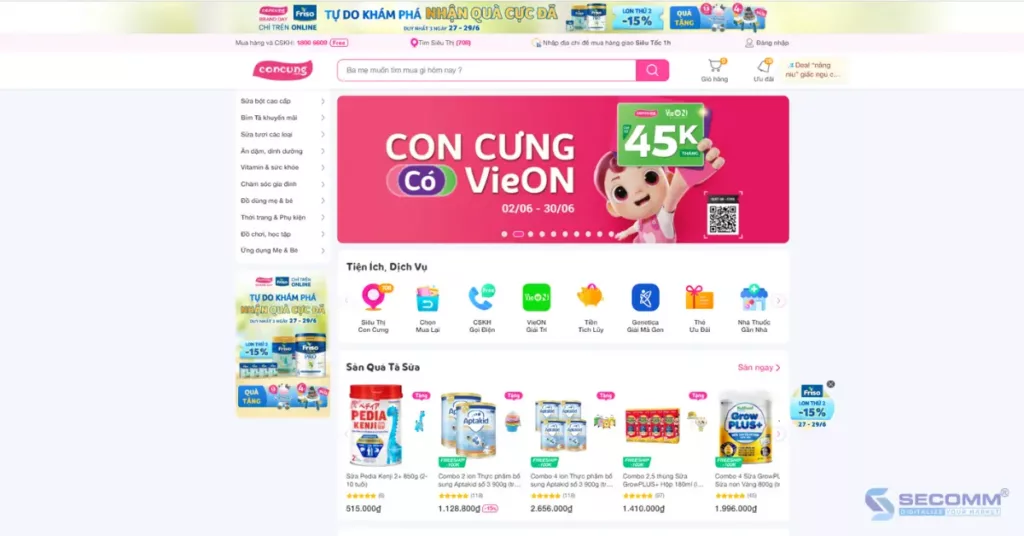
Therefore, in recent times, Con Cung has made an effort to attract customers to its eCommerce website. They consistently promote various enticing programs, including “Monday Freeship Day” and the “Stuffed Animal Fiesta for 99K.”
Additionally, Con Cung has kept pace with the Mobile Commerce trend by introducing the ‘Con Cung’ mobile app, available on both App Store and Google Play. This app has garnered highly positive user feedback and currently ranks 24th in the Shopping category.
Particularly, this retailer’s delivery service has earned high praise from customers. With a network of over 700 stores across the country. Con Cung offers lighting-fast 1-hour delivery through its “Pink Warrior” delivery team. Beyond partnering with third-party delivery providers such as Grab Expres, Giao Hang Nhanh, Giao Hang Tiet Kiem, the brand also maintains a dedicated team of delivery warriors who cater to customer’s specific time preferences.
Kids Plaza
Established in 2009, Kids Plaza offers more than 10,000 mom-and-baby products, certified safe for babies from top-notch brands in Vietnam and around the world. In the competitive race, Kids Plaza has consistently fortified its position by embracing the O2O business model.
This strategy involves harmoniously blending traditional in-store retail with a variety of online channels, including a dedicated website, eCommerce platforms, Zalo stores, mobile applications, and more. Kids Plaza has rolled out enticing customer loyalty programs such as Kicoin, the convenient Freeship policy covering a 7km radius for all purchasing channels, and exclusive discounts for expectant mothers when shopping in brick-and-mortar stores.
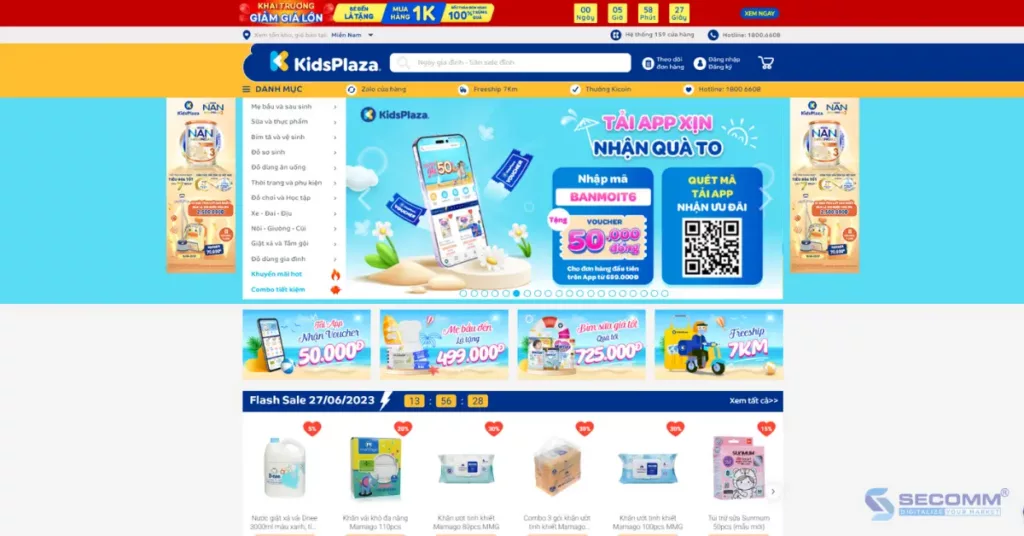
Customers aren’t only satisfied by the seamless shopping experience, affordable prices, and appealing promotional offers but also by exceptional product quality. All products undergo strict quality control before being officially offered for sale to provide the best experience and service, ensuring customers’ peace of mind while shopping.
Kids Plaza also demonstrates its care for expectant moms and babies through programs like the free antenatal classes, which have been conducted for over a decade and have successfully aided numerous mothers during their childbirth journeys. Moreover, the brand hosts annual community events and maintains an insightful knowledge-sharing blog to help elevate health awareness among both mothers and children.
Bibo Mart
The mom-and-baby retail chain, Bibo Mart, was established in 2006 and specializes in offering a wide range of products for mothers and babies, including maternity clothing, diapers, formula, and strollers. Similar to Con Cung and Kids Plaza, Bibo Mart hasn’t lagged behind in the eCommerce race. After years of operation and growth, Bibo Mart has identified a new vision for investing in an eCommerce system to meet the online shopping needs of its customers.
Currently, online sales at Bibo Mart account for 14.5% of the total revenue and are expected to increase to over 30% in the next five years. Beyond frequently offering attractive incentives to encourage customers to shop on their website and app, Bibo Mart has introduced a loyalty program with four tiers: Loyal, Silver, Gold, and Diamond. Customers are assigned membership ranks based on their specified spending levels and earn BiXu points for continued exclusive benefits.
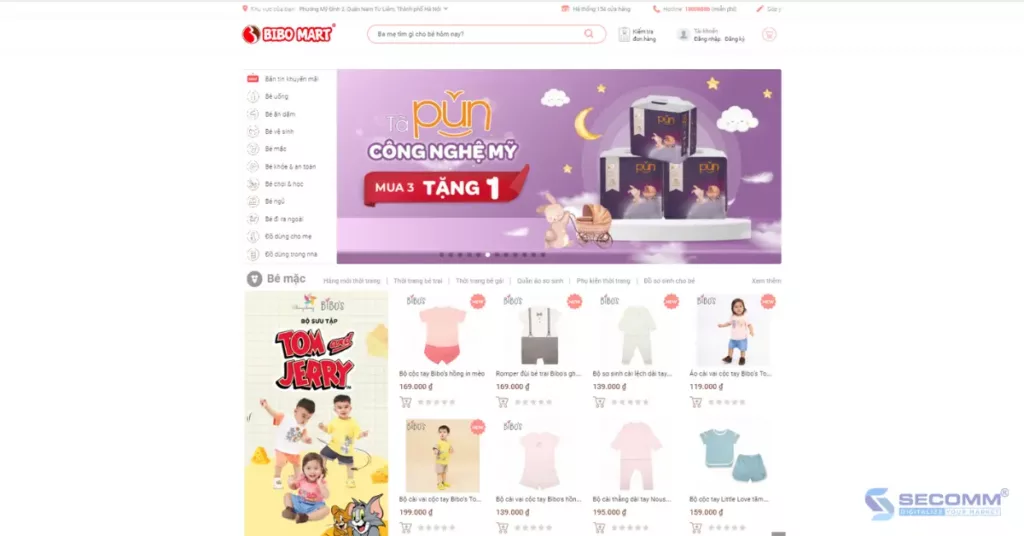
Notably, customers can use a QR code on the app to scan for product info or accumulate points when shopping in physical stores. Bibo Mart also demonstrates its commitment to its customers by providing maternal and childcare knowledge through blogs and free online seminars and classes for mothers as well as those caring for their health during pregnancy and postpartum.
The potential of the Baby eCommerce market in Vietnam is enormous, and the success of major players like Con Cung, Kids Plaza, and Bibo Mart has encouraged the participation of other businesses. However, for a Baby eCommerce business to succeed, it’s important to build a comprehensive and feasible strategy, both short-term and long-term. Particularly, eCommerce websites and mobile apps are the two crucial keys that determine the success or failure of a business in the eCommerce race.
Having partnered with many businesses in implementing eCommerce websites and apps over the years, SECOMM has accumulated practical experience to assist businesses in swift and effective deployment.
Feel free to contact us or call SECOMM’s hotline at (02871089908) for a free consultation.
 2
2

 12,782
12,782

 0
0

 1
1
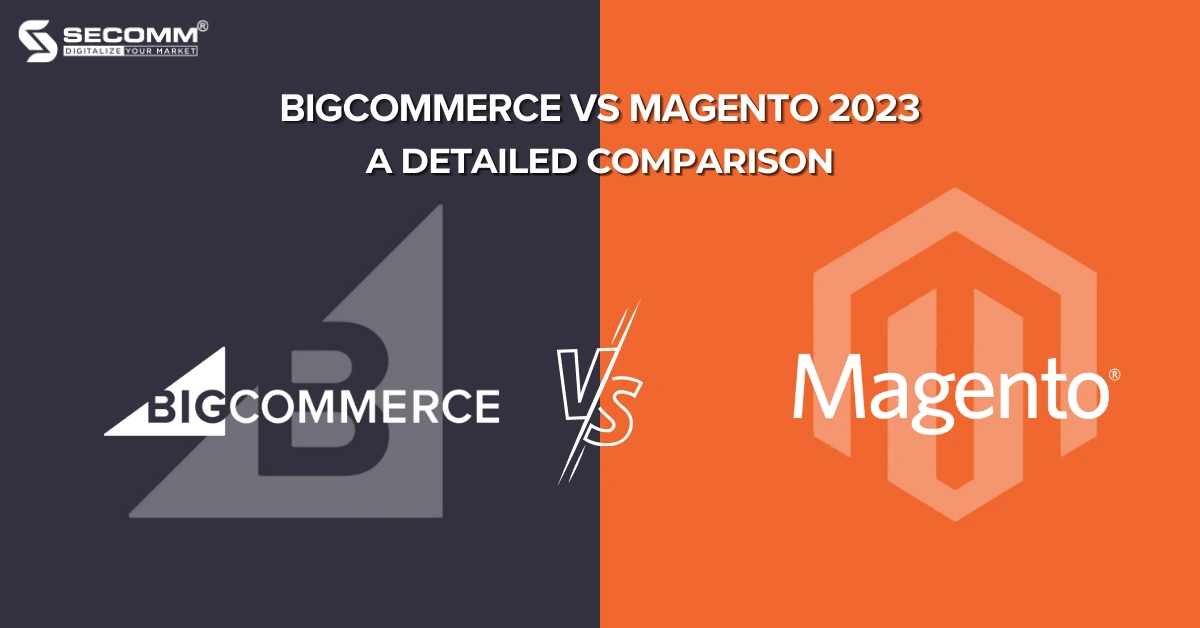
BIGCOMMERCE VS MAGENTO 2023: A DETAILED COMPARISON
Table of Contents
BigCommerce and Magento are trusted names representing two types of eCommerce platforms: SaaS and Open Source. The demand for developing eCommerce websites on these platforms is increasing. However, deciding between the two is a complex task.
This article aims to highlight the pros and cons of each and provide a thorough comparison, helping you as a business make informed decisions.
Overview
What is BigCommerce?
BigCommerce is a robust SaaS eCommerce platform, boasting an array of integrated features packaged to accommodate businesses of all scales and technical proficiencies. This platform facilitates the swift development of eCommerce websites. Beyond its inherent capabilities, BigCommerce extends a diverse suite of tools and extensions covering sales, marketing, SEO, data analytics, and transformation, empowering businesses to drive eCommerce growth.
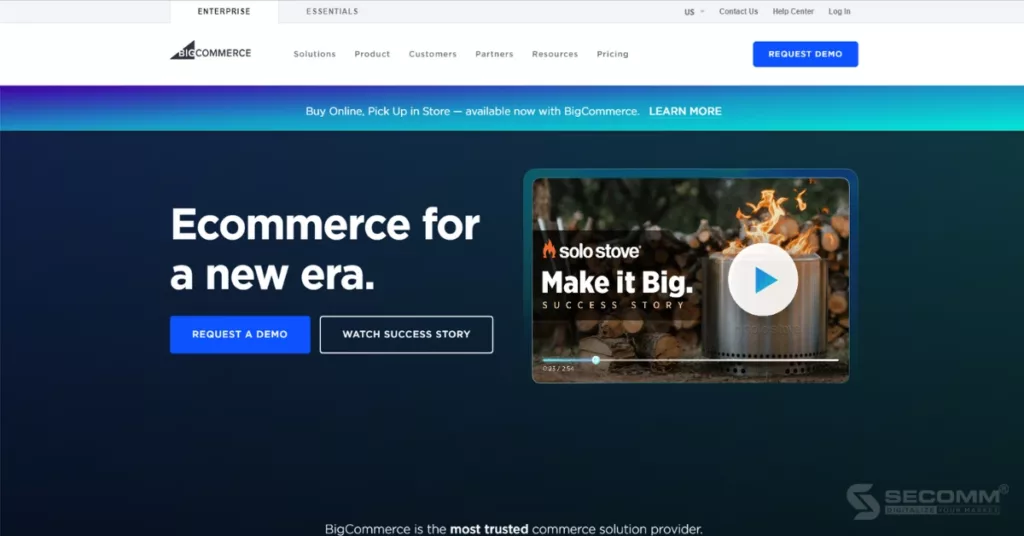
What is Magento?
Magento (now owned by Adobe) is an open-source eCommerce platform that empowers businesses with full control over developing and managing their eCommerce websites. Known for its high level of customization and scalability, Magento offers a wide range of advanced features and extensions, making it an ideal choice for meeting the complex requirements of large-scale enterprises with ample budgets and a certain level of technical expertise. Magento currently comes in two main versions:
- Magento Open Source: the free version
- Adobe Commerce: the paid version with two options, on-premise and on-cloud.
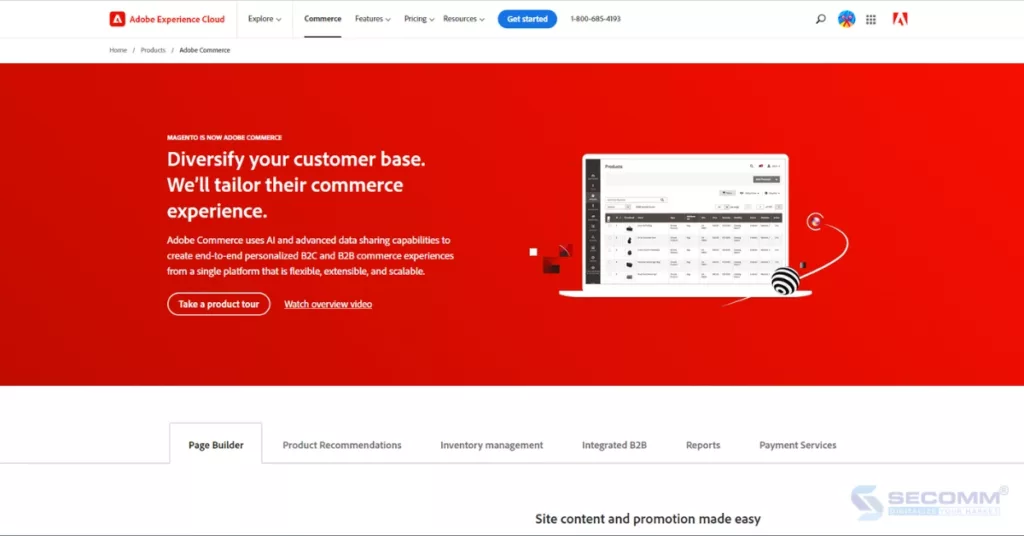
BigCommerce vs Magento: Pros and Cons
BigCommerce
Pros:
- User-friendly and easy-to-navigate interface
- Suitable for businesses of all sizes
- Comes with a rich set of integrated features
- Offers a variety of reasonable pricing plans
- Includes 65 popular global payment methods integrated with BigCommerce at no transaction cost
- Offers a diverse selection of themes and extensions
Cons:
- Sales volume restrictions apply
- Deployment costs tend to rise over time
- Customization options are limited
Magento
Pros:
- Ideal for large enterprises with complex customization needs and ample budgets
- High customization and scalability
- Diverse and advanced built-in features compared to SaaS platforms
- No sales volume limitations
- Wide range of available extensions
Cons:
- Requires a high level of technical expertise
- Lengthy deployment times
- high initial costs
BigCommerce vs Magento: Detailed Comparison
Ease of Use
Ease of use of a platform is one of the primary considerations for an eCommerce business when selecting one. A platform with an intuitive interface that is easy to set up and manage allows businesses to focus on their core operations.
BigCommerce
BigCommerce is a SaaS platform, making it more accessible for businesses that may not possess technical expertise or have a strong tech background in building eCommerce websites. It eliminates the need for complex programming; businesses simply need to provide basic information to gain access to the BigCommerce dashboard, where they can configure and manage all aspects of their online store, from product additions to layout modifications.
What’s more, BigCommerce offers a user-friendly drag-and-drop page builder that empowers businesses to create a storefront without the necessity of coding skills. Moreover, themes and extensions can be swiftly integrated with just a few clicks.
Magento
On the other hand, Magento users should have a certain level of technical expertise to execute tasks during the setup of an eCommerce website, including configuring FTP files and integrating themes into the Magento website, among other things. Tasks like modifying themes, integrating extensions, applying security patches, and optimizing speed require coding skills.
Therefore, many businesses opt to collaborate with Magento agencies to develop and maintain their Magento eCommerce websites. However, following the initial technical setup challenges, businesses can readily customize attributes and functionalities for their websites through the platform’s backend.
Pricing
BigCommerce
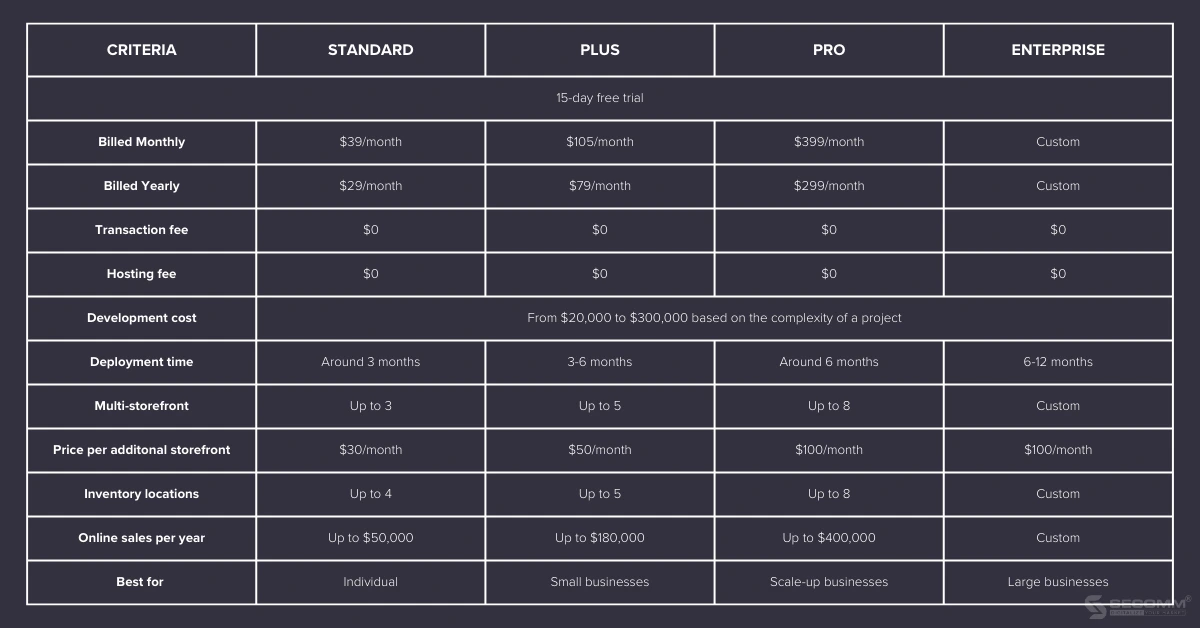
Magento
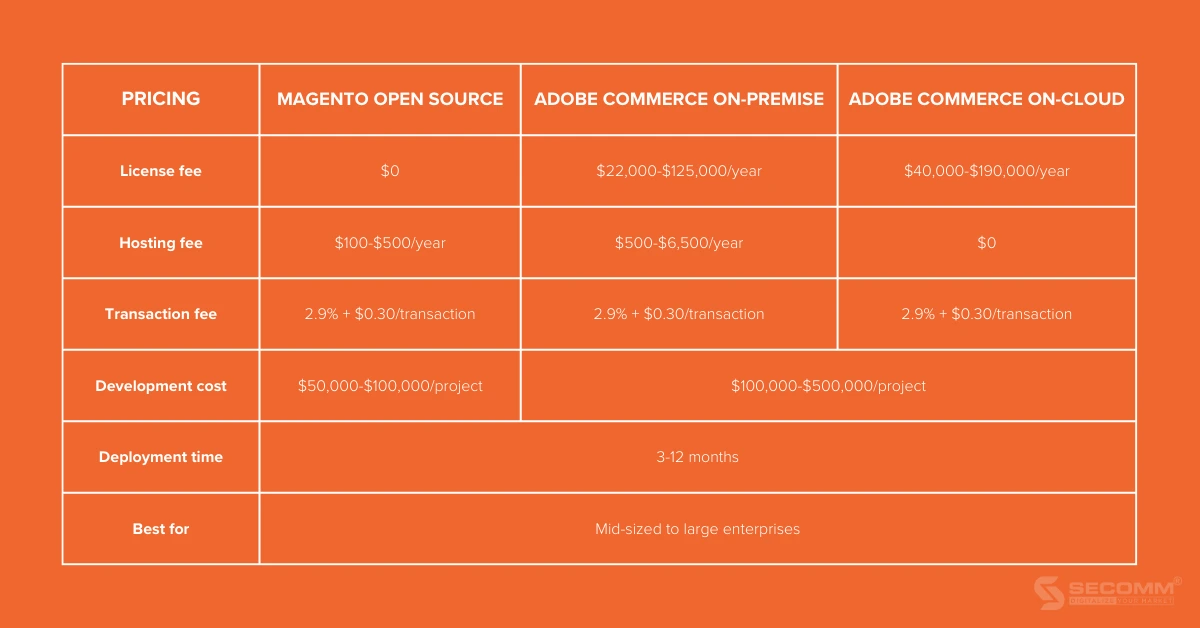
Hosting
BigCommerce
Being a SaaS platform, BigCommerce offers support for various hosting-related issues, ensuring an impressive average uptime of 99.99%, quick page loading, and minimal website maintenance.
Magento
- Magento Open Source: Businesses purchase hosting from specialized third-party providers who are responsible for infrastructure setup, security, and maintenance, allowing businesses to focus on core operations.
- Adobe Commerce on-premise: Businesses have complete control over configuring and managing their in-house hosting environment, offering customization options to meet specific needs.
Adobe Commerce on-cloud: Hosting for the business’s Magento eCommerce site is provided, configured, managed, and stored on virtual servers offered by cloud service providers (CSPs) like AWS and Microsoft Azure.

Features
SEO
SEO is a crucial feature that every eCommerce website needs and it’s an important factor for businesses to consider when assessing a platform. Both BigCommerce and Magento offer essential SEO optimization features, which include:
- Google site maps
- SEO-friendly URLs
- URL rewriting
- Meta descriptions
- 301 redirect handling
- Mobile compatibility
However, BigCommerce includes a built-in ‘blog’ feature in its solution packages, while Magento requires businesses to integrate a ‘blog’ extension to use this feature.
Plus, businesses can enhance their website’s SEO by using extensions available in the Magento and BigCommerce marketplaces. It’s worth noting that Magento offers a wider range of advanced SEO tools, although the cost of Magento extensions may be higher than those available for BigCommerce.
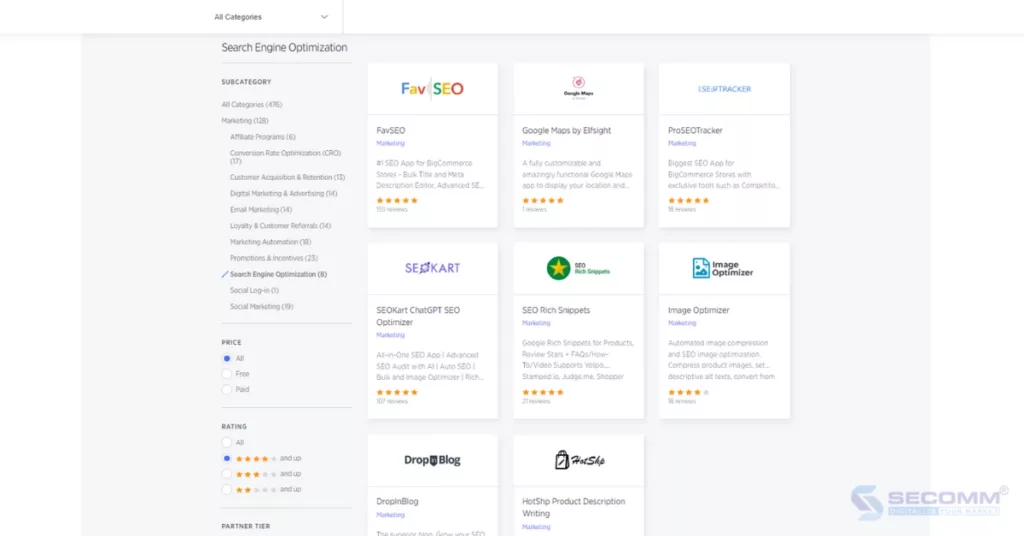
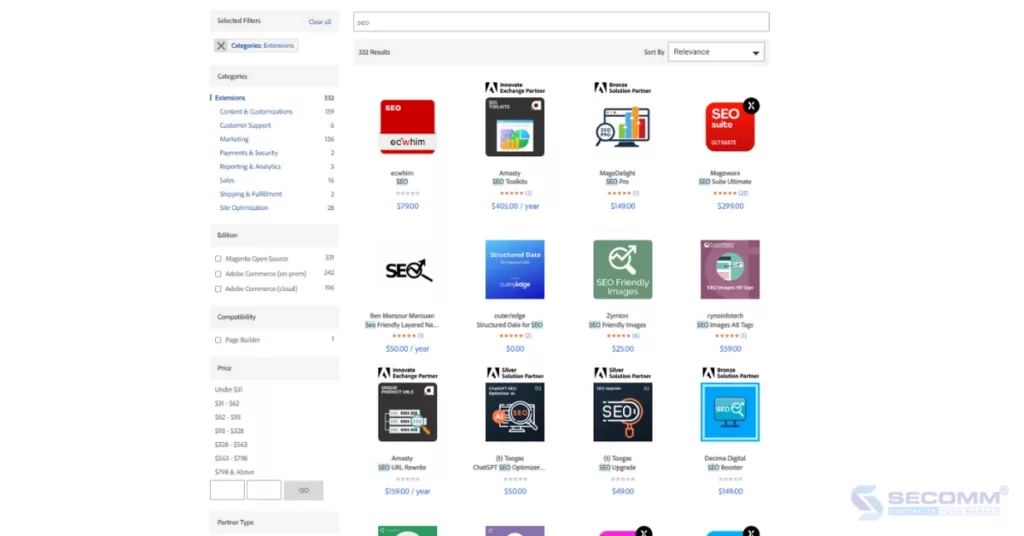
Multiple channels integration
With this feature, BigCommerce excels over Magento by pre-integrating the most prevalent sales channels like Amazon, eBay, Walmart, Facebook, and Instagram into all pricing plans. However, if businesses require integration with additional sales channels beyond these pre-set options, they can do so by utilizing apps from BigCommerce’s marketplace.
On the other hand, Magento offers businesses the flexibility to implement multi-channel sales by integrating various desired sales channels into their eCommerce website, each with its own associated costs. Notably, Amazon integration can be done for free.
Purchase flow
eCommerce businesses have to ensure a seamless, swift, and user-friendly customer buying journey, encompassing features like product search support and an effortless payment process. Both Magento and BigCommerce provide capabilities to facilitate online shopping, including
- Product filtering
- Product comparison
- Recently viewed items
- Wishlist
- One-page checkout
- Checkout as a member or visitor
- Real-time shipping rate calculation
- Multiple shipping addresses
- Order tracking via registered accounts
- Reordering
Payment options
BigCommerce provides businesses with 65 integrated payment gateways, including popular options like Apple Pay, Google Pay, and Amazon Pay, all with no transaction fee.
In contrast, Magento offers only PayPal and Authorize.net for payments, requiring businesses to integrate third-party payment providers for more choices. Magento’s marketplace features over 450 payment-related extensions with various costs, but businesses will need time to select and integrate them.
Themes & Extensions
Aside from features, themes, and extensions also contribute significantly to the growth of an eCommerce website. Therefore, this is another factor that businesses take into account when selecting a platform.
BigCommerce
The platform provides 266 themes with prices ranging from $195 to $395, including 12 free themes. Businesses can purchase BigCommerce themes on ThemeForest at prices ranging from about $16 to $179.
These designs are modern, suitable for various industries, and offer good responsiveness across multiple screen sizes, including smartphones, tablets, and desktops. However, when compared to other SaaS platforms like Wix or Squarespace, BigCommerce’s customization options and the quantity of both free and paid themes may appear relatively limited. Moreover, the exact count of free and paid themes might not be entirely precise, as some themes share very similar layouts, differing mainly in color schemes.
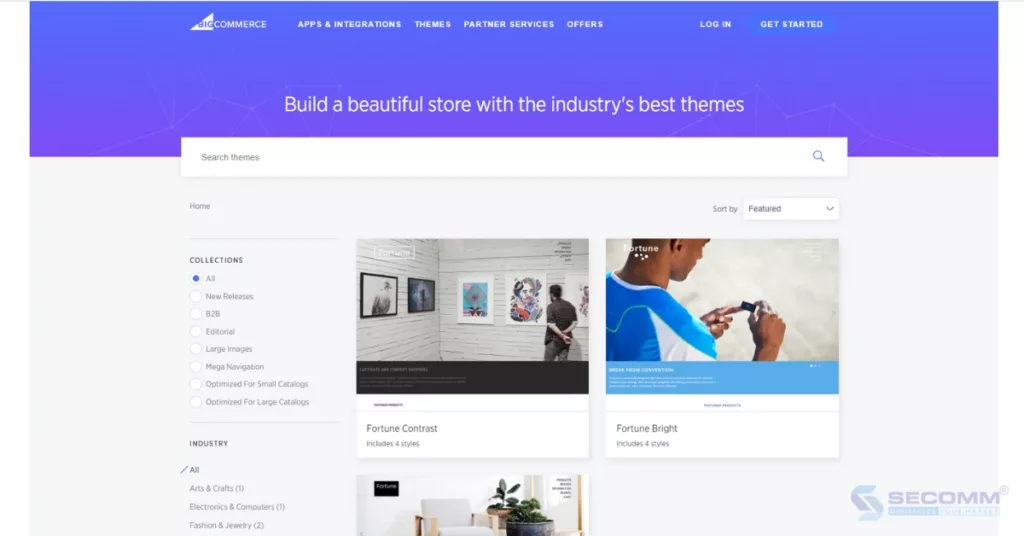
Magento
Unlike BigCommerce, Magento provides a limited selection of themes, with just 9 options available. Among these, only 3 themes are free, while the rest range in price from $150 to $499 each. If businesses opt to purchase Magento themes on ThemeForest, they can expect prices ranging from $39 to $299 per theme.
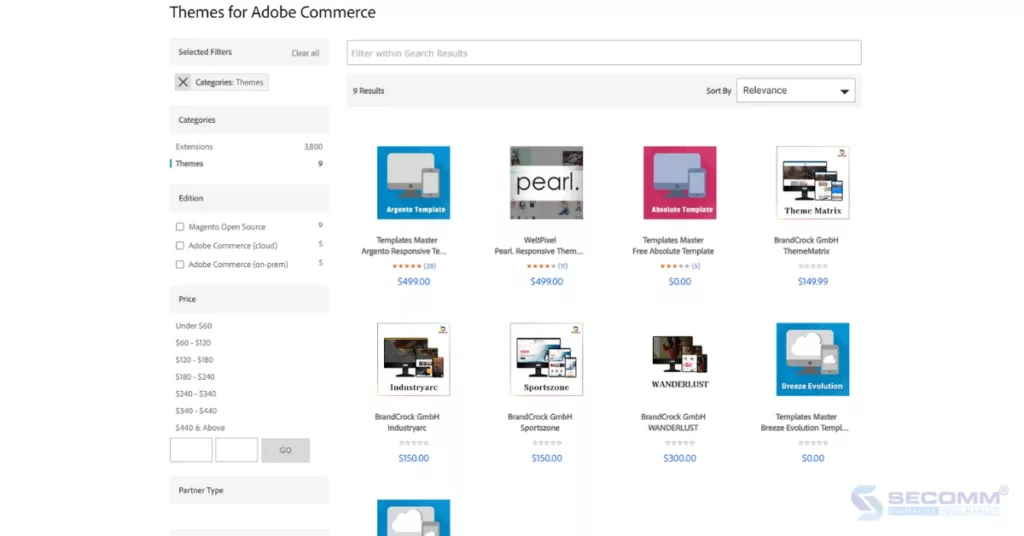
Moreover, businesses have the option to create custom interfaces tailored to their unique requirements by partnering with specialized providers, incurring costs typically ranging from $1000 to $5000.
Regarding extensions, both BigCommerce and Magento offer extensive extension libraries to support businesses in growing their eCommerce stores. However, Magento has a slight edge in this regard.
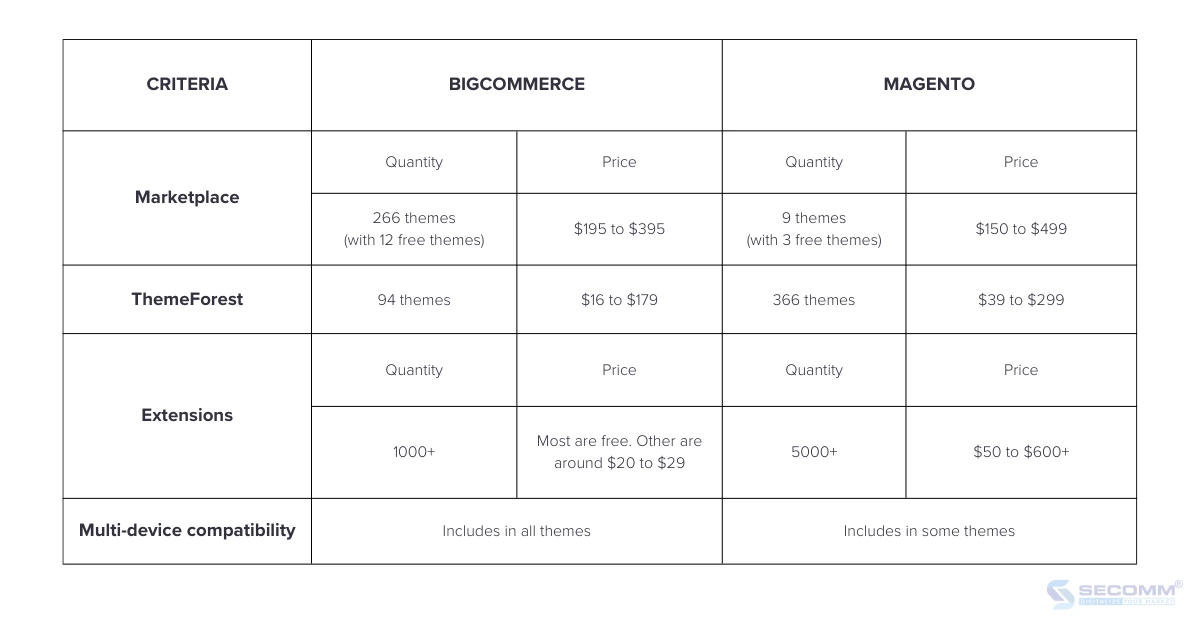
Customization & Scalability
Customization involves the capacity to adjust any feature, theme, or integrated extensions to meet specific requirements for an eCommerce website. Scalability, on the other hand, refers to the ability to maintain platform performance as the eCommerce site expands. Therefore, these factors play a vital role in platform selection.
Customization
Magento operates as an open-source platform, giving developers full access to and control over the source code.
On the other hand, BigCommerce functions as a SaaS platform, restricting businesses from making backend modifications. While certain frontend interface adjustments are possible with a few code snippets, most modifications need to be done in the backend. Hence, BigCommerce’s customization is somewhat limited compared to Magento.
Scalability
Both Magento and BigCommerce can handle large website traffic and sales volumes. However, Magento outperforms BigCommerce in this aspect, which is also why Magento doesn’t have sales volume limits.
Meanwhile, BigCommerce imposes annual sales volume limits based on the pricing plan being used. When businesses reach the sales volume limit of their current pricing plan, they need to upgrade to a higher-tier plan.
- Standard: Up to $50k/year
- Plus: Up to $180K/year
- Pro: Up to $400K/year
- Enterprise: Custom
Security
Both BigCommerce and Magento are prominent names in the eCommerce industry, trusted by numerous businesses for their security features. Nevertheless, when it comes to providing security-related assistance, these platforms exhibit notable differences.
As a SaaS platform, BigCommerce includes security support as an integral component of its solution packages. This encompasses SSL certificates, firewalls, backups, and intrusion detection. In case any complications arise during the eCommerce deployment process, businesses can readily access 24/7 customer support for swift assistance.
In contrast, due to Magento’s open-source nature, businesses bear the responsibility for managing the security aspects of their Magento eCommerce websites. This entails tasks such as overseeing SSL certificates, implementing two-factor authentication, and adhering to PCI compliance. Additionally, while Magento periodically releases security updates, the manual update process can pose challenges for users without technical expertise.
Magento’s support options also present limitations when compared to BigCommerce. Businesses can seek assistance during Magento’s specified operating hours or engage with third-party intermediaries, a potentially time-consuming and complex process.
Popularity
BigCommerce and Magento are both leading options for eCommerce businesses, but their levels of popularity differ somewhat.
According to BuiltWith, at the present time, there are 142,010 active websites using Magento, whereas there are only 44,796 active websites using BigCommerce.
Thus, when it comes to popularity, Magento has the upper hand.
Well-known brands such as Coca-Cola, Nike, and Tesla utilize Magento, while renowned brands like Skullcandy, LARQ, and Molton Brown opt for BigCommerce.
After many years of implementing eCommerce solutions for clients all around the world, using both the BigCommerce and Magento platforms, SECOMM has gained invaluable experience in helping businesses develop and operate their eCommerce websites quickly and efficiently.
Contact us or call SECOMM’s hotline directly at (02871089908) for a free consultation on implementing eCommerce websites with BigCommerce or Magento.
 2
2

 9,619
9,619

 0
0

 1
1
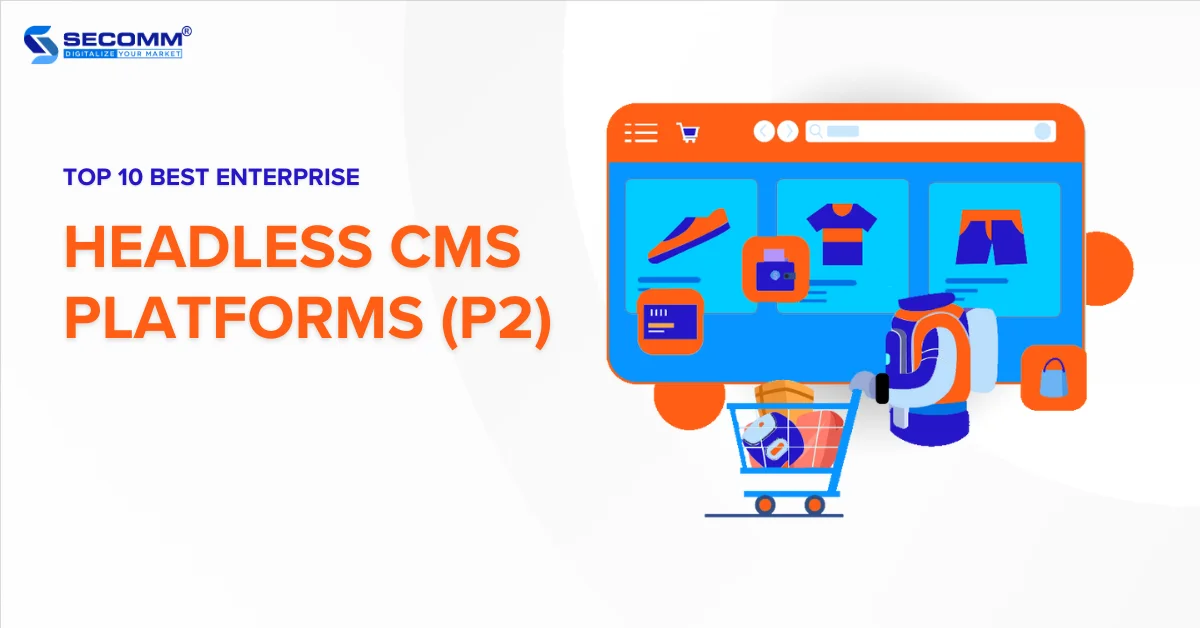
TOP 10 BEST ENTERPRISE HEADLESS CMS PLATFORMS (Pt2)
Table of Contents
Recently, the trend of Headless CMS deployment has significantly influenced the eCommerce landscape. The emergence of diverse platforms offering various solutions, features, and top-notch customer support can be attributed to this phenomenon.
Building upon Part 1, this article highlights 5 more Headless CMS platforms that numerous large enterprises leverage to enhance their seamless multi-channel content distribution process.
Kontent.ai
Kontent.ai is a cloud-based Headless CMS platform that helps marketers simplify their content creation and management while providing developers the capability to deliver responsive digital experiences across various devices.
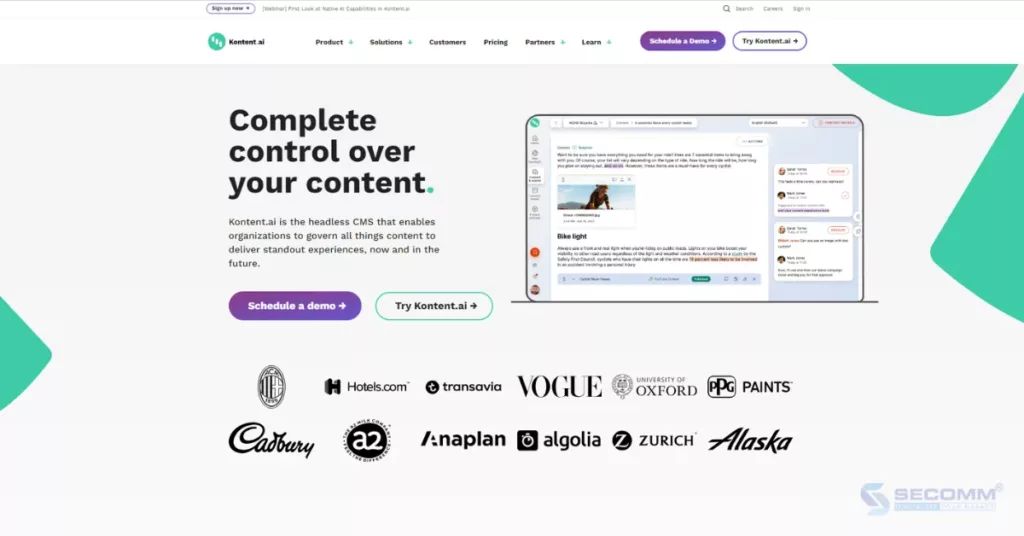
The platform offers support for developers through a range of APIs, including REST, GraphQL, Management v2, and Custom Element JavaScript. Furthermore, Kontent.ai is compatible with programming languages such as JavaScript, .NET, PHP, Java, Ruby, and iOS.
Key features
- Webhooks allow businesses to integrate Kontent.ai with other applications and automate operational processes. Also, Webhooks can be programmed to notify when any changes occur.
- Command-line interface (CLI) supports continuous integration and continuous delivery (CI/CD process), enabling businesses to safely and regularly test and deploy necessary changes.
- Real-time collaboration optimizes content planning with clear task assignments and shared publishing schedules for easy team tracking.
- Simultaneous Editing allows multiple team members to easily edit content without worrying about affecting the work of others.
- Web Spotlight supports the creation of new webpages for upcoming marketing campaigns, adding content, rearranging page elements without the need for developer assistance, and providing content reusability across multiple channels and campaigns.
Pros
- Quick technical support
- Seamless integration with third-party services to optimize the content creation, publishing, distribution, and marketing processes.
Cons
- Limitations in user roles and sometimes encountering obstacles when installing plugins.
- The lack of publicly available pricing makes it challenging for businesses to estimate deployment costs.
- The admin UI interface only supports English, which can be difficult for users who use other languages.
Pricing
Kontent.ai offers three solution packages
- Developer: Free, provides features suitable for non-commercial projects.
- Scale: Custom pricing based on needs, offers a rich set of features for creating and distributing engaging content.
- Enterprise: Custom pricing based on needs, provides superior solutions for delivering and managing seamless digital experiences.
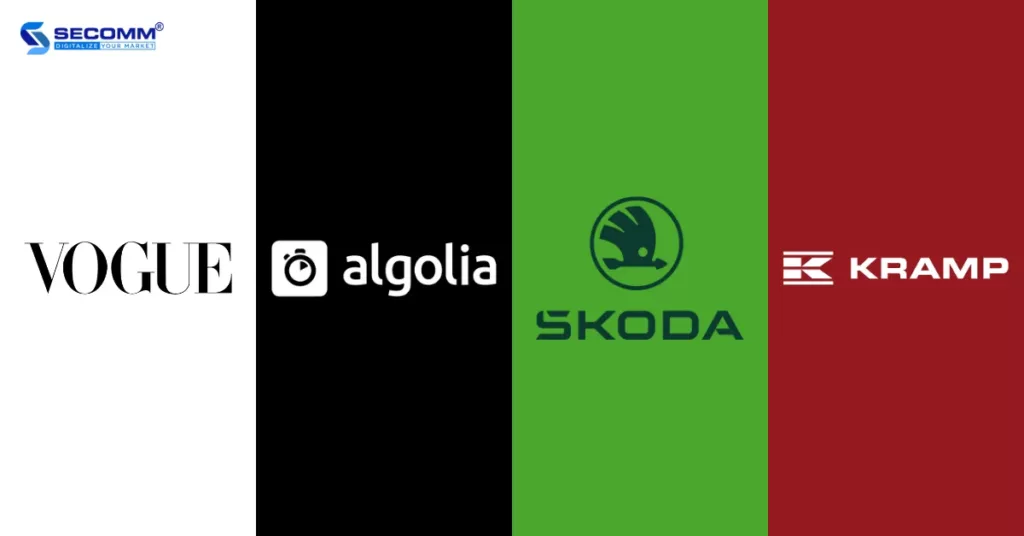
Contentstack
Contentstack stands out as a leading Headless CMS platform, facilitating seamless content distribution across multiple channels and devices, ranging from websites, and mobile apps to IoT devices. It offers robust support for popular frameworks like REACT, Vue.js, Angular, and a variety of programming languages such as JavaScript, PHP, Ruby, and Python, among others. Moreover, Contentstack allows businesses to integrate with various platforms, including BigCommerce, Commercetools, Shopify, YouTube, Vimeo, and more.
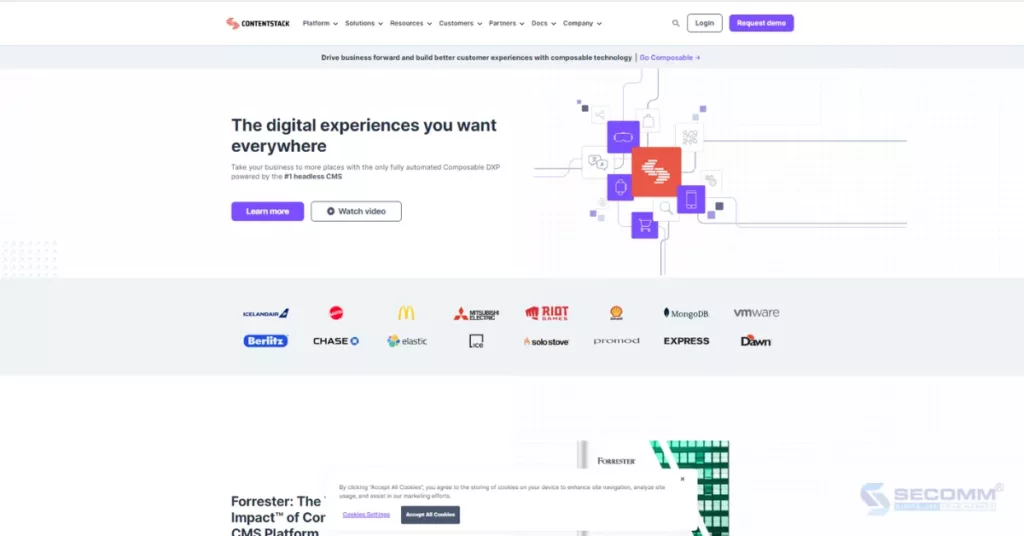
Key features
- Workflow & Live Preview optimizes and expedites the content creation, review, approval, and publishing process. Additionally, it enables businesses to easily preview real-time content changes across multiple channels before saving or publishing.
- Modular Blocks help instantly create and modify website or app components through simple drag-and-drop actions, without relying on developer assistance.
- Localization for creating and publishing content in 200 languages, meeting the seamless content distribution needs of a global audience.
- Contentstack AI Assistant helps businesses enhance their content creation experiences. Moreover, businesses can integrate Contentstack with other AI applications to provide VR and AR experiences.
- Headless APIs allow businesses to flexibly build interfaces and select APIs tailored to their content goals.
Pros
- Integrating with various platforms and programming languages, including iOS and Ruby.
- Rich learning resources and user-friendly instructional materials.
- Fast content creation, publishing, and distribution.
- 24/7 customer support with a ready-to-use chatbot.
Cons
- Non-disclosed pricing makes it challenging to estimate deployment costs.
- Occasional issues with the WYSIWYG editor.
- Complex to deploy compared to other Headless CMS options.
Pricing
Contentstack offers businesses three solution packages:
- Start: 10 users, 30 content types, 4 system roles.
- Grow: 10 users, 50 content types, 5 system roles.
- Scale: 10+ users, unlimited content types, and system roles.
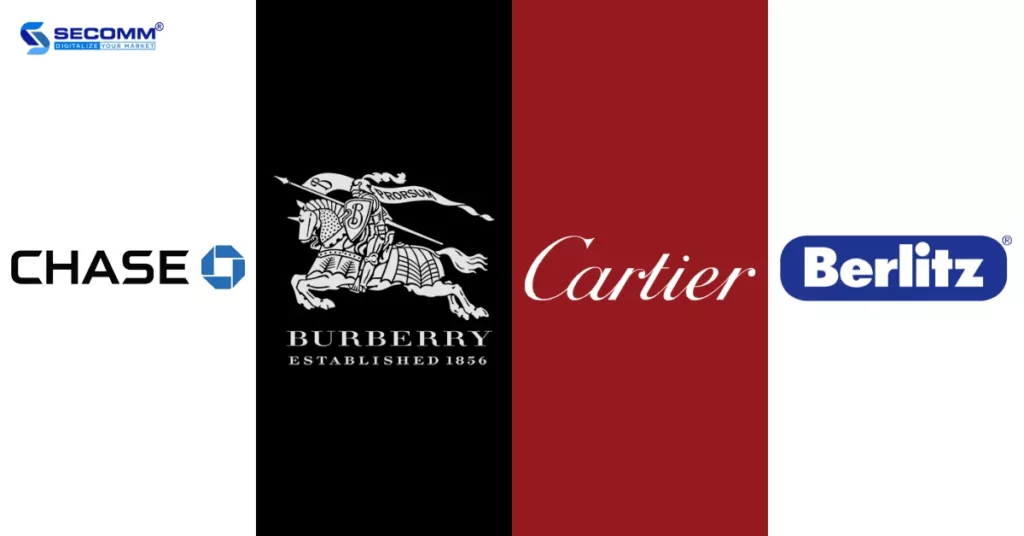
dotCMS
dotCMS is an open-source Headless CMS based on Java, offering numerous solutions and features that enable businesses to create and reuse content for building personalized and seamless digital experiences across channels. dotCMS supports APIs like REST and GraphQL and can integrate with platforms such as HubSpot, Google Analytics, Salesforce, and more.
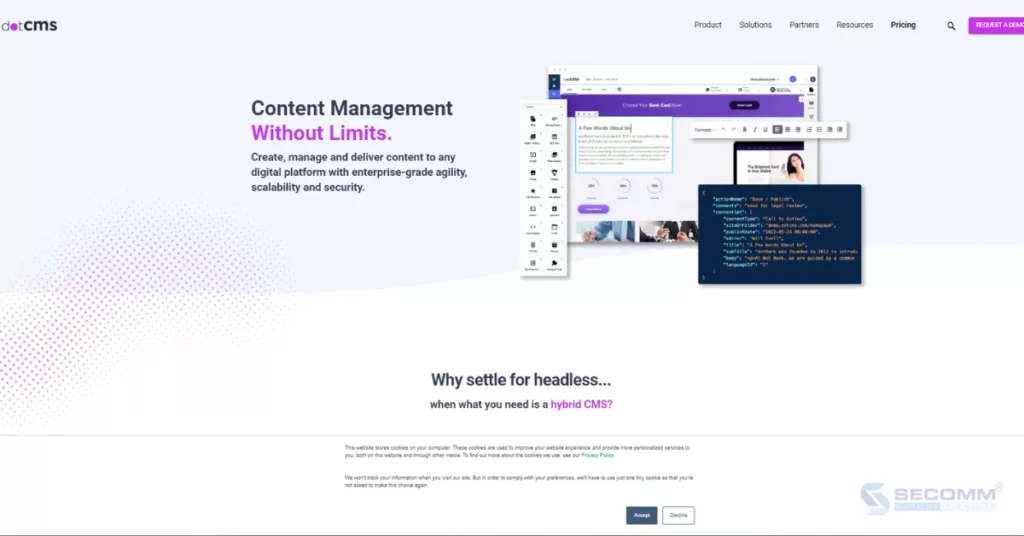
Key features
- Allows businesses to manage the process of creating and publishing multilingual content with localization support for publishing according to local time and predefined schedules.
- Provides full content, layout, and workflow control through APIs and JSON data strings.
- WYSIWYG (What You See Is What You Get) editor allows businesses to create content with text processor-like formatting.
- Offers APIs for real-time image resizing, cropping, and manipulation. Additionally, dotCMS supports image optimization for user devices, such as automatic resizing and image compression in WebP format.
Pros
- Allows businesses to customize content and integrate with other platforms.
- Provides abundant learning resources and technical support.
- Offers quick customer support with a chatbot.
Cons
- Many concepts and features may require businesses to invest time in learning.
- The platform occasionally encounters errors.
Pricing
dotCMS offers three solution packages for users to choose from:
- Open Source: Free, suitable for individuals with simple needs and self-hosting.
- Starter: $3,750/month, designed for small businesses.
- Enterprise: Custom pricing based on needs, suitable for medium to large enterprises with advanced features and superior support.
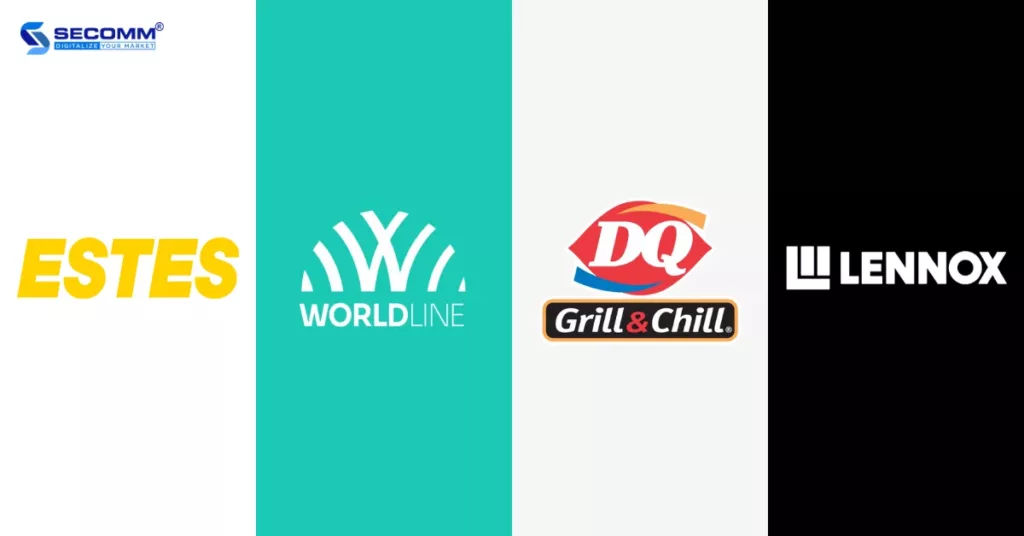
Butter CMS
Butter CMS is a Headless CMS platform that simplifies content development and management for businesses. The platform supports frameworks such as React, Vue.js, Node.js, Angular, and various programming languages like PHP, Python, Java, Swift, Kotlin, Ruby, and more.
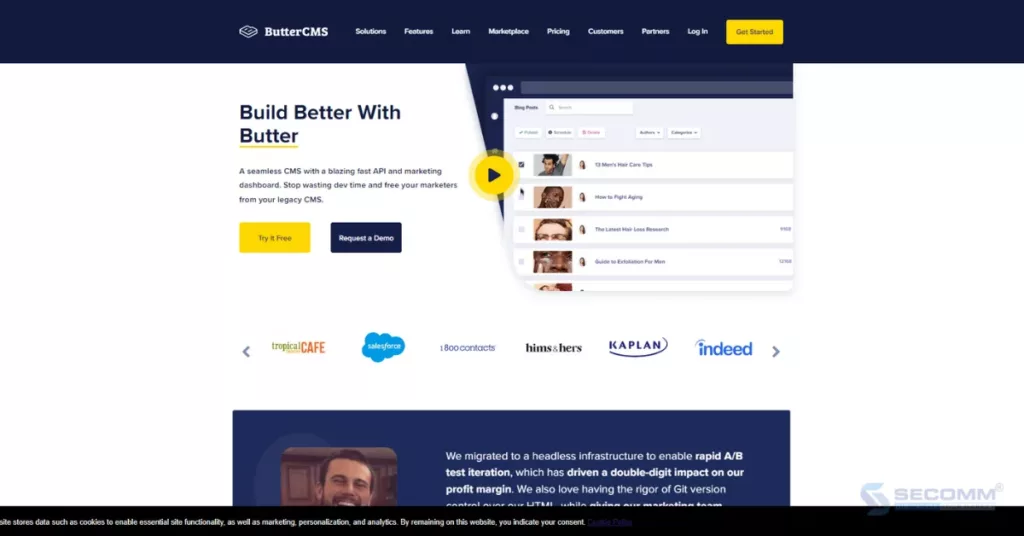
Key features
- Developer Experience: Butter offers a variety of tech stacks for developers to deploy as needed. Developers also can configure Webhooks in their account settings to receive notifications for any content-related changes. Especially with One-click Migrations, businesses can easily create schemas or move content within the Butter CMS environment through the dashboard.
- Launch Content Faster: Butter provides features to help businesses easily manage Content Types on a centralized dashboard and build landing pages to drive organic or advertising-generated traffic. Moreover, Butter CMS’s Blog Engine offers a set of APIs for businesses to add a blog to their website and fully customize it based on their needs.
- Localization: Businesses can create and publish multilingual content. Furthermore, administrators have language-specific access to specific local markets, ensuring a unified collaboration process among global marketing teams.
Pros
- One of the best user-friendly platforms for developers and content marketers.
- Provides a headless CMS solution for various content needs, including e-commerce businesses, agencies, SaaS companies, e-commerce marketplaces, and enterprises managing multiple websites simultaneously.
- Excellent customization capabilities.
- Offers integration support for various frameworks, programming languages, and more.
- Provides a chatbot for customer inquiries.
- Offers a 30-day trial for businesses.
Cons
- Many features and concepts but lack instructional videos, leading to difficulty in understanding and application.
- Limited features for creating dynamic and interactive content.
Pricing
Butter CMS offers a variety of solution packages, including
- Micro: $83/month, suitable for freelancers implementing small projects for their clients.
- Startup: $166/month, designed for startups to quickly launch projects to the market.
- Small Business: $333/month, for growing businesses with expanding content needs and running global advertising campaigns.
- Enterprise + Agency: Custom pricing based on specific requirements.

Builder.io
Builder.io is a Headless CMS platform that allows businesses to visually build and optimize web and mobile experiences. The platform supports developers with frameworks like React, Vue.js, Gatsby, and Next.js. Additionally, businesses can integrate Builder.io with popular platforms such as Shopify, BigCommerce, Salesforce, Magento, Cloudinary, Yotpo, Commercetools, and more.
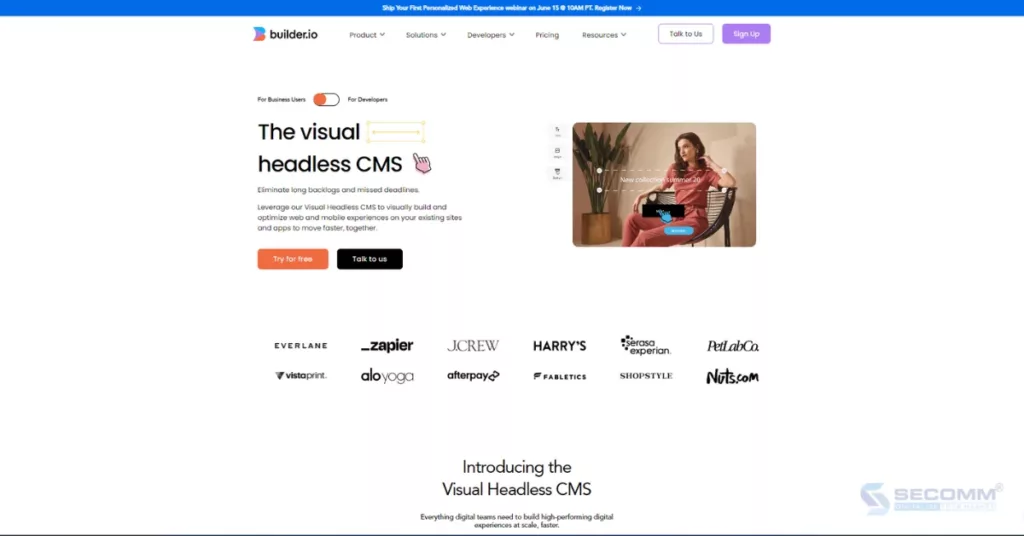
Key features
- Integrate: Provides versatile and simultaneous integration capabilities. For example, it can integrate with Crowdin, Phrase, Smartling for content localization, BigCommerce, Shopify, Magento for eCommerce deployment, and Figma for design. Builder.io can even integrate with other CMS platforms like Contentstack, Contentful, and Kontent.ai.
- Compose: Utilizes drag-and-drop tasks to customize existing design systems. Builder.io offers blocks such as text, image, video, and forms to allow users to easily create custom experiences beyond the available default designs.
- Design: Offers responsive design capabilities, enabling users to customize content and layouts to suit various devices and create animations without the need for coding. Builder.io also supports integrating design layouts from Figma to streamline the design process.
- Collaborate: Easily customize system roles and permissions to enhance collaboration and real-time content creation tracking. Team members can initiate chat discussions, share ideas, and update work progress with each other.
- Optimize: Easily create multiple pages and different content for A/B testing without compromising website and app performance. It supports personalized content targeting. Furthermore, Builder.io provides analytics on click-through rates, conversions, and user interactions with published content. Businesses can also integrate data with other analysis systems like BI (Business Intelligence) and CDP (Customer Data Platform).
Pros
- A user-friendly platform suitable for both developers and non-technical users.
- Provides quick and seamless integration with various frameworks, programming languages, and more.
- Offers numerous options for businesses to optimize design and create content.
- Rich learning resources, including easy-to-understand video tutorials.
- Includes a chatbot for customer query resolution.
Cons
- Does not offer trial options for its solution packages.
- Being a relatively new platform, it may be challenging for businesses to find user experience reviews on forums.
Pricing
Builder.io offers a range of solution packages:
- Free: $0/month, for quick deployment.
- Basic: $99/month, includes all essential tools and features to get started.
- Growth: $449/month, encompasses all tools and features for optimization and growth.
- Enterprise: Custom pricing based on business needs.

So, SECOMM’s comprehensive overview of the top 10 Headless CMS platforms (P1+P2) has concluded, with the expectation that enterprises will find the platform that aligns with their development requirements. By adopting a Headless CMS, businesses can promptly establish an online presence and efficiently connect with numerous potential customers through compelling content distribution.
Feel free to get in touch with SECOMM or directly call our Hotline at (02871089908) for expert guidance and assistance in implementing a Headless CMS.
 2
2

 7,291
7,291

 0
0

 1
1

TOP 10 ECOMMERCE UI/UX DESIGN TRENDS IN 2024 AND BEYOND
Table of Contents
As new UI/UX design trends emerge, designers must stay up-to-date to create the most engaging and user-friendly interfaces for businesses. UI/UX design plays a vital role in crafting excellent user experiences and improving online business efficiency.
In this article, SECOMM will discuss the latest UI/UX design trends for the year 2024 and beyond
What is UI/UX design?
User Interface (UI) and User Experience (UX) are often regarded as two interrelated aspects when it comes to designing interfaces for any online product or service, especially in the case of eCommerce websites.
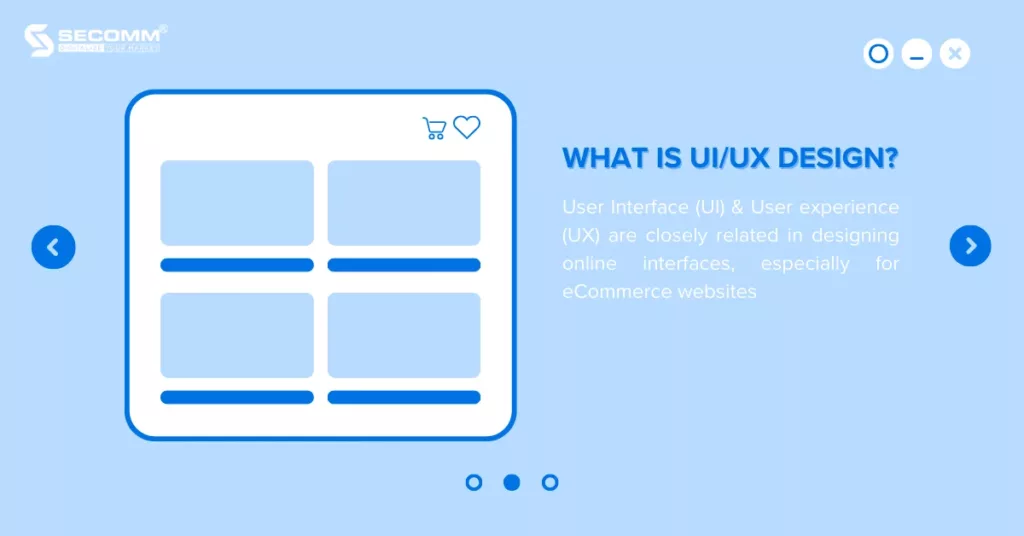
UI design encompasses the creation of various elements like call-to-action buttons, navigation bars, charts, and images, all based on choices of colors, layouts, fonts, and more, to craft an intuitive, appealing, and visually engaging user interface. In design, UI serves as a means to convey messages from businesses and brands to their users.
On the other hand, User Experience (UX) involves the process of shaping the overall experience for users during their interaction with a product or service. This encompasses meeting user requirements for ease of use and functionality, strategizing and structuring information, designing interaction workflows, and assessing effectiveness through research on user habits and behaviors within eCommerce websites.
The role of UI/UX design in eCommerce
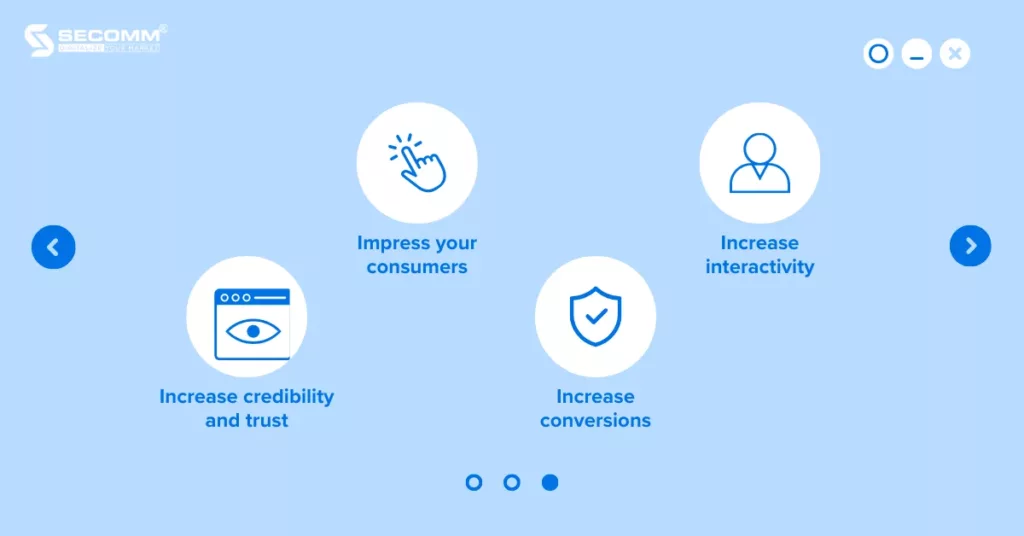
Impress your consumers
Expertly crafted UI/UX design can leave a lasting impact on users when they visit your eCommerce website. In the highly competitive eCommerce landscape, a remarkable UI/UX design can set your business apart and create a distinctive identity among market rivals.
Increase interactivity
Effective UI/UX design can help you enhance your interaction capabilities with consumers. For example, creating social media sharing buttons, user reviews, and intuitive search tools can streamline the customer’s journey to products and more.
Increase credibility and trust
A professional UI/UX design helps you establish trust with customers and cultivate a positive brand image. By offering clear security information, SSL certificates, and secure payment procedures, you can instill confidence in customers while mitigating the risks of personal data breaches and financial fraud.
Increase conversions
Starting with an investment in UI/UX design helps convert potential customers into actual customers. Through data analysis and user feedback, businesses can gain a deeper understanding of customer behavior and make interface adjustments to improve the user experience and overall business performance.
Related article: The 10 biggest eCommerce trends set to dominate in 2023
Top 10 UI/UX design trends
Dark Mode
Although the Dark Mode design trend isn’t new to website developers, it continues to be popular in 2023. The option to switch between light and dark modes offers users more flexibility when visiting an eCommerce website. Dark Mode enhances the browsing experience, especially for users who spend extended hours in front of screens. Furthermore, it can contribute to saving battery life on mobile devices or screens equipped with OLED displays.

3D Design
The 3D design trend is gaining more popularity in UI/UX design. 3D elements bring depth and realism to website interfaces, making them visually appealing and improving user interaction. UI/UX designers frequently utilize 3D elements for website components like CTA buttons, icons, banners, and backgrounds, or employ 3D animations for feedback and transition effects, creating a more engaging user experience that fosters a visual connection with users.
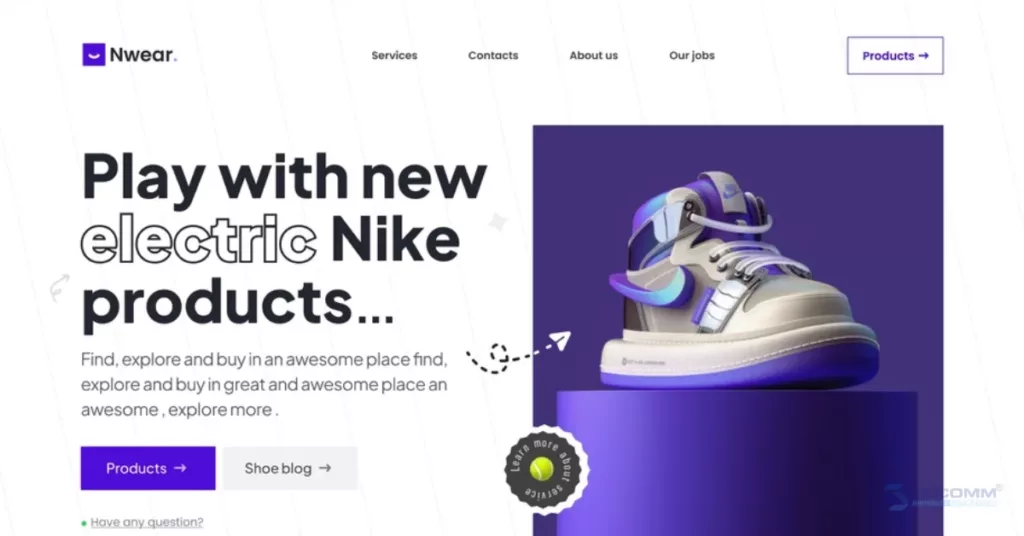
Neomorphism
Neumorphism is a design trend that blends aspects of both skeuomorphism and flat design. It creates a 3D effect by using shadow and highlight effects to achieve a sleek, modern look for websites. However, UI/UX designers must be cautious not to overuse neumorphism, as it can result in a cluttered, confusing interface or create effects contrary to what a business intends to convey.

Modern Minimalism
Modern Minimalism represents a UI/UX design trend that centers on crafting straightforward, user-friendly interfaces by removing extraneous elements and highlighting vital content. This style combines simplicity with modernity, providing users with a refined and user-friendly experience. The main challenge in implementing Modern Minimalism is finding the balance between simplicity and aesthetics, ensuring that the design remains both visually appealing and easy for users to navigate.
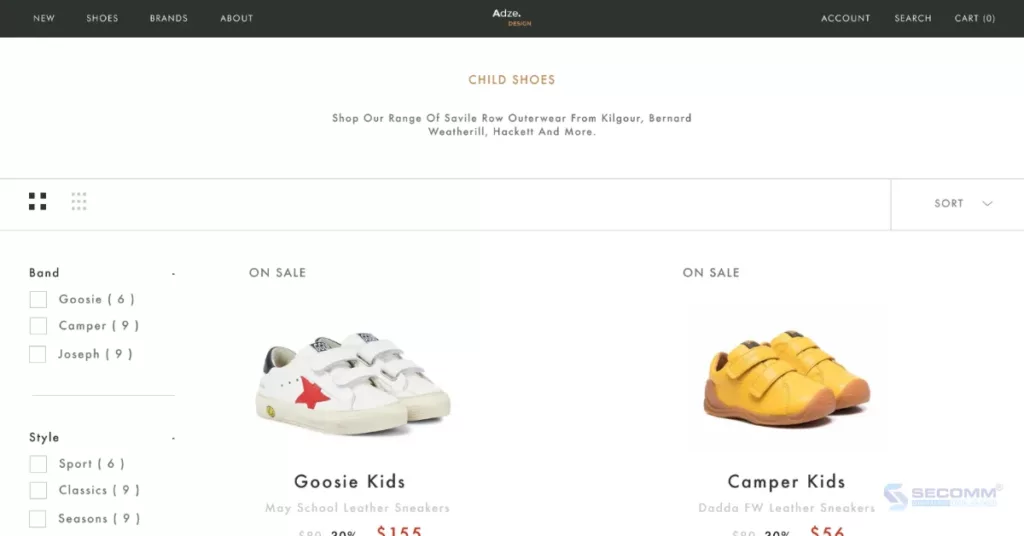
Dynamic Gradient
Dynamic Gradient is a design trend that produces color gradient effects that adapt according to user interactions or the time of day. It can offer users a more personalized and sophisticated experience. However, when implementing Dynamic Gradient in UI/UX design, it’s crucial for designers to strike a balance so that color intensity doesn’t become overpowering and doesn’t compromise readability.

Voice Interface
Voice Interface represents a UI/UX design trend where users can interact with an eCommerce website system using voice commands rather than traditional input methods such as keyboards, mice, or touchscreens. Voice Interface employs voice recognition technology to comprehend and respond to user commands, requests, or queries. In UI/UX design, Voice Interface introduces a fresh and user-friendly mode of interaction, thereby unlocking a plethora of opportunities for tailoring the user experience and delivering personalized services.

Micro-interactions
Micro-interactions are a design style that incorporates small elements, including subtle animations, specific sound effects, image responses to user actions or voice commands, and more, to create an engaging experience and enhance interaction on a website. Micro-interactions can also help guide users through the website interface effortlessly. When applying Micro-interactions, UI/UX designers need to ensure they won’t distract or annoy users.

Augmented reality (AR)
Augmented reality (AR) is becoming increasingly popular in the UI/UX design community, especially in eCommerce websites related to technology, interior design, cosmetics, gaming, and more. AR allows users to interact with products/services as if they were in the real world, bridging the gap between online and offline shopping. However, due to its advanced technology, AR can sometimes pose challenges for older or less tech-savvy customers. Therefore, when designing the UI/UX, businesses must ensure that AR elements are intuitive and user-friendly.

Asymmetric Layouts
Asymmetric Layouts is a UI/UX design trend where elements and components aren’t arranged in the traditional symmetrical structure. Instead, elements are placed asymmetrically and inconsistently, creating a sense of balance and noticeable uniqueness in the design.
The strength of Asymmetric Layouts lies in their ability to capture users’ attention and create a distinctive experience through images and emphasis on essential content. However, when using Asymmetric Layouts, it’s essential to consider ensuring that the eCommerce website interface remains user-friendly, easy to navigate and maintains its aesthetic appeal.

Data Visualization
Data Visualization is a design trend that involves presenting complex data in a clear and visual manner using graphs, charts, and images. In UI/UX design, Data Visualization is used to transform intricate information into engaging visuals, simplifying data comprehension and interaction for users.
Therefore, when incorporating Data Visualization into UI/UX design, it’s essential to carefully choose appropriate data representation methods, utilize colors and graphical elements effectively, and ensure information is conveyed clearly and attractively.
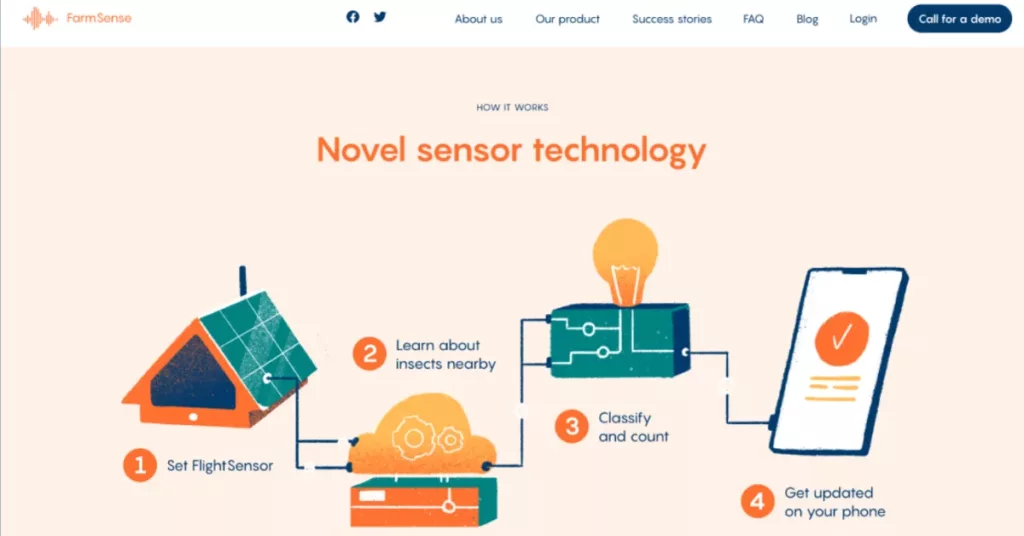
Those are the top 10 UI/UX design trends for eCommerce website in 2023. We hope that the valuable information in this blog will help you choose your best-fit style that conveys your brand’s essence.
Contact us now or call directly to the SECOMM hotline at (028) 7108 9908 for eCommerce consulting and implementation.
 2
2

 10,198
10,198

 0
0

 1
1
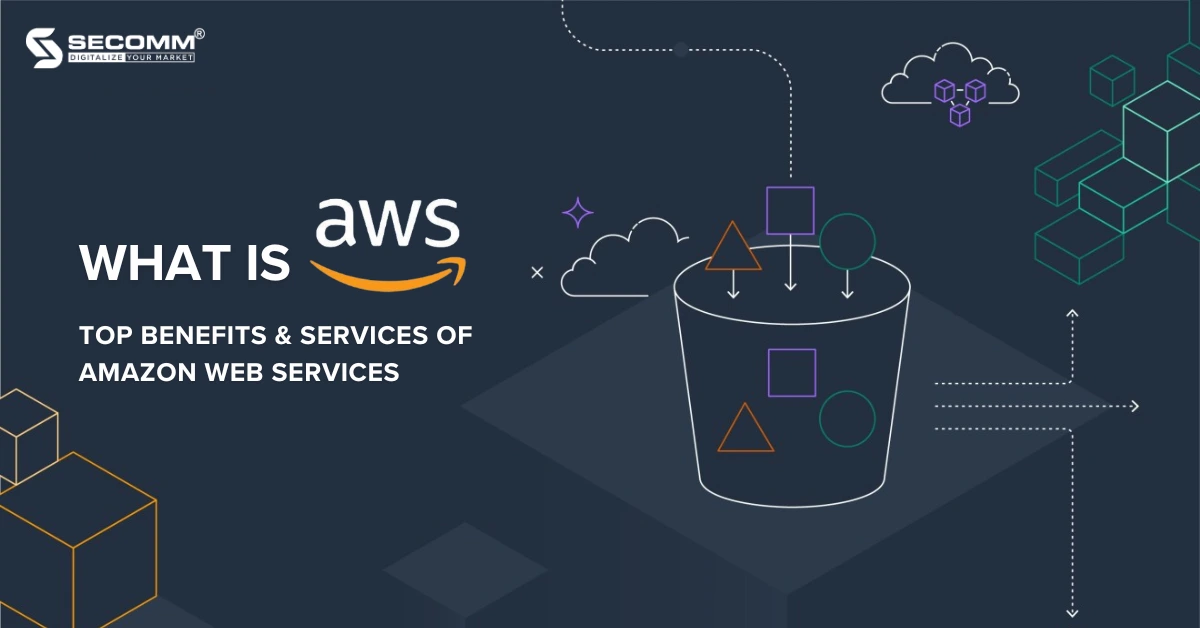
WHAT IS AWS? TOP BENEFITS & SERVICES OF AMAZON WEB SERVICES
Table of Contents
In the cloud infrastructure service market, there are many large enterprises, but the first name that comes to mind for large enterprises is AWS.
What is AWS?
AWS (Amazon Web Services) is a cloud solution developed by the “giant” Amazon, trusted by millions of businesses, including fast-growing startups, colossal corporations and top-tier government agencies.
At present, AWS provides a comprehensive array of over 200 fully-featured services, accessible from data centers scattered across the globe. These services encompass blockchain, cloud computing, DevOps, storage, backup, recovery, and more.
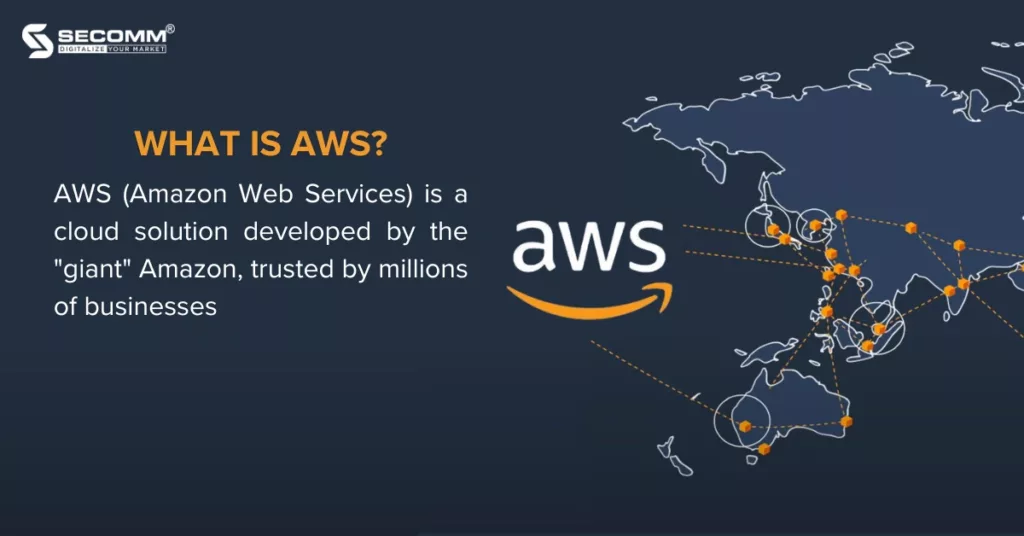
According to estimates published by the Synergy Research Group, Amazon’s market share surged to 32% during the initial quarter of 2023, maintaining its lead in the global cloud infrastructure market and surpassing all other tech titans, including Microsoft Azure, Google Cloud, Alibaba Cloud, IBM Cloud, Salesforce, Oracle, and Tencent Cloud
Benefits of deploying AWS
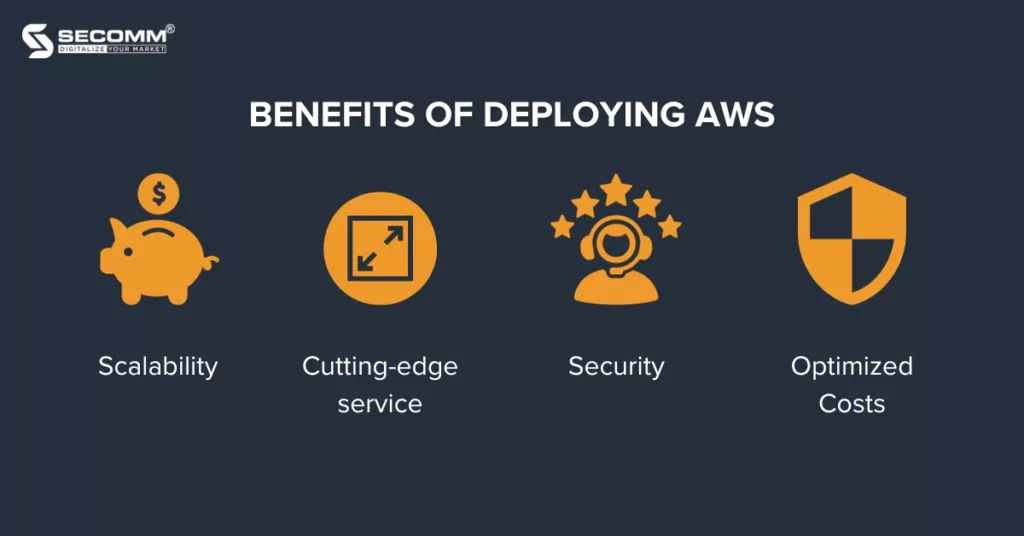
Scalability
AWS provides flexible scalability, enabling businesses to adjust resources according to their needs, whether it involves scaling up to handle high traffic or accommodating growth, all without the need for investments in physical infrastructure.
Moreover, AWS offers effortless integration with various services and technologies through APIs and management tools. This allows AWS to seamlessly integrate its applications with third-party services and incorporate new technologies into the existing system.
Cutting-edge service
With AWS, businesses can leverage cutting-edge technologies to experiment and innovate more swiftly. Since its inception, AWS has consistently introduced novel technologies that businesses can utilize for their digital transformation.
For example:
Back in 2014, AWS led the way in serverless computing with the introduction of AWS Lambda, enabling developers to execute code without the need to provision or manage servers.
In 2017, AWS launched Amazon SageMaker, a managed machine learning service that empowers both developers and data scientists, regardless of their prior experience.
Security
AWS employs an end-to-end approach to secure and fortify its infrastructure, encompassing physical systems, operational systems, and software. AWS adheres to international security standards, offering compliance checks for rules and regulations such as:
- ISO/IEC 27001: The foremost international standard for information security management.
- ISO 9001: A quality management system standard developed and issued by the International Organization for Standardization.
- PCI DSS: A mandatory information security standard for businesses involved in storing, transmitting, and processing payment card data, overseen by five international payment organizations, including Visa, MasterCard, American Express, Discover, and JCB.
Furthermore, AWS extends support to various other security standards and compliance certifications such as CSA, ISO 27017, ISO 27018, SOC 1, SOC 2, SOC 3, and more.
Optimized Costs
AWS employs a pay-as-you-go payment model, allowing businesses to use resources as needed without overspending their budgets.
Furthermore, AWS has earned the trust of many large enterprises due to its optimized costs. For instance, when businesses commit to using an AWS service or a bundle of services up to a specific monetary threshold (measured in USD per hour) over a 1 or 3-year duration, AWS offers more cost-effective solutions than the On-Demand pricing.
Furthermore, businesses can receive volume-based discounts based on the amount of services and resources they utilize within AWS. For example, in the case of Amazon S3, pricing is tiered, meaning the more a business uses, the less it pays per GB.
AWS key services
AWS offers a range of cloud services, below are some key AWS services:
Amazon EC2
Amazon EC2 (Amazon Elastic Compute Cloud) is a flexible cloud computing service that provides virtual servers for running applications. It allows businesses to rent and manage virtual machines to meet their specific needs.
Use cases for Amazon EC2:
- Running cloud-based and on-premises applications: Amazon EC2 provides secure, reliable, high-performance, and cost-effective computing infrastructure to meet business needs.
- Scaling for High-Performance Computing (HPC) applications: Access infrastructure and compute power on-demand to run HPC applications faster and cost-effectively.
- Developing Apple platforms: Build, test, and validate macOS workloads on-demand. Access environments in minutes, dynamically adjust capacity as needed, and benefit from AWS’s pay-as-you-go pricing model.
- Training and deploying Machine Learning (ML) applications: Amazon EC2 offers a collection of computing services, network connectivity (up to 400 Gbps), and specialized storage to optimize price performance for ML projects.

Amazon Simple Storage Service (S3)
Amazon Simple Storage Service (S3) is a cloud storage service that enables businesses to easily store and access data with durability and high reliability.
Use cases for Amazon S3:
- Building a data lake: Run big data analytics, artificial intelligence, machine learning, and high-performance computing applications to unlock deep insights from your data.
- Backup and recovery of critical data: Meet Recovery Time Objectives (RTOs), Recovery Point Objectives (RPOs), and compliance requirements with S3’s robust replication features.
- Cost-effective data storage: Transition data storage to Amazon S3 Glacier storage classes to minimize costs, eliminate operational complexity, and gain new deep insights.
- Running cloud-native applications: Build rapidly deployable, highly mobile, and web-based cloud-native applications that can automatically scale to meet high-demand configurations.

Amazon Aurora
Amazon Aurora is a high-performance managed relational database service built with compatibility for MySQL and PostgreSQL, outperforming other relational database management systems.
Use cases for Amazon Aurora:
- Modernize enterprise applications: Operate enterprise applications like Customer Relationship Management (CRM), Enterprise Resource Planning (ERP), supply chain, and payments with high availability and performance.
- Build SaaS applications: Support reliable, high-performance Software as a Service (SaaS) applications with the ability to scale version and storage capacity flexibly.
- Deploy globally distributed applications: Develop large-scale internet applications, such as mobile games, social networking apps, and online services, requiring scalability and recovery in multiple regions.
- Serverless technology applications: No need to manage capacity manually and only pay for the capacity used, with instant and detailed scalability to save up to 90% on costs.
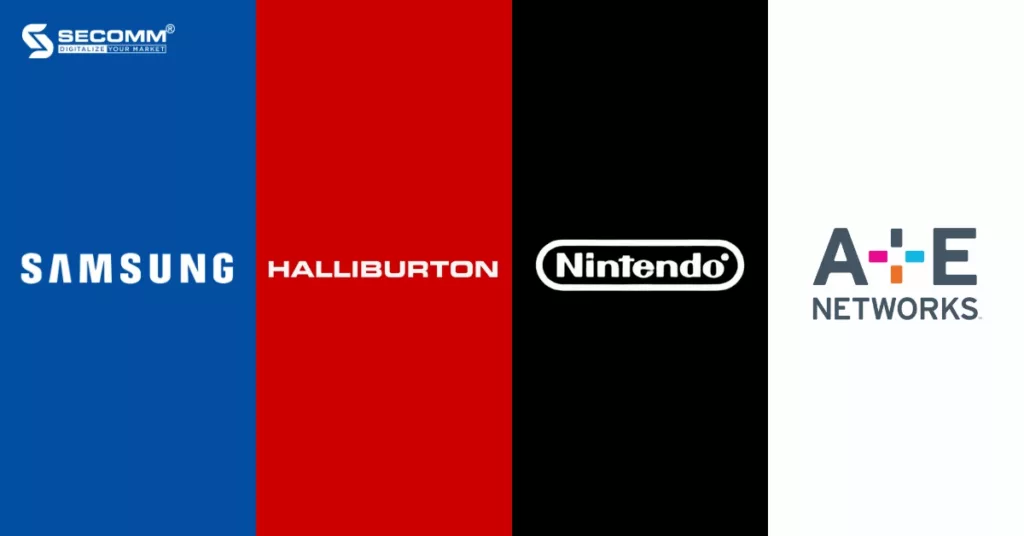
Amazon DynamoDB
DynamoDB is a NoSQL database designed to handle high scalability and low-latency response time applications. Amazon DynamoDB is fully managed, serverless, and designed to run high-performance applications at any scale.
Additionally, DynamoDB provides integrated security features, continuous backups, automatic multi-region replication, in-memory caching, and data loading and exporting tools.
Use cases for Amazon DynamoDB:
- Software application development: Build large-scale internet applications supporting super content user data and caching requirements with high synchronization and connectivity needs for millions of users and millions of requests per second.
- Create a media super data warehouse: Scale throughput and concurrency for media and entertainment workloads such as real-time live video streaming, and interactive content, while delivering lower latency with multi-region replication across AWS regions.
- Provide a seamless retail experience: Use design templates to deploy shopping carts, workflow tools, inventory tracking, and customer profiles. DynamoDB supports high-access events at a massive scale and can handle millions of requests per second.
- Scale gaming platforms: Focus on innovation without operational overhead. Build your gaming platform with player data, session history, and leaderboards for millions of users simultaneously.
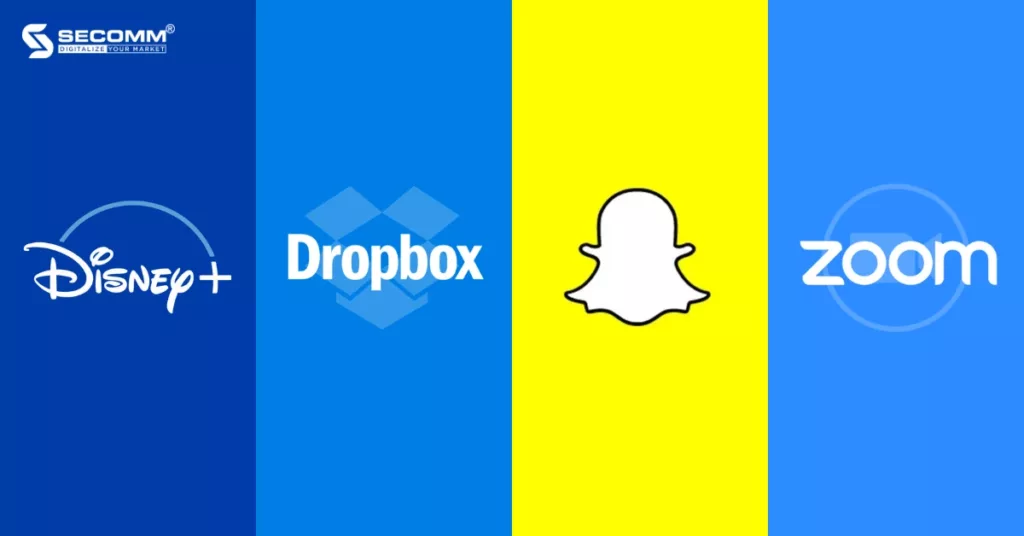
Amazon RDS
Amazon RDS (Amazon Relational Database Service) is a managed relational database service for MySQL, PostgreSQL, Oracle, SQL Server, and MariaDB, designed to set up, operate, and scale relational databases in the cloud with just a few clicks.
Use cases for Amazon RDS:
- Build mobile and web applications: Support developing applications with high availability, throughput, and scalable storage capacity. Take advantage of flexible usage-based pricing policies to suit various types of application usage.
- Migrate to a managed database: Innovate and develop new applications with Amazon RDS instead of worrying about managing your own database, which can be time-consuming, complex, and costly.
- Escape from legacy databases: Free yourself from expensive commercial databases by migrating to Amazon Aurora. When you move to Aurora, you can scale, perform, and make your commercial database highly available at 1/10th the cost.
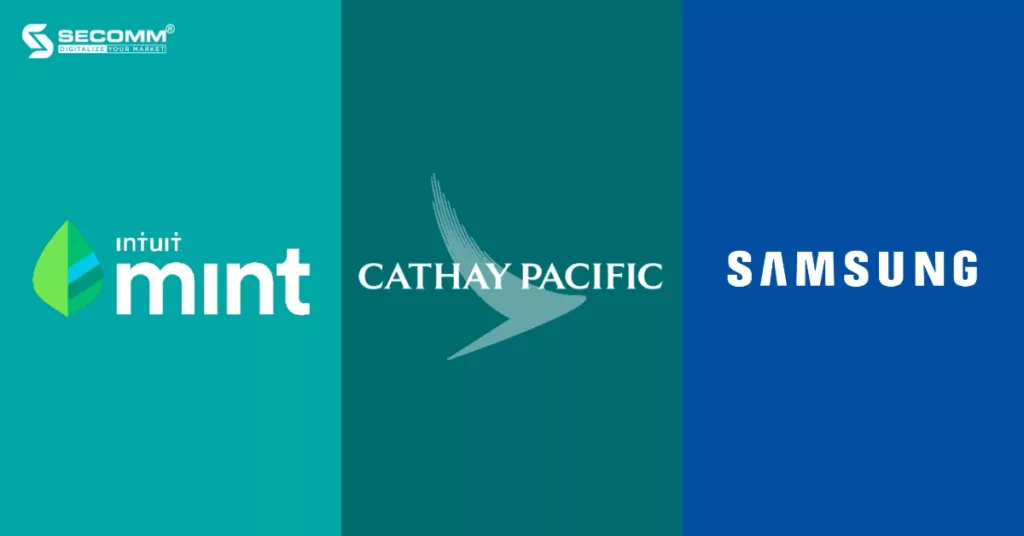
AWS Lambda
AWS Lambda is a serverless computing service that allows businesses to run code without the need to manage servers. AWS Lambda enables businesses to execute code when events occur, optimizing resource usage and reducing costs.
Use cases for AWS Lambda:
- Processing data at scale: Execute code at the capacity you need exactly when it’s required. Scale automatically to match your data volume and trigger custom events.
- Running interactive web and mobile backends: Combine AWS Lambda with other AWS services to create secure, stable, and scalable online experiences.
- Supporting powerful ML insights: Preprocess data before feeding it into your machine learning models. With access to the Amazon Elastic File System, AWS Lambda manages the scaling process and provides infrastructure to simplify scaling adjustments.
- Creating event-driven applications: Build event-driven functions to allow isolated devices to communicate easily with each other. Reduce costs by running applications at maximum demand without incidents or over-provisioning resources.
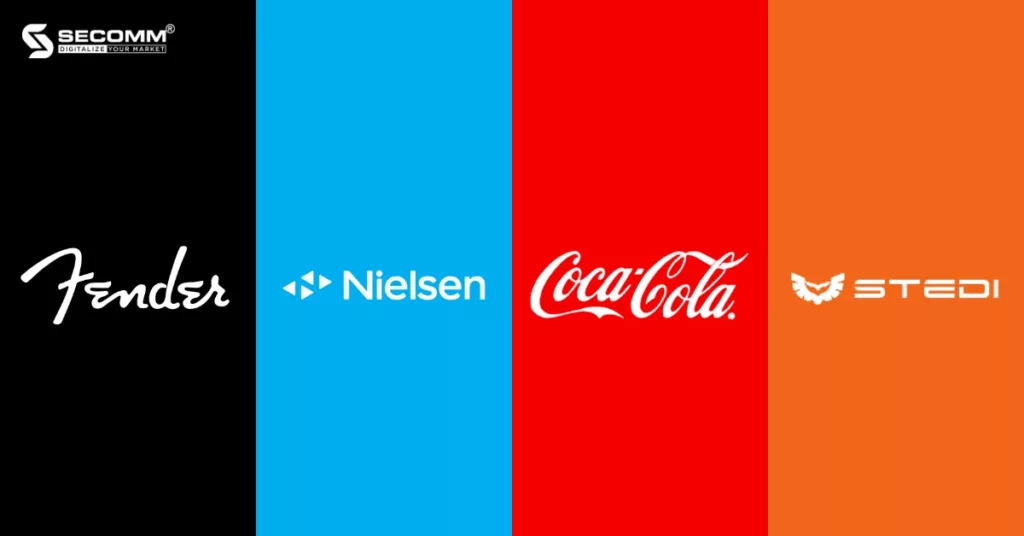
Amazon VPC
Amazon Virtual Private Cloud (Amazon VPC) allows businesses to define and launch AWS resources in a logically isolated virtual network, providing full control over the virtual network environment, including resource placement, connectivity, and security.
Use cases for Amazon VPC:
- Launching a simple website or blog: Enhance the security of your web application by enforcing rules for incoming and outgoing connections.
- Hosting multi-tier web applications: Define connectivity and network constraints between your web servers, application servers, and databases.
- Creating hybrid connections: Build and manage VPC networking compatible with AWS services and your on-premises resources.
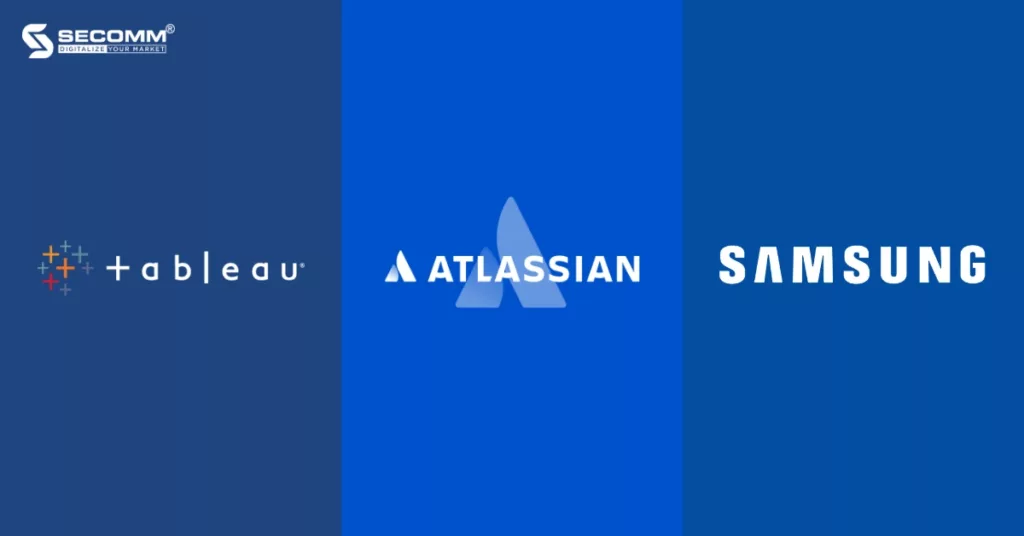
Amazon Lightsail
Amazon Lightsail is an AWS service designed to simplify the deployment and management of applications and websites in the cloud environment. It offers an easy-to-use virtual private server with pre-configured containers, storage capacity, databases, snapshots, and more, all at an affordable monthly price.
Use cases for Amazon Lightsail:
- Launching a simple web application: Use pre-configured development stacks like LAMP, Nginx, MEAN, and Node.js to quickly and easily get your content online.
- Creating custom websites: Build and personalize your personal, e-commerce, or blog website in just a few clicks with pre-configured applications like WordPress, Magento, Prestashop, and Joomla.
- Building applications for small businesses: Kickstart your business software, such as file storage and sharing, backups, financial and accounting software, and more.
- Setting up a testing environment: Easily create, delete, and test development sandboxes and testing environments to experiment with new ideas without risk.
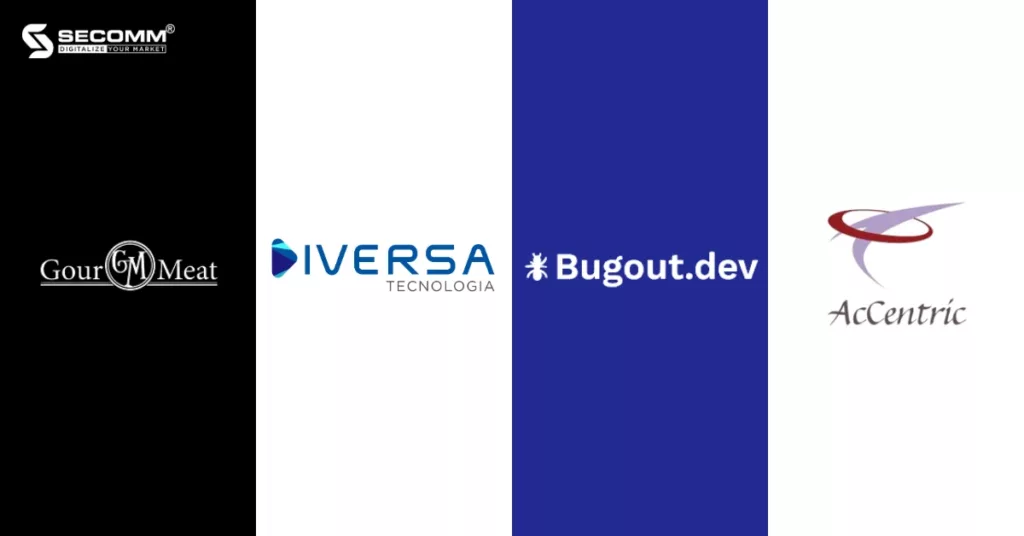
Amazon SageMaker
Amazon SageMaker is a service for building, training, and deploying machine learning models for any use case with fully managed infrastructure, tools, and workflows.
The primary application of Amazon SageMaker is the development of practical machine learning applications, including product recommendations, personalization, smart shopping, robots, and voice-enabled devices.
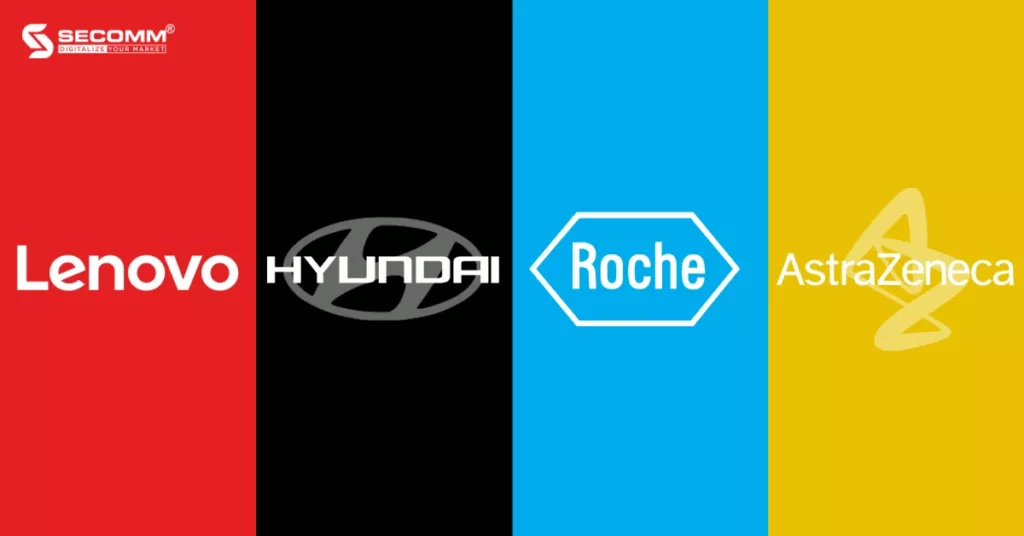
In over 16 years since its establishment to date, AWS has provided cloud services to millions of customers worldwide with a global-scale operational experience. In the near future, AWS may continue to maintain its leading position in this over 60 billion USD market with a market share range of 32-34%.
To learn more about AWS and how to deploy AWS for your business, contact SECOMM or call the Hotline at (02871089908) for a free consultation.
 2
2

 13,355
13,355

 0
0

 1
1
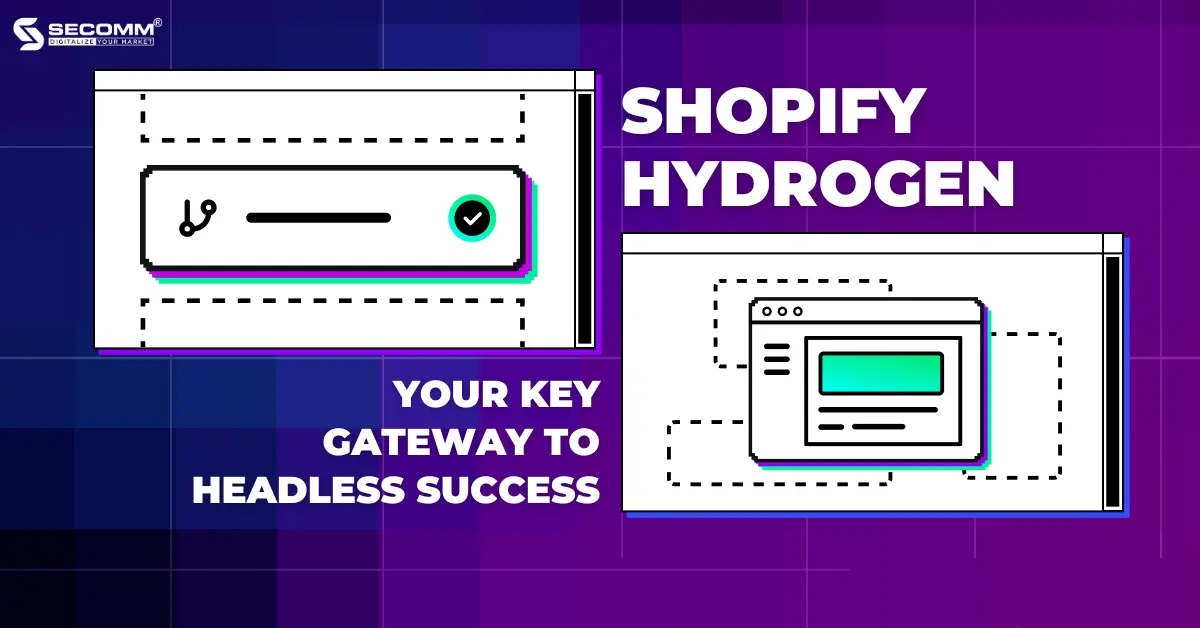
SHOPIFY HYDROGEN: YOUR KEY GATEWAY TO HEADLESS SUCCESS
Table of Contents
Today’s eCommerce consumers are no longer confined to a single channel or device for their shopping needs. They have a ton of options, including mobile apps and social media platforms. As a result, businesses are striving to establish a robust multi-channel presence to swiftly engage with their customers. One highly effective approach to achieving this goal is through the implementation of Headless Commerce.
In recent years, investors have shown a significant interest in Headless Commerce platforms and associated solutions, recognizing their pivotal role in shaping the future of online commerce.
Forbes reports that between 2020 and 2021 alone, more than $1.65 billion in funding was directed toward Headless technologies. In response to this evolving landscape, Shopify unveiled the Hydrogen solution in June 2021, designed to facilitate the development of headless Commerce storefronts.
The following article aims to provide a comprehensive understanding of Shopify Hydrogen, shedding light on both its pros and cons.
Overview
Shopify offers businesses the Hydrogen framework solution, originally based on React but now being developed with Remix, in conjunction with the global hosting solution known as Oxygen.
What is Shopify Hydrogen?
In the past, Shopify website developers utilized the platform’s templating language known as Liquid, which often faced performance limitations. Consequently, to ensure top-notch website performance for headless commerce, Shopify businesses require a specialized solution.
Typically, businesses implementing headless projects on Shopify Plus opt for the React framework over Liquid due to its superior technical aspects. Moreover, headless stores on Shopify Plus offer heightened flexibility, customization, and scalability compared to standard headless stores on Shopify.
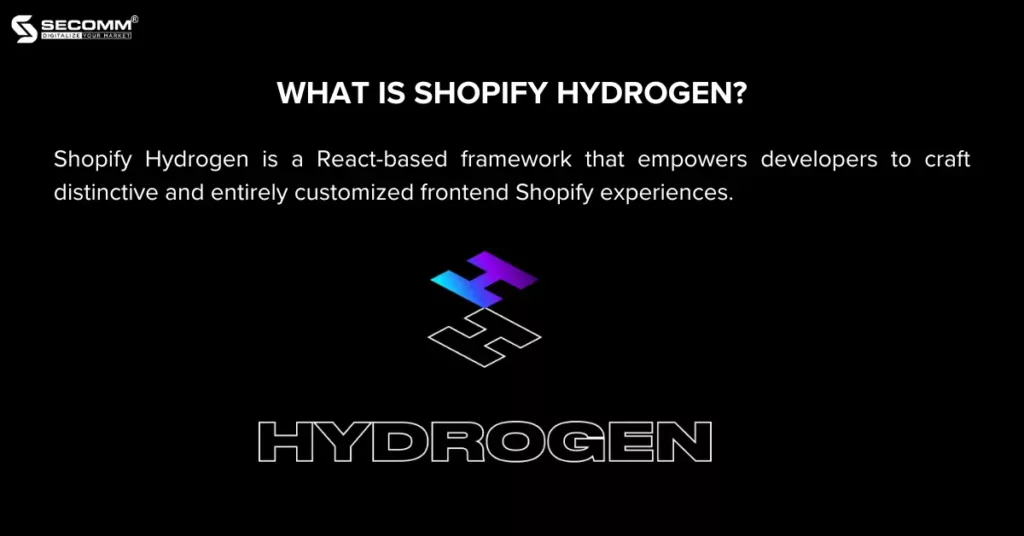
Therefore, Shopify has introduced a solution that allows both Shopify Plus and standard Shopify businesses to build and advance the most optimized headless eCommerce websites possible. This led to the creation of the Hydrogen framework solution and Oxygen hosting.
Shopify Hydrogen is a React-based framework that empowers developers to craft distinctive and entirely customized frontend Shopify experiences. This framework encompasses all the essential structures, components, and pre-built tools necessary for developers to swiftly create headless stores and deliver personalized user experiences.
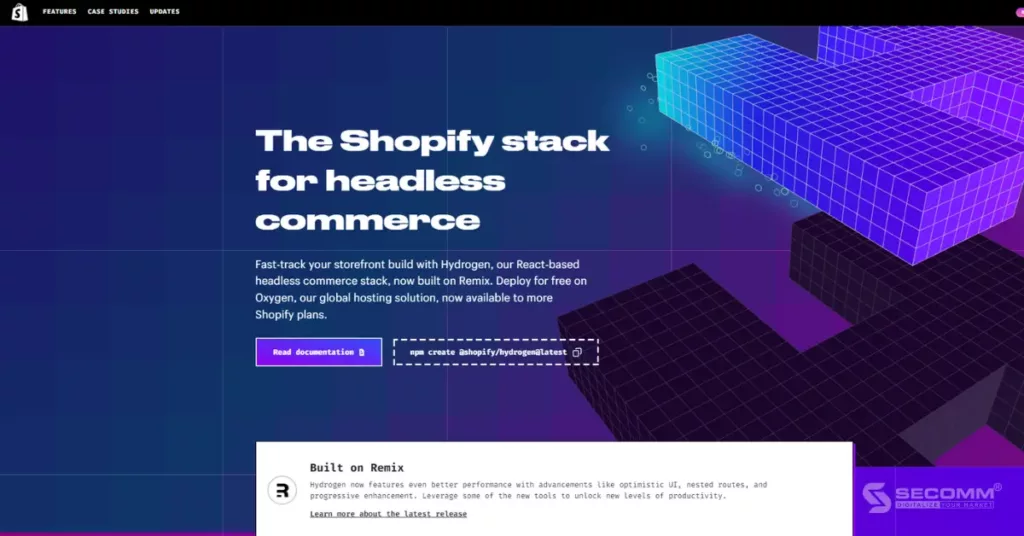
What is Shopify Oxygen?
Shopify Oxygen is a worldwide hosting solution designed to store custom content, like Hydrogen stores, directly within the Shopify platform. Previously, Shopify businesses seeking to develop Headless Commerce had to depend on third-party hosting providers (e.g., Netlify).
In contrast, Oxygen is supported by Shopify’s extensive global infrastructure, featuring over 100 server locations worldwide. Thanks to this, Hydrogen stores can seamlessly and directly integrate with Oxygen hosting through the Storefront API, eliminating the need for reliance on third-party providers.
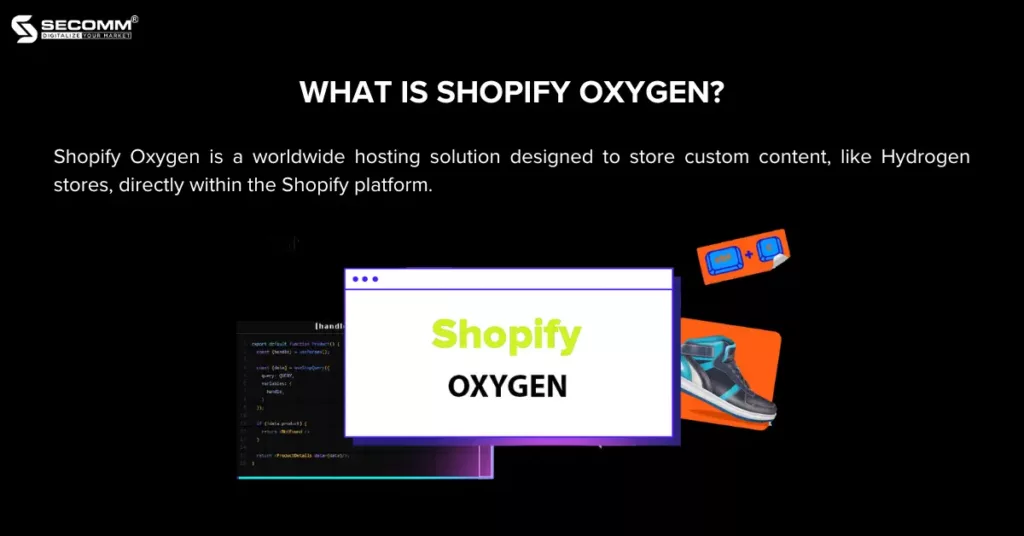
Remix – The New Highlight of Shopify Hydrogen
In the first quarter of 2023, Shopify unveiled Hydrogen v2, highlighting the web development tool called Remix. This tool has earned recognition from developers as one of the top React frameworks, trailing only behind Next.js. Consequently, Shopify acquired Remix and designated it as the cornerstone of the Shopify Hydrogen solution.
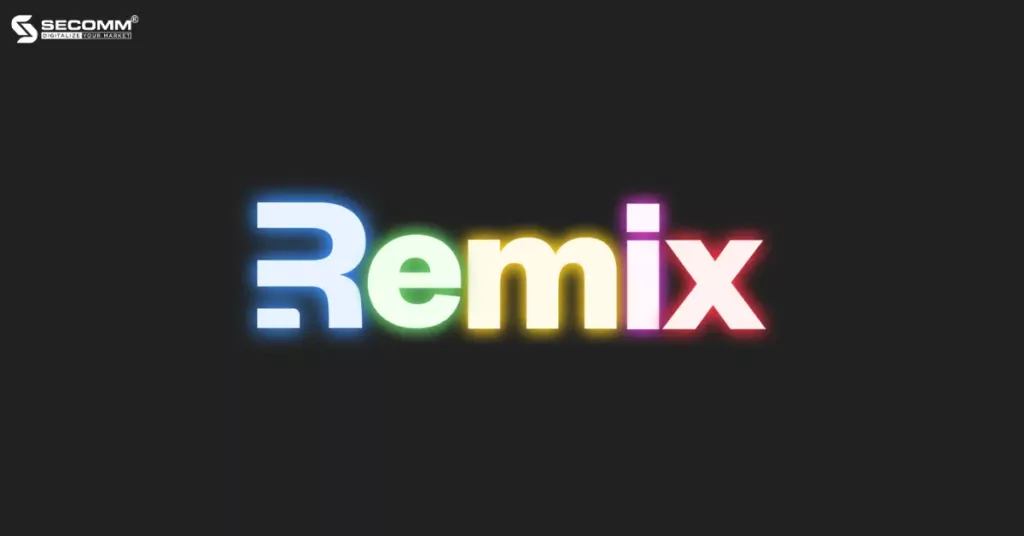
The reason for this lies in the fact that Hydrogen v1 faced performance-related criticisms after some time in operation. The acquisition of Remix is a part of Shopify’s efforts to rectify these issues, leading to the emergence of Hydrogen v2.
While developers tend to favor Next.js over Remix due to its open structure, allowing for greater customization and offering a more favorable developer experience, it doesn’t guarantee output quality and website performance.
Conversely, Remix employs a closed structure that mandates developers to adhere to the framework’s template. This approach closely aligns with Shopify’s SaaS model, providing a web development framework and enforcing developers to follow specific principles during deployment.
This adherence ensures website performance and significantly enhances conversion rates. Therefore, Remix is the ideal solution chosen by Shopify to address the existing performance gaps in Hydrogen stores and enhance the eCommerce experience for customers.
Pros of Shopify Hydrogen
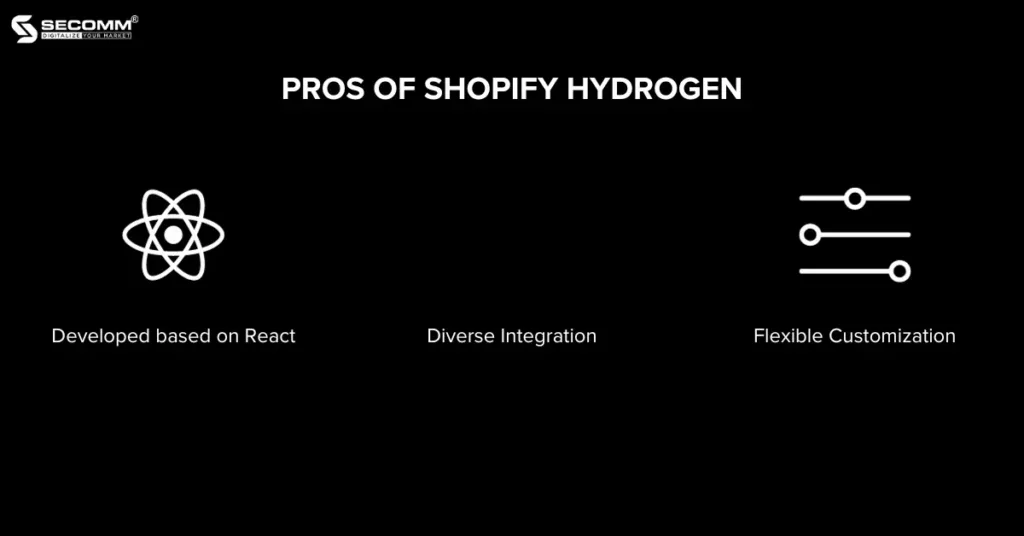
Developed based on React
Hydrogen represents Shopify’s investment in the development of Headless eCommerce. Therefore, it’s fair to classify any Shopify store using the Hydrogen framework and Oxygen hosting as a Headless Shopify store.
The Headless architecture has consistently garnered praise from industry experts, who anticipate its continuous evolution. Shopify’s decision to incorporate React – the JavaScript library for frontend interface development – as the cornerstone of the Hydrogen solution underscores this platform’s forward-looking perspective on the future of eCommerce, firmly rooted in the Headless trend.
Diverse Integration
The launch of Shopify Hydrogen aims to assist businesses in building professional Headless eCommerce websites and providing customers with a seamless multi-channel experience.
Therefore, Shopify extends the capability to seamlessly integrate Hydrogen stores with various third-party applications and platforms like Klaviyo, Gorgias, and Rebuy (to enhance the customer experience), as well as Sanity, Contentful, and Builder.io (for Headless CMS implementation).
Learn more about Headless CMS:
- What is Headless CMS?
- 10 Enterprise Headless CMS Platforms (Pt.1)
- 10 Enterprise Headless CMS Platforms (Pt.2)
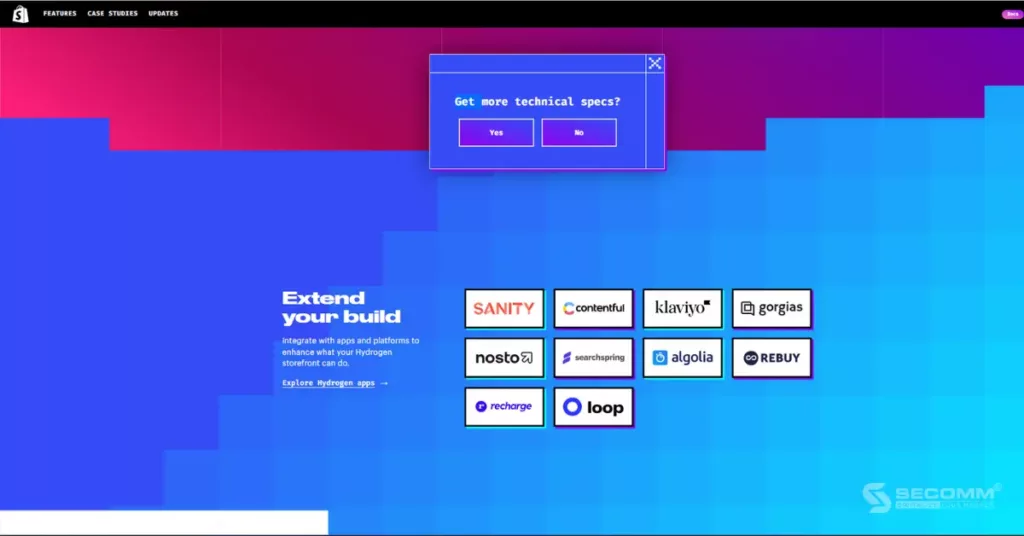
Flexible Customization
Numerous enterprises choose to implement Headless eCommerce because it grants them full control over the development of the frontend interface, free from the limitations of specific platforms. Shopify Hydrogen also empowers businesses to construct entirely personalized headless website interfaces and integrate essential features for expansion.
Cons of Shopify Hydrogen
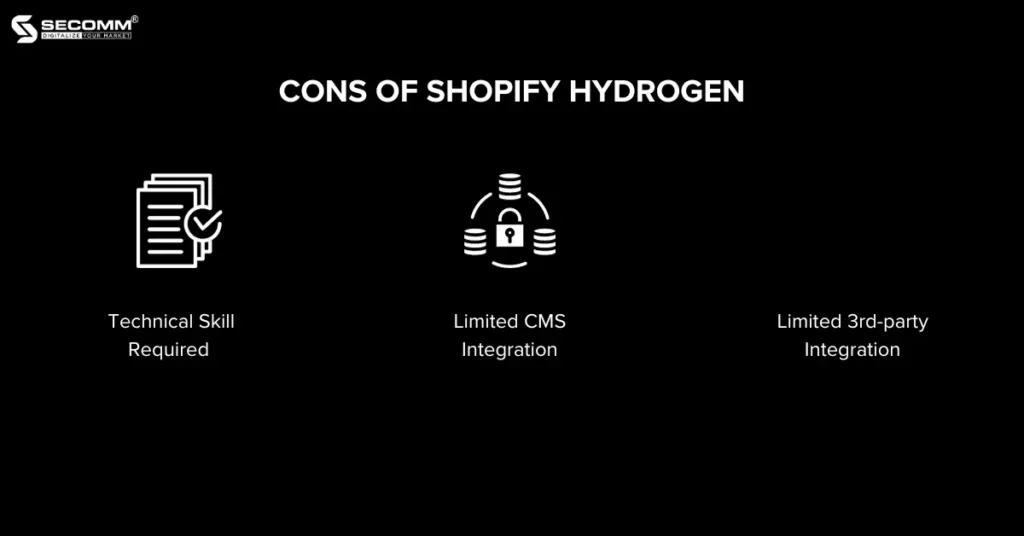
Technical Skill Required
Hydrogen solution empowers businesses to leverage the potential of Headless eCommerce, but it’s predominantly a technically-driven endeavor without a user-friendly drag-and-drop interface for non-technical users to easily access and modify.
Hence, the development process necessitates the engagement of highly proficient developers with programming expertise and a specific comprehension of Hydrogen and Oxygen. In this scenario, businesses have two choices: establish an in-house team of developers or partner with an external specialized entity for swift deployment.
Limited CMS Integration.
Because it relies on the React framework, Hydrogen can assist developers in creating custom frontends, but the backend CMS functionality must be connected to enable the headless eCommerce website’s operation.
However, as of now, Hydrogen is limited to integrating with specific CMS platforms like Sanity, Contentful, and Builder.io, leaving businesses responsible for connecting with others independently.
Limited 3rd-party Integration
Much like CMS platforms, Hydrogen supports businesses in integrating with third-party provider applications, but it has rather limited options. Currently, there are only 13 available applications that businesses can incorporate into their Hydrogen store.
In the many years of implementing Headless eCommerce for numerous clients across various countries, SECOMM has noticed an increasing demand for creating Headless websites using the Shopify platform. Now, businesses have a choice: they can either leverage Shopify’s tech stack (Hydrogen and Oxygen) or build a custom stack tailored to their unique requirements.
This further solidifies Shopify as one of the most flexible eCommerce platforms today, leading the way towards the next generation of eCommerce experiences.
Contact us or call SECOMM’s hotline (02871089908) for a free consultation.
 2
2

 10,467
10,467

 0
0

 1
1
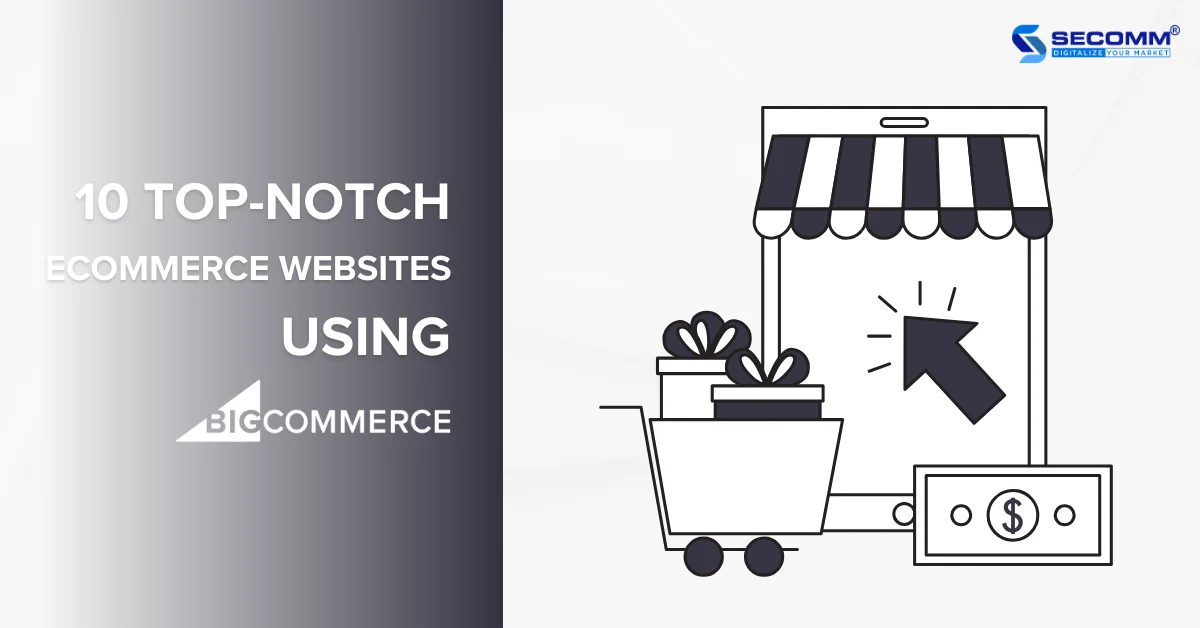
10 TOP-NOTCH ECOMMERCE WEBSITES USING BIGCOMMERCE
Table of Contents
In recent years, BigCommerce has achieved a significant milestone as it emerges as one of the preferred platforms for eCommerce website development among numerous online businesses. According to BuiltWith, there are presently 45,952 operational websites utilizing this platform.
This article will highlight 10 notable eCommerce websites from around the world, spanning various industries, that have adopted BigCommerce for their operations.
Skullcandy
Skullcandy opened its first store in 2015 in Park City, Utah, and it remains the company’s exclusive physical retail location in the United States due to its primary online sales strategy. Skullcandy is a technology brand known for crafting headphones and speakers with a youthful and modern style. Their eCommerce website is developed using the BigCommerce platform.
Aside from seasonal promotions, Skullcandy provides customers with diverse payment choices, including PayPal, VISA, MasterCard, and even a Buy Now, Pay Later option through Klarna.

- Industry: Consumer Electronics
- Website: https://www.skullcandy.com/
- Traffic: 1.1M/month
- Ranking: 15,365 (USA) & 58,348 (Worldwide)
BURROW
BURROW is an online furniture brand that specializes in offering seasonal furniture and sofas with a minimalist, modern, and vibrant style. The company’s approach revolves around three key principles to deliver unique value to customers. First and foremost, they have built their eCommerce website on the BigCommerce platform, encouraging online shopping through enticing promotions, illustrative product videos, and free shipping. Secondly, their products are known for their custom designs, high durability, multifunctionality, compactness, portability, and versatility to fit into various spaces. Lastly, BURROW places a strong emphasis on building a community that connects customers from all around and enhancing brand awareness.

- Industry: Furniture
- Website: https://burrow.com/
- Traffic: 699.5K/month
- Ranking: 11,978 (USA) & 64,922 (Worldwide)
LARQ
LARQ is renowned for its stylish and compact reusable water bottles, designed with sustainability in mind. These bottles are manufactured using advanced technologies like PureVis and NanoZero to ensure high water quality. LARQ’s bottles possess self-cleaning capabilities, utilizing UV-C LED lights to eliminate up to 99.99% of bacteria.
These exceptional features led to a significant $1 million investment from Shark Tank. LARQ has developed its eCommerce website using BigCommerce, complete with a dedicated Basq Magazine section where they share valuable insights on hydration with their customers.
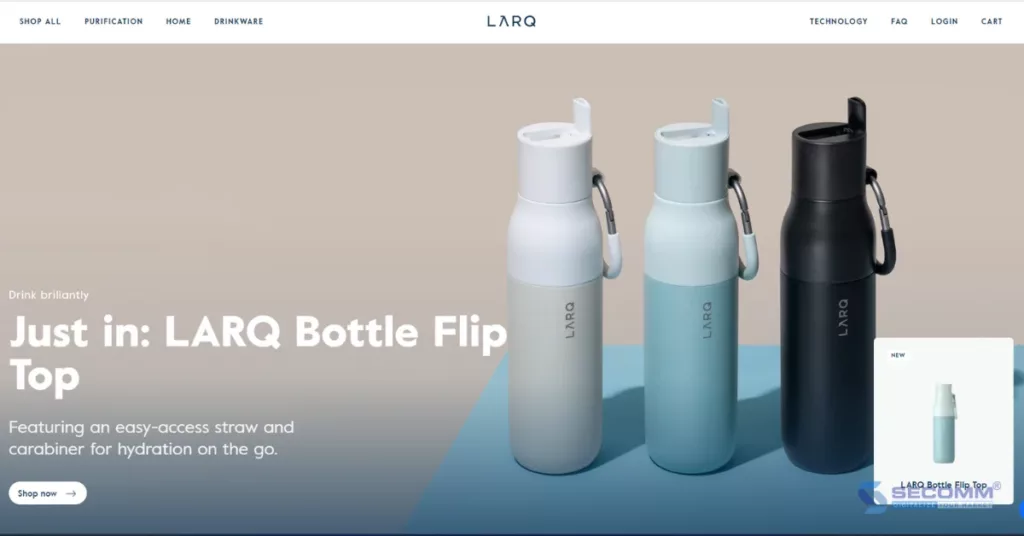
- Industry: Consumer Goods
- Website: https://www.livelarq.com/
- Traffic: 421K/month
- Ranking: 75,050 (USA) & 144,129 (Worldwide)
Molton Brown
The premium beauty brand, Molton Brown, hailing from the UK, has also used the BigCommerce platform to build their eCommerce website. Their product range, spanning fragrances, hand washes, essential oils, scented candles, and bath & body products, is entirely manufactured in the UK and is cruelty-free. Their product packaging is crafted from high-quality reusable glass, adhering to eco-friendly standards.
At present, the company exclusively offers online shopping services to customers in the US, Japan, and the majority of European regions. Molton Brown consistently introduces seasonal collections, special occasion sets, gender-specific product lines, and personalized gift recommendations, simplifying the shopping experience for their customers.

- Industry: Beauty and Personal Care
- Website: https://www.moltonbrown.com/store/index
- Traffic: 219.7M/month
- Ranking: 67,310 (USA) & 223,381 (Worldwide)
Tommie Copper
Tommie Copper is a brand that specializes in offering comfortable, lightweight fashion products designed to reduce pain and aid in functional recovery for both men and women. With a strong emphasis on expanding online sales, the company has invested significantly in its eCommerce website using the BigCommerce platform. They have also implemented various customer engagement programs to encourage more shopping. One notable initiative is the Customer Loyalty Program, featuring three tiers: Score, Performance, and Pro-Grade, with detailed and precise instructions on point accrual and redemption.

- Industry: Fashion
- Website: https://www.tommiecopper.com/
- Traffic: 217.8M/month
- Ranking: 34,370 (USA) & 202,065 (Worldwide)
Saddleback Leather
Saddleback Leather is a company specializing in handcrafted leather goods, and they develop their eCommerce website with BigCommerce. Their product range is extensive, encompassing items such as bags, backpacks, belts, and even intricately designed mouse pads. Visitors to their website are greeted with a distinct “Texan” design aesthetic and captivating narratives. Notably, customers can also become part of the Saddleback Club, granting them access to exclusive and appealing member-only offers.

- Industry: Leather Goods and Accessories
- Website: https://saddlebackleather.com/
- Traffic: 167.4M/month
- Ranking: 64,319 (USA) & 266,752 (Worldwide)
Barron Designs
Barron Designs stands as a top-tier brand specializing in the design and provision of premium interior and exterior products crafted from high-quality materials like wood, tiles, and stone. Their diverse product range includes wooden doors, stone fireplaces and chimneys, mailbox posts, engineered wood panels, and more. Barron Designs has developed its eCommerce website using the BigCommerce platform, offering a multitude of features to ensure the best shopping experience for customers.
When customers browse and click on their favorite products to view details, they can choose colors and select options such as fire resistance and UV protection before placing an order. The production and delivery times typically range from 2 to 4 weeks. For those interested in sampling a product, they can simply click on the option, and a complimentary mini-size sample will be sent to their doorstep. Furthermore, a discount coupon will be emailed to encourage customers to make a full-size purchase.

- Industry: Interior and Exterior Interior Design & Construction
- Website: https://www.barrondesigns.com/
- Traffic: 138.5M/month
- Ranking: 63,234 (USA) & 365,842 (Worldwide)
SugarBoo & Co
SugarBoo & Co is a well-known BigCommerce eCommerce website that offers a wide range of handmade products for personal and household use. It offers a diverse range of handmade products for both personal and household use, including items like notebooks, decorative pieces, ceramic dishes, baby toys, and more. To provide an excellent online shopping experience, the company offers multiple payment methods, including well-known options like ShopPay and AfterPay.
SugarBoo & Co’s blog section is filled with interesting content, regularly sharing tips on gift selection, the advantages of using ceramic products, home decorating ideas, and more. Plus, during special occasions and holidays, the website provides customers with a selection of discounted shopping suggestions.
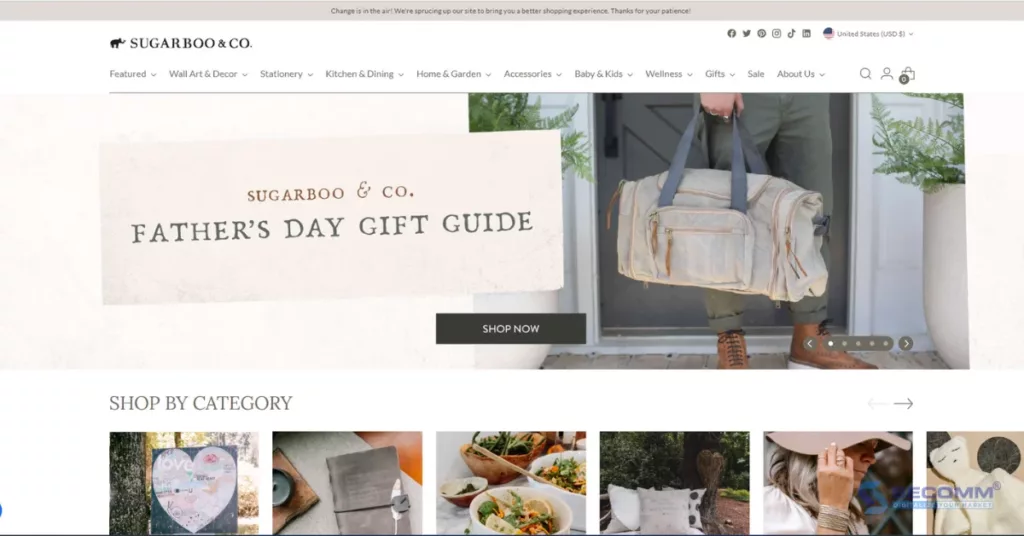
- Industry: Retail
- Website: https://sugarbooandco.com/
- Traffic: 43.3M/month
- Ranking: 341,993 (USA) &934,576 (Worldwide)
Autograph Foliages
Autograph Foliages is a prominent brand in the United States, specializing in landscaping solutions for both homes and commercial establishments. The company offers a diverse range of collections, including seasonal and holiday-themed foliage like Christmas decorations, catering to the needs of families and businesses. What sets Autograph Foliages apart is its enduring partnerships with major entities such as Walt Disney World, Universal Studio, Warner Bros, and Seaworld Parks & Entertainment, a testament to the superior quality of its foliage products.
Their website, developed on the BigCommerce platform, prominently displays new and seasonal products. To access the pricing details for specific items, customers must register an account on the website. They can also subscribe to receive weekly newsletters containing valuable tips on plant care, decoration, and more.
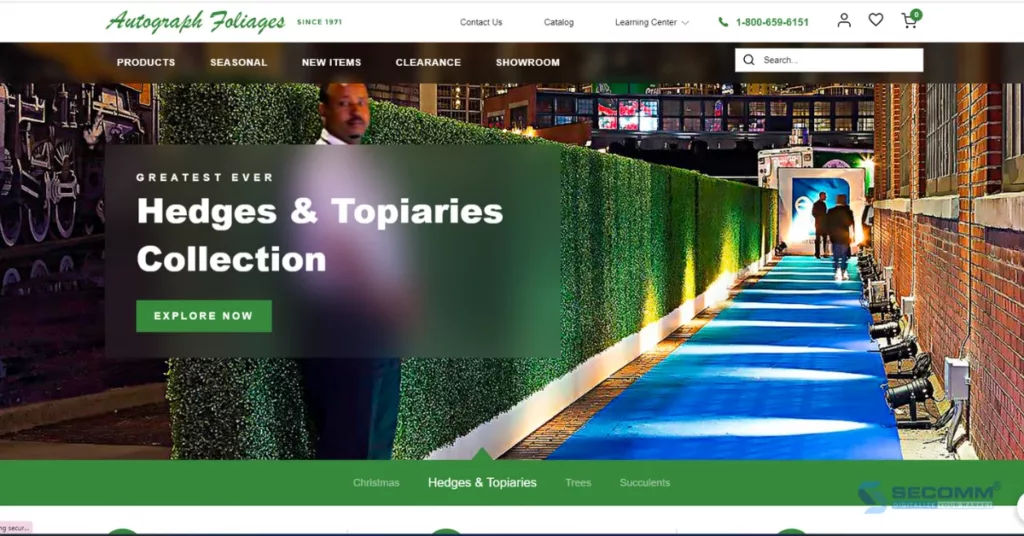
- Industry: Artificial Plants and Trees
- Website: https://autographfoliages.com/
- Traffic: 24.9K/month
- Ranking: 260,791 (USA) & 1,441,394 (Worldwide)
Body Bliss
Established in 1999 and officially launched its products in 2000, Body Bliss specializes in a wide range of personal care items. With over two decades of development, the company has continually researched and refined its products to prioritize customer health, using gentle and environmentally friendly ingredients.
Body Bliss’s BigCommerce website follows a minimalist design, featuring well-organized product categories for easy customer navigation. The site also offers appealing incentives such as complimentary gifts and free shipping. Furthermore, the company uses Instagram to engage with customers and it is seamlessly integrated into the website to keep customers updated on the latest updates.

- Industry: Cosmetics
- Website: https://bodybliss.com/
- Traffic: 7.1K/month
- Ranking: 3,416,815 (USA) & 9,843,202 (Worldwide)
This is SECOMM’s summary and review of 10 eCommerce websites that have achieved success using the BigCommerce platform, effectively capturing customers and leading in their industries.

Related content: BigCommerce 2023: Pricing, Features, Pros and Cons
With a wealth of experience helping clients in various countries deploy eCommerce, SECOMM specializes in providing consulting services with professional eCommerce deployment solutions.
Get in touch with SECOMM or call the hotline at 02871089908 today to receive free support and expert guidance.
 2
2

 3,353
3,353

 0
0

 1
1

BIGCOMMERCE 2023: PRICING, FEATURES, PROS AND CONS
Table of Contents
BigCommerce is one of the most popular eCommerce website-building platforms today. Its flexibility, user-friendliness, cost-effectiveness, and a wide array of built-in tools and features make it a preferred choice for businesses of all sizes.
This article aims to clarify the definition of BigCommerce, its features, pros and cons to provide businesses with valuable insights into the multitude of platforms available for selection.
What is BigCommerce?
Established in 2009, BigCommerce is a user-friendly platform tailored for businesses of all sizes and technical expertise to start developing their own eCommerce websites. Over the years, BigCommerce has emerged as one of the most feature-rich platforms, encompassing all the essentials for website creation, search engine optimization, marketing, and more, all at a cost-effective implementation.
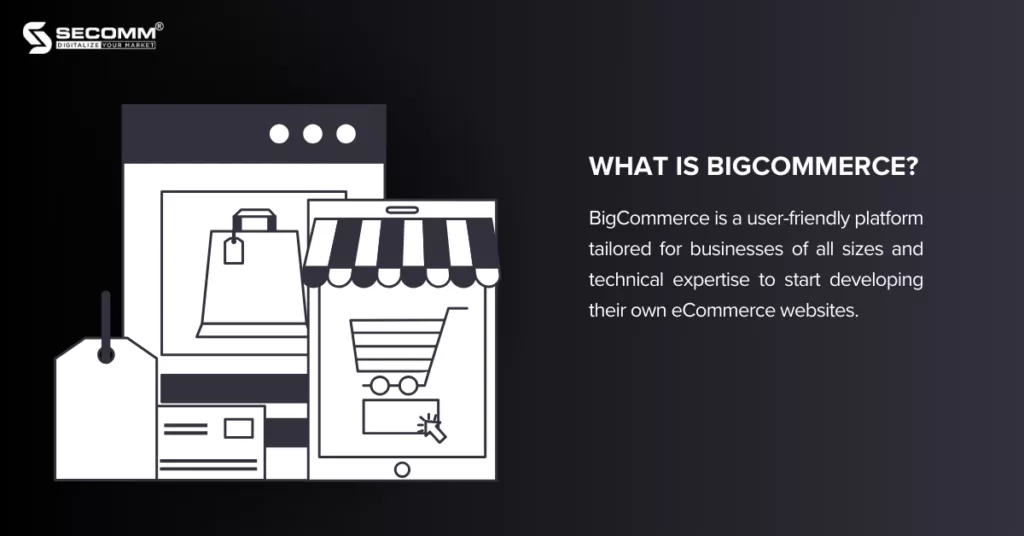
In addition, BigCommerce is known as a SaaS eCommerce solution, which means businesses subscribe on a monthly basis, and the platform takes care of hosting, maintenance, and system security matters.
BigCommerce Pricing Plans
BigCommerce provides three pricing plans tailored for small and medium-sized businesses (Standard, Plus, Pro), priced between $29 and $299 per month, each equipped with essential features. Moreover, the platform offers a customizable plan (Enterprise) for large businesses based on their deployment requirements.
The table below illustrates the cost variations among these four pricing plans and includes some relevant factors:
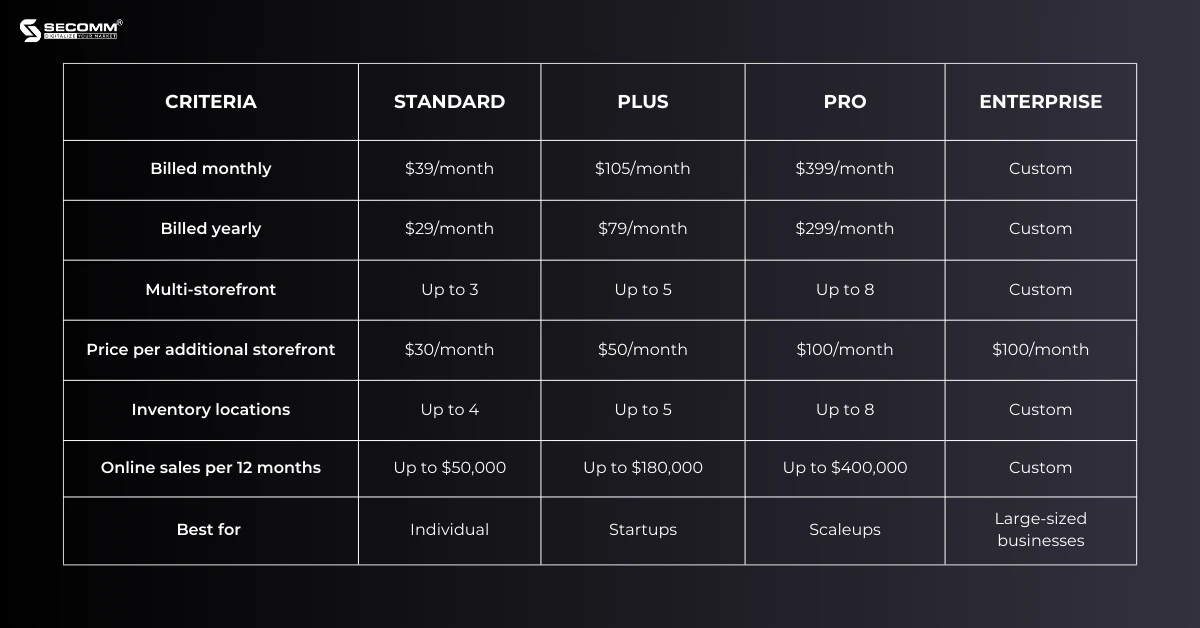
Despite several differences, all four packages share some common points:
- No transaction fee
- Unlimited bandwidth, products, file storage
- Unlimited staff accounts
- 24/7 customer support
- 12 free themes
BigCommerce Features
Included in all plans
Key features of BigCommerce, available in all four pricing plans, include:
- Point of Sale (POS): Seamless integration of online and offline sales with POS systems like Vend, Square, Clover, and more.
- Mobile-Responsive Design: Websites are designed to adapt and perform well on mobile devices.
- BigCommerce Mobile App: Manage orders, track customer journeys, and monitor performance via the user-friendly BigCommerce mobile app, downloadable from the App Store or Google Play.
- Single-Page Checkout: Simplify the payment process with a single-page checkout, reducing cart abandonment and boosting conversion rates.
- Promotions and Discounts: Easily create and manage coupons, discounts, and gifts without the need for third-party integrations.
- Built-In Blog: Improve SEO and engage customers with a built-in blog.
- Product Ratings and Reviews: Gather customer feedback to enhance products and services.
- Multi-Currency Support: Accept over 100 currencies and local payment methods.
- Professional Reporting Tools: Access professional analytics and reporting tools for performance evaluation and adjustment.
- Real-Time Shipping Quotes: Provide accurate shipping costs in real-time from various carriers.
- Free Site-Wide HTTPS & SSL: Ensure website security with free HTTPS protocol, creating a safe shopping environment for customers.
Features
The features available in the ‘Standard’ plan are consistent across all four pricing plans. However, there are some advanced features that are not included, and businesses may need to consider upgrading their plan to access these specific features. Here’s a breakdown:
- Plus:
In addition to the ‘Standard’ features, this plan offers:
- Cart abandonment features.
- Stored credit cards for future purchases.
- Customer groups and segmentation for pricing, product recommendations, targeted promotions, and personalized experiences.
- Top social & marketplace: Integration with top e-commerce platforms and social networks such as Amazon, Facebook, Instagram, etc.
- Pro:
The ‘Pro’ plan encompasses all ‘Standard’ and ‘Plus’ features, along with:
- Google customer reviews for collecting and showcasing customer feedback on Google.
- Advanced product filtering to enhance the shopping experience.
- Custom SSL integration with third-party SSL services.
- Enterprise:
Designed for large-scale enterprises, this top-tier package includes all features from the previous packages and introduces several advanced capabilities:
- Unlimited API calls, facilitating seamless data sharing between eCommerce websites and third-party applications without any limitations.
- Priority support with personalized assistance, including dedicated API support.
Pros of BigCommerce
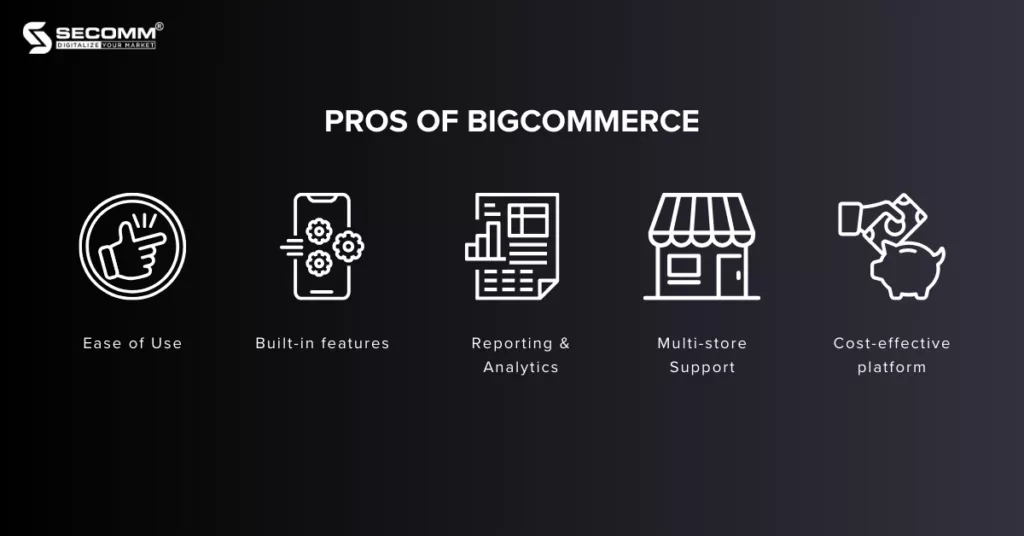
Ease of Use
BigCommerce, designed as a SaaS platform, boasts user-friendliness catering to both tech-savvy and non-technical users. It offers a wide range of themes to facilitate swift website development and provides an array of tools for executing promotional campaigns.
Built-in features
When compared to other SaaS platforms, BigCommerce stands out for its capacity to offer a comprehensive set of built-in features and tools across its pricing plans. This results in cost savings for businesses, reducing their reliance on third-party applications and plugins, which can often incur extra expenses. Moreover, these features have been fine-tuned to boost performance and streamline the eCommerce management process.
BigCommerce also provides its users with the BigCommerce mobile app, enhancing the convenience of managing, monitoring, and updating their eCommerce websites.
Reporting & Analytics
Unlike Shopify, which offers a range of reports and analytics based on the pricing plan chosen, BigCommerce provides professional-level reporting and analytics across all its solution packages. These encompass customer reports, sales reports, financial reports, marketing reports, and more. Moreover, for businesses in need of more extensive data capabilities, BigCommerce offers a wide app library for easy integration with third-party software
Multi-store Support
BigCommerce distinguishes itself from competitors by providing multi-store support across all of its pricing plans. This feature is especially advantageous for businesses that operate multiple stores or are active in various segments, such as B2B and B2C. With the Standard plan, a business can create up to 3 stores, while the Plus and Pro plans allow for 5 and 8 stores, respectively. In contrast, Shopify, a leading SaaS platform, offers multiple store capabilities exclusively through its Shopify Plus solution, which starts at a monthly cost of $2,000.
Cost-effective platform
Using BigCommerce helps businesses save costs in various aspects such as hosting, maintenance, updates, and security. BigCommerce handles these tasks, eliminating the need for additional expenses. Regardless of the chosen pricing plan, BigCommerce doesn’t impose transaction fees, provides unlimited bandwidth and file storage without extra charges, and permits the creation of an unlimited number of staff accounts.
In addition, compared to Shopify, where businesses may incur significant costs to integrate third-party apps and utilities for enhanced functionality, BigCommerce includes essential features tailored to each plan. This integrated approach results in significantly more cost-efficient operations.
Cons of BigCommerce
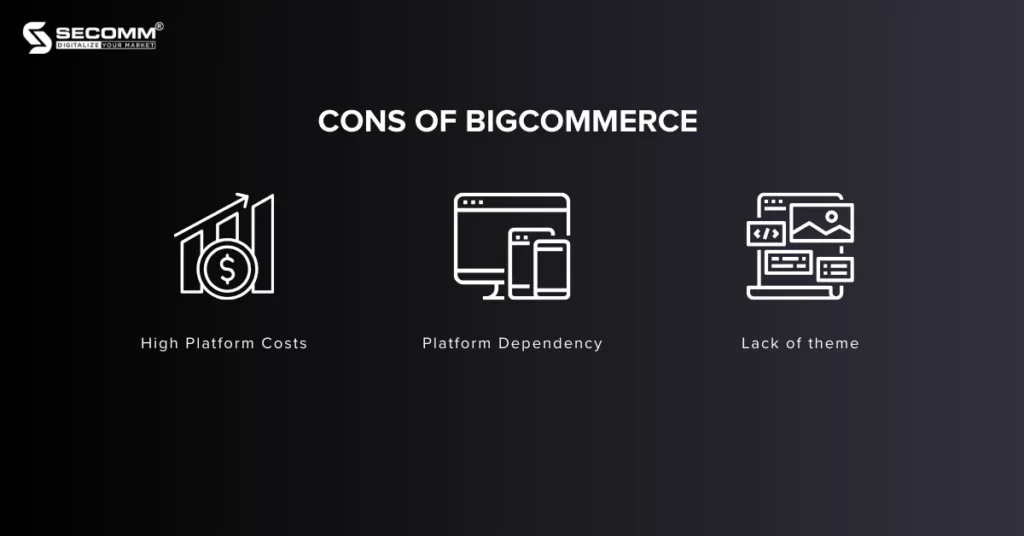
High Platform Costs
When compared to other SaaS platforms like Shopify or Squarespace, the cost of using the BigCommerce platform seems relatively higher.
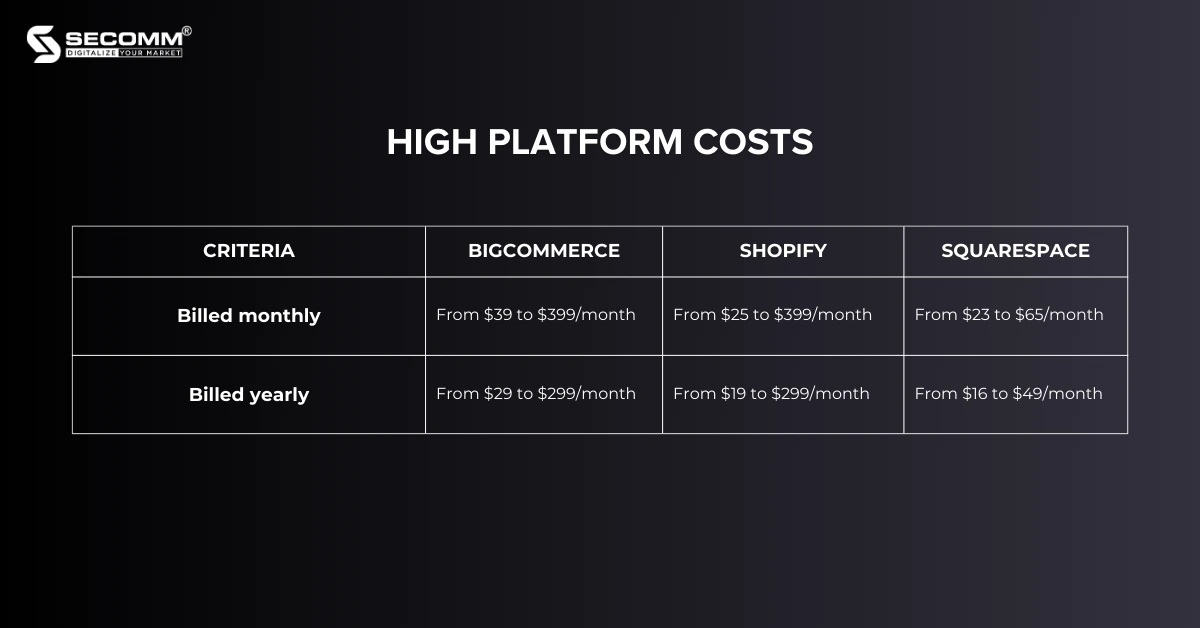
Plus, businesses must continue to pay this ongoing fee along with any charges for third-party services (if applicable) on a monthly basis, without ownership or control over the source code and system data.
On the other hand, open-source platforms such as Magento or OpenCart require businesses to make a one-time payment for both usage and service integration fees, granting them long-term ownership of the source code and system data.
Platform Dependency
Just like other SaaS eCommerce platforms in the market, BigCommerce retains ownership and control over the source code and data of the entire eCommerce website system.
In practical terms, this means that all of a business’s eCommerce data becomes closely tied to BigCommerce’s database. Therefore, if a business wishes to migrate to another platform in the future, it can only access CSV files containing a portion of its data.
Additionally, while it’s exceptionally rare, in the unlikely event that BigCommerce were to suddenly cease all operations, all data related to a business’s activities on this platform could potentially be lost.
Lack of theme
At the time of writing, BigCommerce provides users with a selection of 12 free themes and approximately 180 paid themes. This count is somewhat limited in comparison to other SaaS platforms like Wix or Squarespace.
The free themes come with modern and professional interfaces, suitable for businesses to start their eCommerce website journey. However, these themes are quite similar to each other, differing mainly in color schemes.
In reality, despite the claim of having 12 themes, users often discover only around 5-6 truly distinctive options.
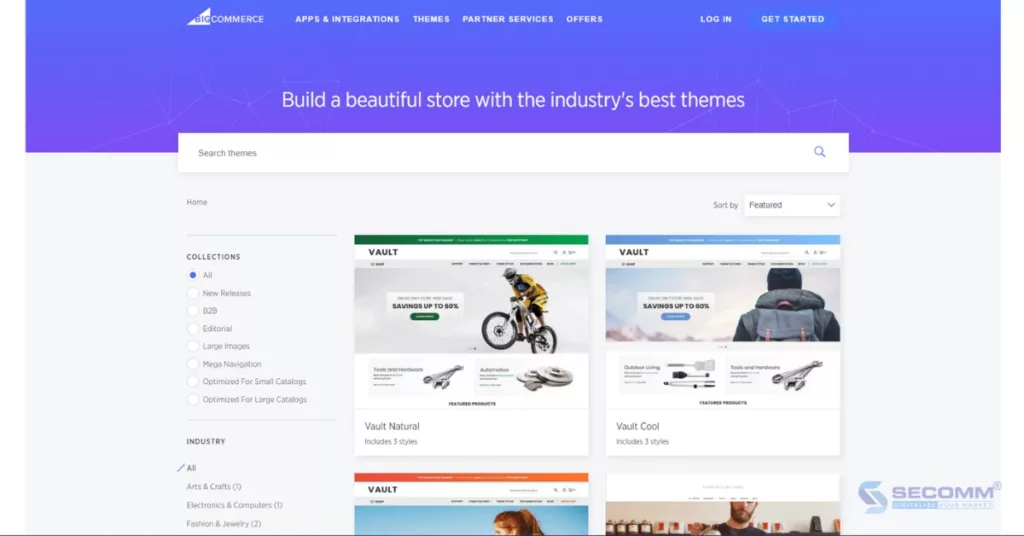
The paid themes, on the other hand, come with a price tag ranging from $195 to $395, and some of them may have similar designs.
However, BigCommerce offers a significant advantage: all the free and paid themes are visually appealing and highly responsive. This means that these themes can automatically adapt their layouts to suit various screen sizes, including smartphones, tablets, desktop computers, and more.
- Related content: 10 Top-notch eCommerce Websites Using BigCommerce
For many years providing eCommerce solutions for clients across the globe, SECOMM has observed a growing trend when it comes to eCommerce website development, particularly on the BigCommerce platform.
To gain a deeper understanding of BigCommerce and how to deploy it the right way, feel free to reach out to us or call our hotline at 02871089908 for free consultations.
 2
2

 7,113
7,113

 0
0

 1
1

5 POS SOFTWARE FOR SMALL & MEDIUM-SIZED ENTERPRISES IN 2023
Table of Contents
Point of Sale (POS) is a system employed by businesses to handle sales transactions, monitor inventory levels, manage customer relationships, generate revenue reports, and conduct business analysis, among other functions. By implementing POS, businesses, particularly SMEs, gain a comprehensive understanding of their operational activities and streamline their management processes.
In this article, SECOMM will evaluate and compare the five most widely-used POS software solutions among small and medium-sized enterprises, including Clover, KORONA POS, KiotViet, and POS365.
Clover
Clover is a POS software developed by Clover Network Inc, aimed at offering an integrated solution for handling sales and payments for both small and medium-sized businesses. Clover provides POS solutions across various industries, including restaurants, services, retail, and more. Specifically, the costs associated with implementing Clover’s POS for retail SMEs are categorized into three primary packages:
- Starter: $799 + $14.95 per month (One-time payment option available) or $60 per month (Monthly payment option) – This package includes an 8″ merchant-facing POS.
- Standard: $1,799 + $49.95 per month (One-time payment option available) or $135 per month (Monthly payment option) – This package includes a 14″ merchant-facing POS
- Advanced: $2,398 + $64.90 per month (One-time payment option available) or $185 per month (Monthly payment option) – This package includes a 14″ merchant-facing and a handheld POS.
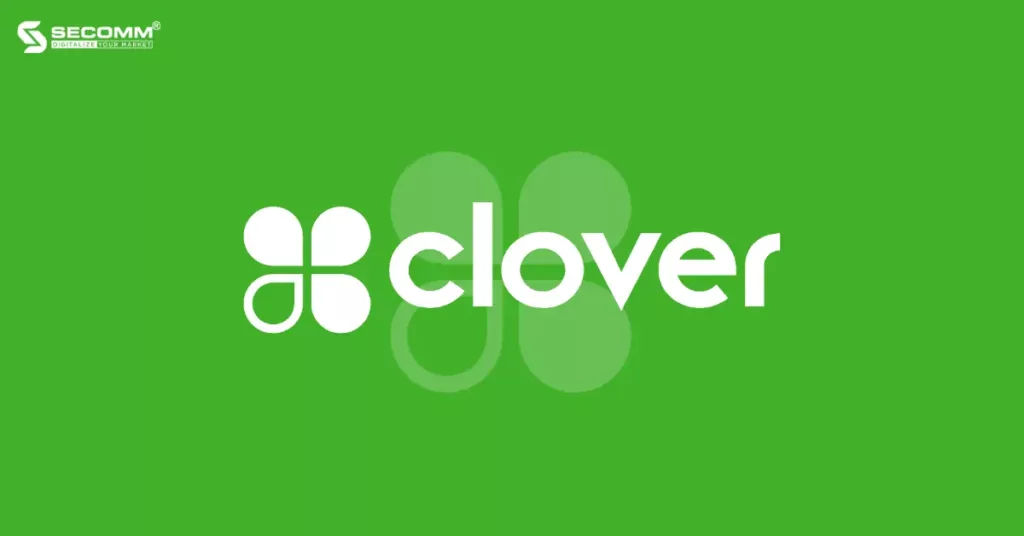
Pros
Ease of Use: The Clover interface is intuitive and user-friendly, making it easy to navigate on the touchscreen and access system functions.
Customization: Users have the flexibility to tailor the interface and configure the system to meet their individual needs. This includes modifying screen layouts, customizing function buttons, and setting options to align with specific business operations.
Offline Support: Clover is equipped to function offline, a valuable feature in the event of an internet connection disruption. Transaction data is securely stored and automatically synchronized once connectivity is restored, ensuring uninterrupted business operations.
Cons
High Initial Costs: Clover carries a higher initial price tag compared to alternative POS solutions, particularly for businesses choosing the comprehensive payment package. This may pose a barrier for smaller businesses operating with limited financial resources.
Invoice Formatting Limitations: Clover has some limitations regarding invoice formatting and customization, which can pose challenges for businesses with specific requirements for invoice formats and content. For example, adding special liquor consumption taxes, collecting stamps on invoices for grocery stores, and so on.
Rely on the Clover Ecosystem: Clover POS functions optimally within the Clover ecosystem and may not seamlessly integrate with diverse management systems such as CRM, ERP, etc., offered by different brands.
Korona POS
KORONA POS is a retail system developed by KORONA, intended to assist in sales management, payments, and inventory control for small and medium-sized businesses.
Currently, KORONA POS offers a range of solution packages for businesses to select from:
- Core: $59 per month – Suitable for small businesses or individuals managing a single store.
- Advanced: $69 per month – Geared towards small and medium-sized businesses handling a single store and inventory tracking.
- Plus: $89 per month – Ideal for small and medium-sized businesses managing multiple stores and keeping track of inventory.
- Enterprise: Custom Quote – Tailored for medium-sized businesses with specific customization requirements.
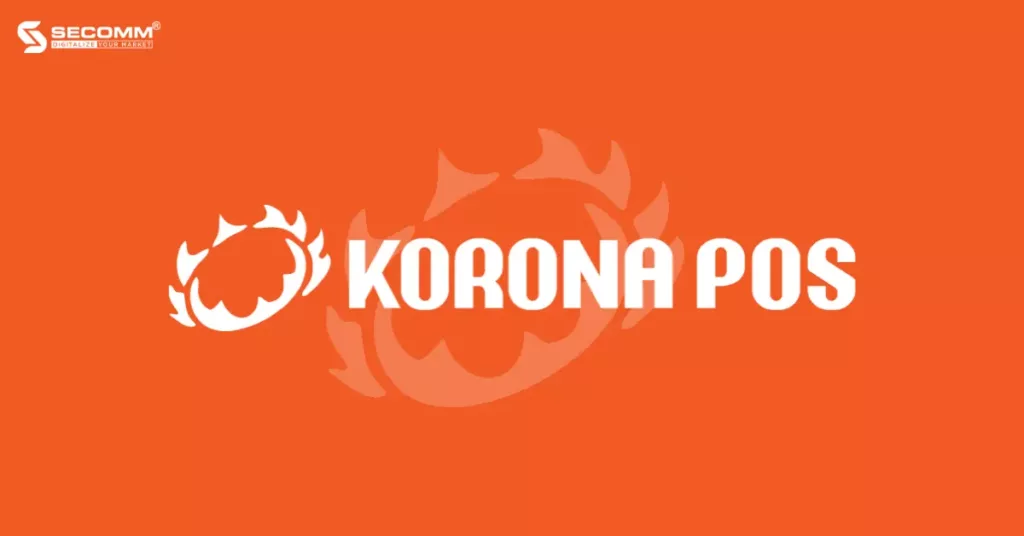
Pros
User-Friendly Interface: KORONA POS boasts a straightforward and user-friendly interface, ensuring ease of use even for employees lacking prior experience with POS systems.
Regular Updates and Upgrades: KORONA POS offers frequent updates and improvements to enhance its features and resolve issues, all while ensuring uninterrupted daily business operations.
Cross-Platform Compatibility: KORONA POS is compatible with multiple platforms, including desktops, laptops, tablets, and smartphones. This flexibility enables sales staff to process transactions and manage sales from virtually any location.
Cons
Internet Required: KORONA POS relies on a continuous internet connection to operate. Disruptions in the network connection can lead to interruptions or even render transactions and management tasks impossible.
Vendor Risk: When businesses adopt KORONA POS, they become reliant on the vendor for system maintenance and upgrades. Any issues or service deviations from the vendor can have an impact on the business’s operations.
POS System Migration Challenges: If a business has been using a different POS system and intends to switch to KORONA POS, the transition process can be intricate and may require a significant investment of time, effort, and resources to migrate all data effectively.
KiotViet
KiotViet is a business management and retail point-of-sale system catering to retail stores and restaurants. KiotViet provides an array of sales management features and tools, encompassing payment processing, inventory control, customer management, order handling, delivery, reporting, and business analysis.
KiotViet offers three options for implementing their POS system:
- Support: 200,000 VND per store per month – Ideal for small businesses, startups, or online retailers.
- Professional: 270,000 VND per store per month – Tailored for professional business models.
- Premium: 370,000 VND per store per month – Suited for businesses with multiple sales channels or a larger staff.
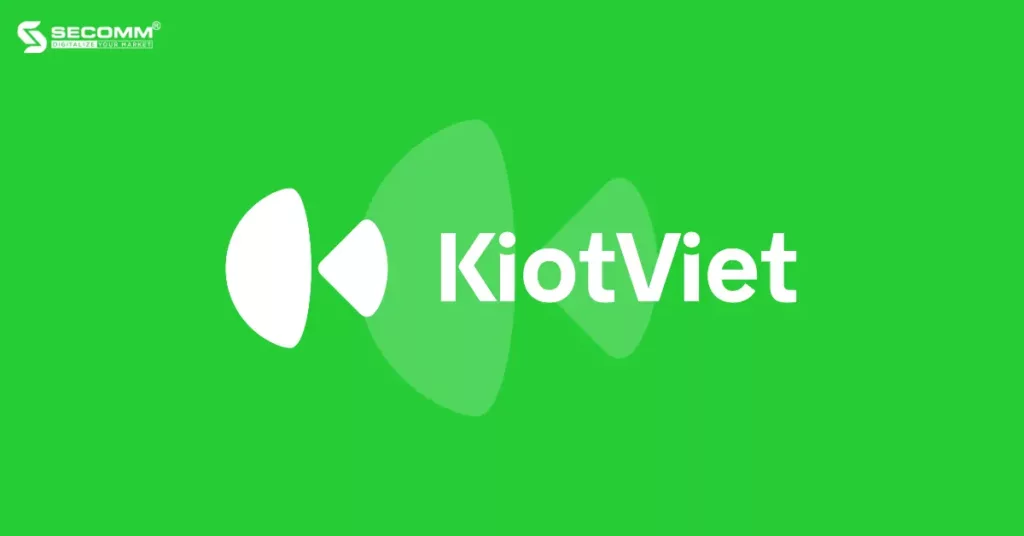
Pros
Ease of Use: KiotViet has a user-friendly interface with tailored support for Vietnamese users, eliminating the need for extensive technical expertise during setup and operation.
Seamless Integration: KiotViet offers flexible integration with various peripherals like printers, barcode scanners, payment devices, and other applications such as inventory management, HR management, and financial systems. This results in a comprehensive POS system for effective business management.
Efficient Inventory Management: KiotViet facilitates efficient inventory management, simplifying the process of updating product information and merchandise categories. Therefore, businesses can maintain control over inventory levels, monitor stock movements, and ensure on-time product availability.
Cons
License fee: KiotViet necessitates monthly or yearly license fee, which may pose challenges for small or recently formed businesses operating with limited funds.
Limited customization: While KiotViet provides some customization options, the capacity for complex customization to cater to individual business requirements may be limited.
Limitations in Niches Industries: KiotViet primarily targets retail and restaurant businesses, which implies that certain features or management procedures may not be well-suited or could be restricted for niche industries such as electronics, pets, agriculture, and others.
VNPAY-POS
VNPAY-POS, an ‘All-in-one’ solution developed by VNPAY, consolidates numerous features into a single device to comprehensively fulfill a business’s sales and payment management requirements.
VNPAY currently extends two primary options to businesses and organization using VNPAY-POS:
- Free service usage for businesses/organizations with payment fees exceeding 275,000 VND/month. For payments lower than this threshold, a flat fee of 275,000 VND/month/machine is applicable.
- Device rental is available at an affordable rate of just 165,000 VND/month. Businesses/organization achieving payment volumes surpassing 30,000,000 VND/month/machine qualify for free device rental.
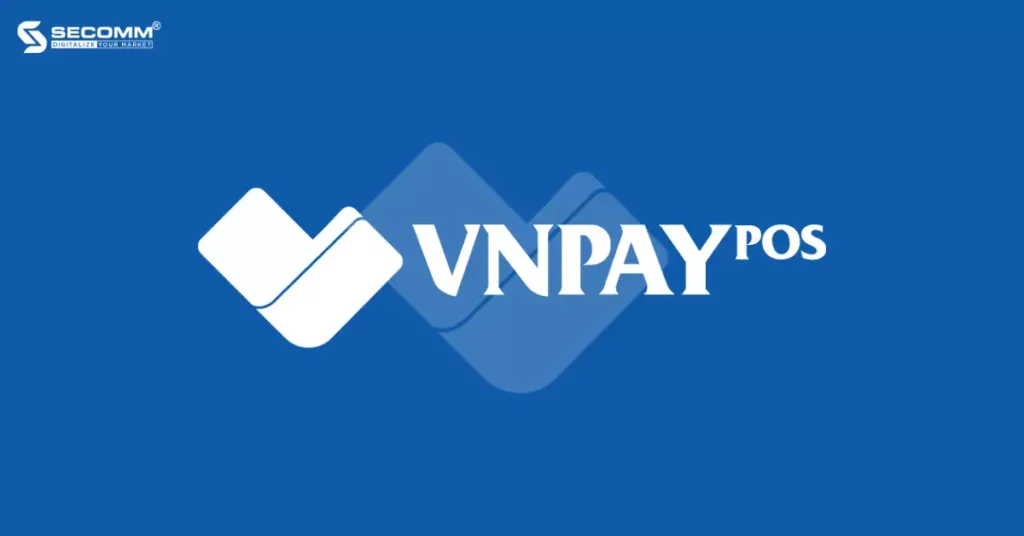
Pros
Diverse Payment Methods: VNPAY-POS allows businesses and individuals to accept payments from customers using a range of electronic payment methods, including e-wallets, bank cards, QR codes, and bank transfers.
Appealing Incentives and Comprehensive Support: In addition to its core features, the solution offers advanced functionalities like support for 0% installment plans, cross-selling services, quick and professional 24/7 registration assistance.
Optimized Sales and Business Management: A VNPAY SmartPOS device goes beyond payment processing, performing various tasks such as digital menu display, item selection, order placement, invoice printing, sales management, data extraction, and more. This streamlines operational costs for businesses.
Cons
Ongoing Costs: VNPAY POS may entail increasing monthly ongoing costs or transaction charges for payment processing, potentially straining businesses with limited financial resources.
Feature Limitations: In comparison to certain other POS systems, VNPAY-POS has limitations in its feature set, particularly in tailoring solutions to meet the specific needs of individual businesses.
Hardware Compatibility: VNPAY-POS mandates specific hardware prerequisites for operation, such as tablets or mobile devices supported by VNPAY. This could necessitate an initial investment for adopting VNPAY-POS.
POS365
POS365 is a cloud-based POS system developed by 365 Technology Corporation. POS365 provides a comprehensive solution for retail businesses, restaurants, cafes, and related industries.
Currently, POS365 offers three packages for businesses:
- Basic: 1,650,000 VND for 12 months – Designed for businesses looking to experience the product.
- Popular: 3,300,000 VND for 2 years with an additional 1-year free – Tailored for SMEs.
- Lifetime: 6,600,000 VND for a lifetime – Intended for businesses already familiar with POS365.
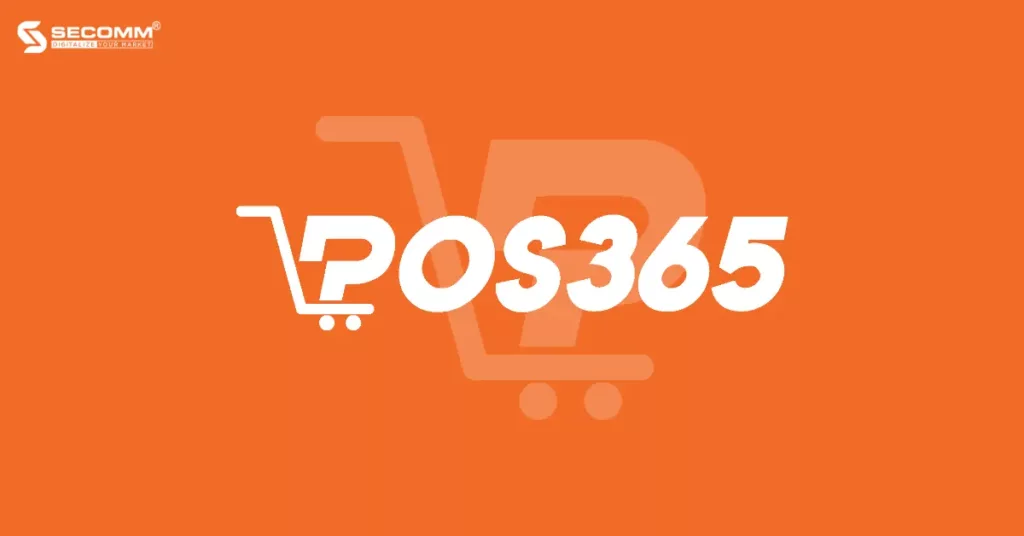
Pros
Vietnamese business-friendly: POS365 has a modern interface that’s easy to navigate, with features thoughtfully tailored to Vietnamese business practices.
Diverse Features: POS365 offers a comprehensive set of sales and business management tools, encompassing inventory control, order processing, warehouse management, customer relations, staff oversight, and business reporting.
Multi-Branch Management: POS365 facilitates the management of multiple branches and sales points through a unified system, simplifying business expansion and operation oversight.
Cons
Limited customization: POS365 comes with certain limitations regarding customization and specific business requirements adjustments. This can pose challenges for businesses with unique needs or customization preferences.
Internet required: POS365 relies on a stable internet connection to function. If there’s an internet disruption, payment processing and business management may experience interruptions.
Limited security: Because POS365 is an online system, there’s a higher risk of cyberattacks or data breaches. Businesses need to implement appropriate security measures to safeguard customer information and business data.
Related content: Top 5 best POS software for large-scale enterprises in 2023
Above is a brief overview of 5 POS software solutions widely used by SMEs to enhance business efficiency. Businesses need to consider various factors to select the most suitable POS system.
 2
2

 9,769
9,769

 0
0

 1
1
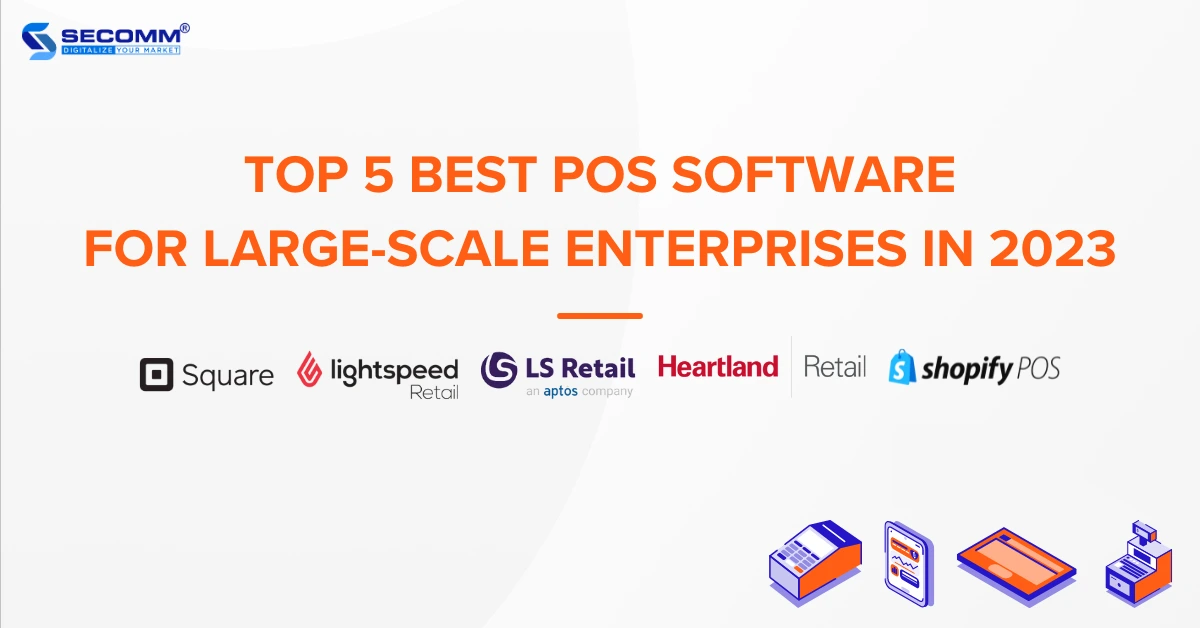
TOP 5 BEST POS SOFTWARE FOR LARGE-SCALE ENTERPRISES
Table of Contents
Much like searching for the right eCommerce platform that fits a business model, the quest for a suitable POS system can be equally challenging, especially for large enterprises.
In this article, SECOMM will delve into the top five widely favored POS software solutions by large corporations today, including Square, Lightspeed Retail, LS Retail, Heartland Retail, and Shopify POS.
Square Point of Sale
Square POS, developed by Square, is a highly favored POS system among many international large-scale enterprises due to its cost-free setup. However, Square applies fees for each transaction executed on the POS, amounting to 2.6% and 10 cents for every tap, dip, or swipe. For the ‘Buy Now, Pay Later’ payment scheme, the fees are 6% and 30 cents. Furthermore, Square provides a tailored POS package for businesses generating revenue exceeding $250,000.
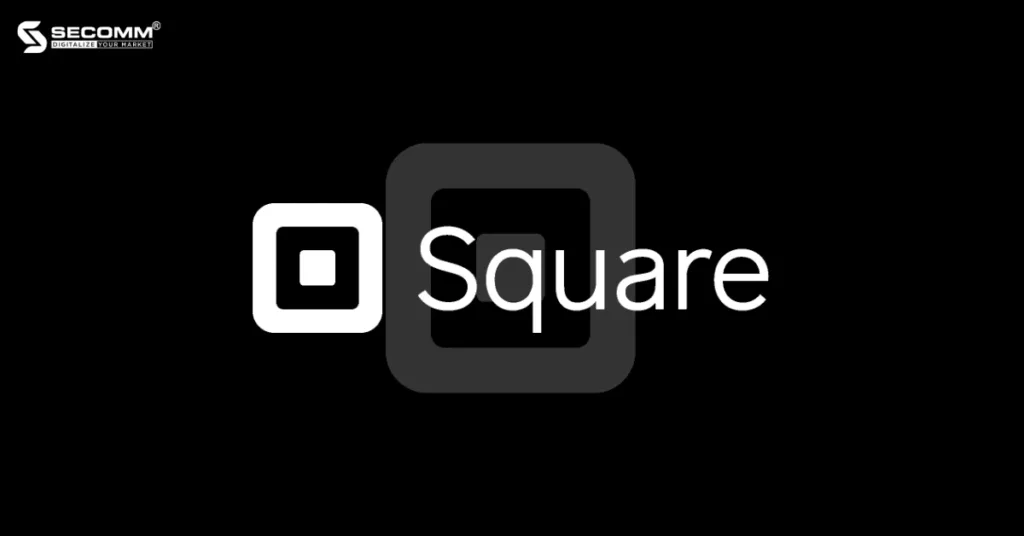
Types of POS system: Tablet-based POS system, Mobile POS system, Cloud-based POS system.
Pros
It’s free: Square software is completely free to use, without any charges for setup or monthly licenses.
It’s User-Friendly: Square offers a straightforward and intuitive user interface, making it easy for users to quickly adapt to and utilize the system effectively.
It’s flexible: Square empowers businesses to execute sales transactions from virtually anywhere using mobile devices like smartphones or tablets. This flexibility enables businesses to reach and serve customers at any time and place.
Cons
Costs Increase with Each Transaction: Square applies transaction fees (2.6% + 10 cents) to every payment processed. While its fee structure is relatively competitive, businesses with substantial sales volumes may find these fees impacting their overall profitability.
Limited Hardware Compatibility: Typically, POS systems are designed to work seamlessly with hardware provided by Square. This means that businesses might encounter challenges when attempting to utilize hardware from alternative suppliers or integrate with existing brand-specific POS systems.
Feature Constraints: Square does have some feature limitations compared to other POS systems. For instance, functionalities like multi-store management, membership card integration, or compatibility with various other business management software may be limited.
Lightspeed Retail
Lightspeed Retail is a tailored POS solution crafted for businesses operating across diverse industries. It earns praise for its wide-ranging features, high level of customization, and its seamless integration capabilities with various applications and services.
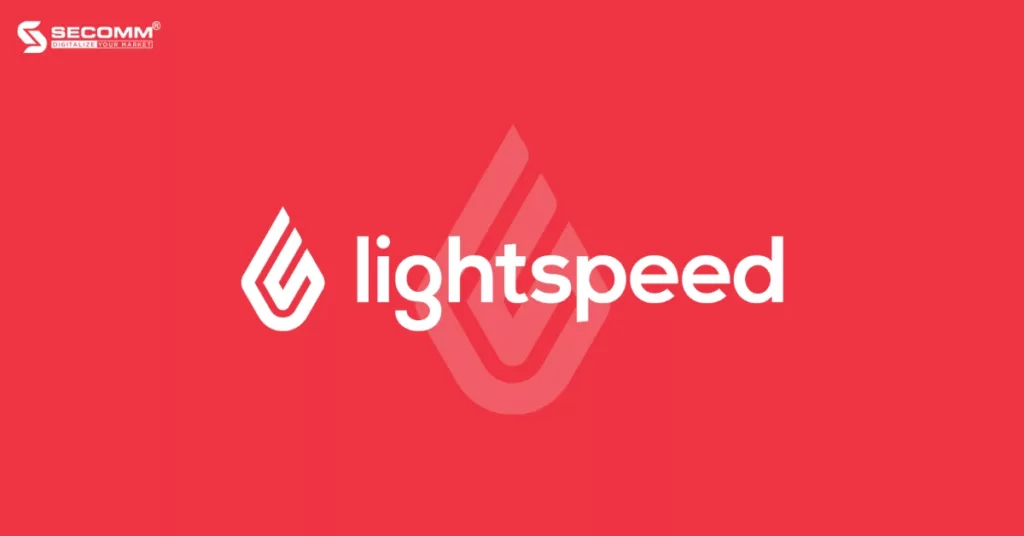
Types of POS system: Tablet-based POS system, Mobile POS system, and Cloud-based POS system.
Pros
Multi-Industry: Lightspeed Retail is specifically crafted to cater to a wide array of industries, including retail, restaurants, coffee shops, spas, salons, and more. This versatility positions Lightspeed as a multifunctional solution across various sectors.
Integration and Scalability: Lightspeed seamlessly integrates with numerous other applications and services, encompassing inventory management systems, online ordering platforms, integration with online sales channels, and much more. This flexibility enables businesses to scale and tailor the system to meet their unique requirements.
Customer Support: Lightspeed earns accolades for its top-notch customer support, offering assistance through phone, email, and online channels. The friendly and professionally trained support team is adept at resolving a multitude of issues.
Cons
High Costs: Lightspeed is associated with a higher price point in comparison to several other available POS solutions in the market.
Complex Initial Setup: The initial setup and configuration of Lightspeed can prove intricate for users lacking prior tech experience. Accurate installation, coupled with appropriate configuration, is essential to guarantee stable operation.
Internet Required: As an online POS system, Lightspeed relies on a consistent internet connection for optimal performance. Any disruptions or instability in the internet connection can lead to transaction processing issues and hinder system access.
LS Retail
LS Retail stands as a top-tier provider of POS and ERP software grounded in the Microsoft Dynamics platform. It is meticulously tailored to oversee the entirety of business operations across diverse sectors, including retail, restaurants, hotels, pharmacies, and gas stations.
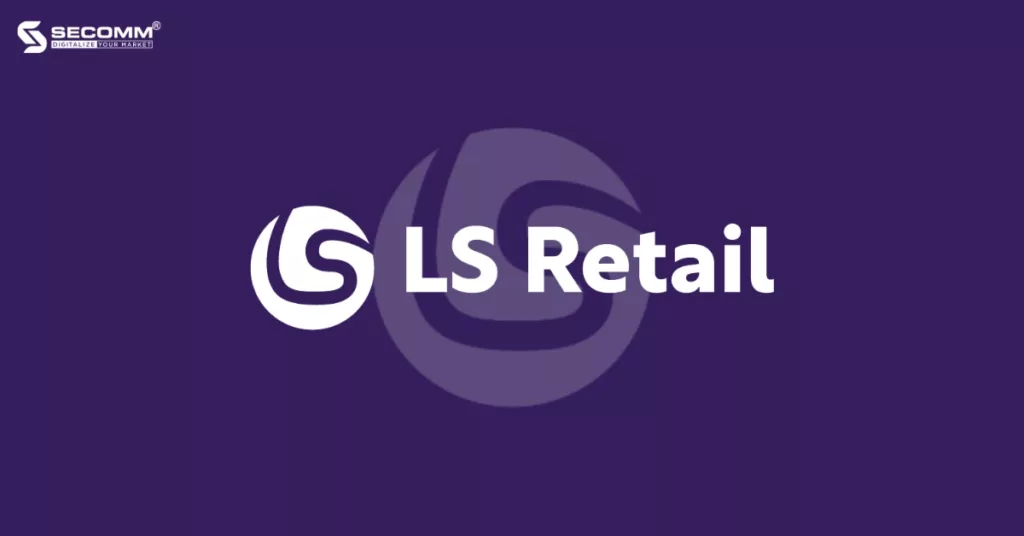
LS Retail extends three solution packages for businesses to select from:
- LS Express: Priced at $99 per month, this solution caters to small-scale businesses.
- LS Central: Offering a comprehensive POS and ERP solution for businesses (Development costs vary based on project complexity).
- LS First: Strategically designed for large corporations, with a particular emphasis on the restaurant industry (Development costs vary based on project complexity).
Types of POS system: Tablet-based POS system, Mobile POS system, and Cloud-based POS system.
Pros
Holistic Management: LS Retail offers an integrated POS and ERP solution, facilitating the synchronization of business data and more efficient management across both systems.
Multi-Channel Sales: LS Retail supports a diverse array of sales channels, encompassing traditional brick-and-mortar stores, eCommerce websites, and mobile point-of-sale (mPOS) kiosks. This broadens business horizons, reaching a larger pool of potential customers.
Efficient Inventory Management: LS Retail delivers real-time inventory management algorithms, empowering businesses to govern stock levels, item locations, and optimize procurement processes. This results in reduced shortages and excess inventory, ultimately enhancing operational efficiency.
Cons
High Costs: As LS Retail is a comprehensive POS and ERP solution, both ownership and maintenance costs may be considerably high for businesses.
Technical Expertise Required: Implementing LS Retail mandates that your business’s workforce possesses specialized technical skills and undergoes dedicated training
Dependency on Microsoft Dynamics: LS Retail is built on the Microsoft Dynamics platform, meaning the implementation and enhancement of the LS Retail system hinge on the evolution of Microsoft Dynamics, influencing bug fixes and the incorporation of the latest updates to some degree.
Heartland Retail
Heartland Retail is a cloud-based point-of-sale (POS) platform tailor-made for retail businesses.
As of now, Heartland levies a fee of $89 per month per point of sale for their POS software. Furthermore, this platform provides payroll services starting at $89 per month for 1-5 employees and payment processing services with a cost of 2.6% per successful transaction, alongside 10 cents for each tap, dip, or swipe.
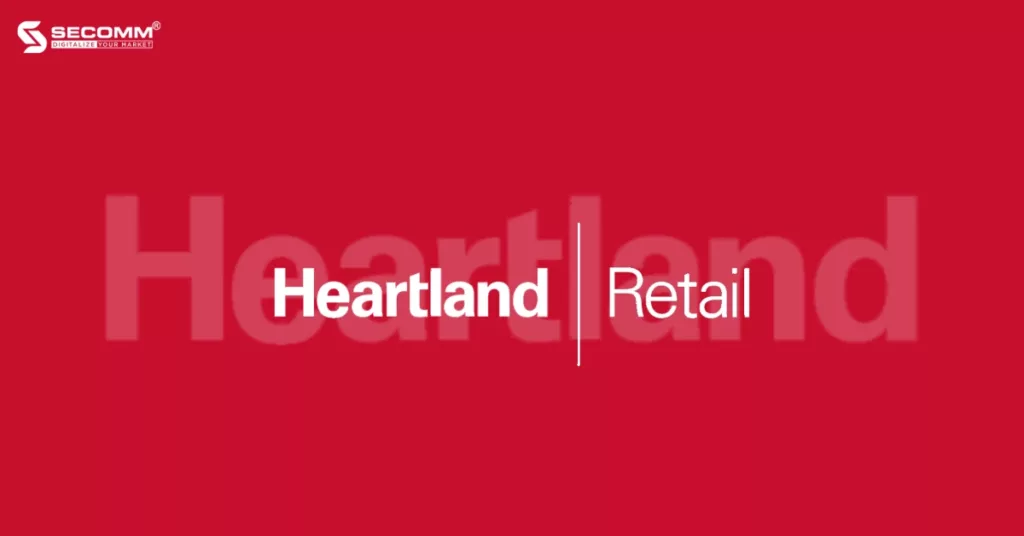
Type of POS system: Cloud-based POS system
Pros
User-Friendly Interface: Heartland Retail boasts a user-friendly and intuitive interface. Sales staff can easily navigate between functions, process payments, and engage with customers effortlessly.
Smart Reporting and Analysis: Heartland Retail offers sophisticated analytical tools and reporting capabilities, empowering businesses to gain a deeper insight into their performance and consumer trends.
Integration with Auxiliary Systems: Heartland Retail is equipped to seamlessly integrate with various auxiliary systems, including accounting, human resources management, and customer relationship management (CRM) systems. This integration facilitates the creation of a comprehensive information system, enhancing the efficiency of different departments within the organization.
Cons
Inefficient Customer Support: Numerous customer feedback reports cite limitations in customer support, with varying response times from Heartland Retail’s support team and inconsistent answers or solutions. This can pose difficulties for businesses requiring swift assistance or specific solutions.
Multi-Store Management Constraints: Heartland Retail lacks robust and flexible multi-store management features for companies operating beyond the U.S., as the company’s primary headquarters is exclusively located in the U.S.
Limited New Features and Updates: Heartland Retail doesn’t frequently introduce new features and updates, unlike some other POS systems. This limitation may hinder the adoption of the latest technologies and trends in the industry.
Shopify POS
Shopify POS is a POS solution designed by Shopify, catering to businesses utilizing their platform and seeking sales management software to effectively manage their business affairs. The usage cost for Shopify POS amounts to $89 per month per location, with a reduced rate of $79 per month per location for businesses opting for an annual subscription.
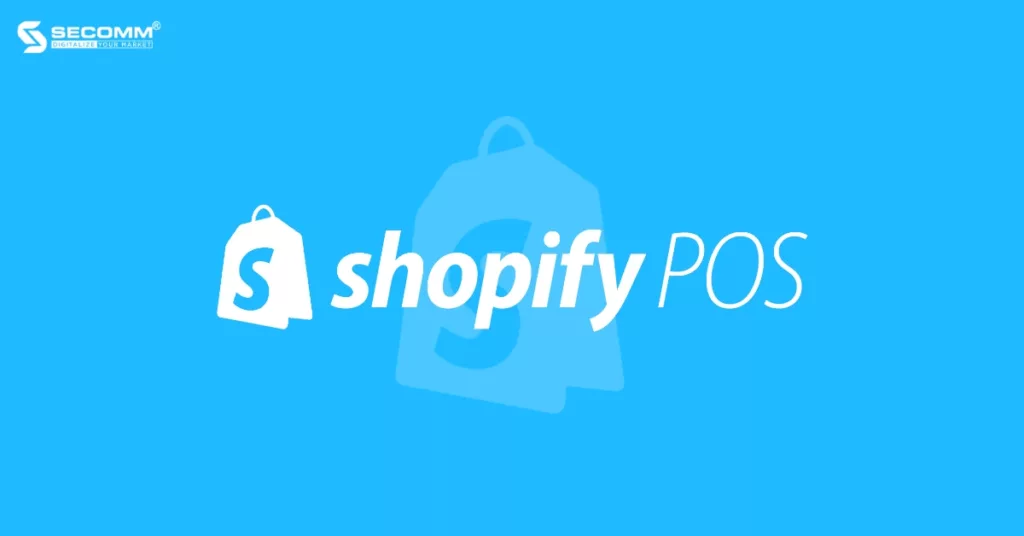
Pros
Ease of Use: Shopify POS boasts a straightforward and friendly admin interface, designed for quick staff adaptation, reducing training time, and minimizing data entry errors.
Seamless Integration with the Shopify Platform: It smoothly integrates with eCommerce websites built on the Shopify platform, enabling businesses to efficiently manage both physical and online stores from one centralized platform, resulting in time and resource savings.
Customization: Shopify POS enables businesses to customize the interface, product labels, invoices, and create brand introduction pages for brick-and-mortar stores, among other features.
Types of POS system: Tablet-based POS system, Mobile POS system, Cloud-based POS system
Cons
Exclusive to the Shopify System: Since this software is built by Shopify, it can only be integrated with this platform.
Complexity with Multiple Stores: While Shopify POS offers multi-store management capabilities, handling and configuring various stores can become intricate as the number of stores grows. Businesses must invest sufficient time in meticulous management, maintenance, and information updates for each individual store.
High Transaction Fees: When using Shopify POS, businesses are required to pay transaction fees (ranging from 2.4% to 2.6%) for each transaction. These fees can add up, especially for businesses with a large volume of transactions.
Above is a brief comparison of five POS software systems widely used by many large businesses to enhance the efficiency of their operations. Businesses need to consider various factors to select the most suitable POS system.
 2
2

 15,251
15,251

 1
1

 2
2
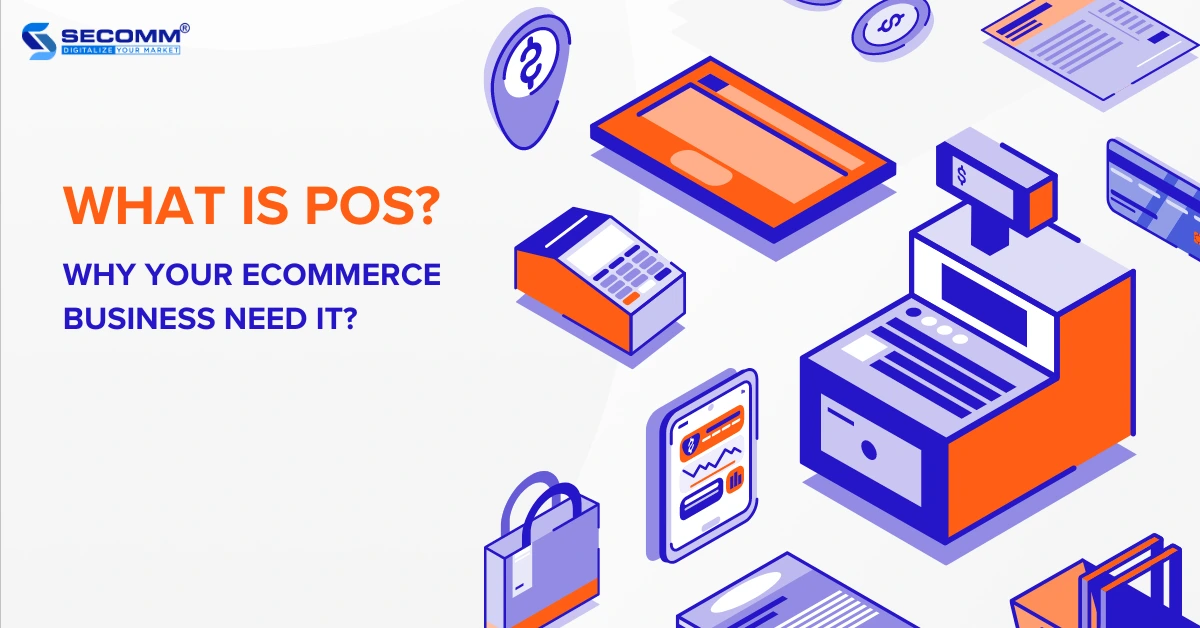
WHAT IS POS? WHY YOUR ECOMMERCE BUSINESS NEED IT?
Table of Contents
The Point of Sale (POS) software system stands as a crucial management system for all types of enterprises, be it online, offline, or O2O (online to offline) businesses.
What is POS?
POS or Point of Sales is sales management software that empowers businesses to efficiently monitor all their business activities, anytime and anywhere. In essence, POS is a complete system comprising both hardware and software components, or it can be as straightforward as a point-of-sale device, such as a computer, tablet, smartphone, receipt printer, and so on.
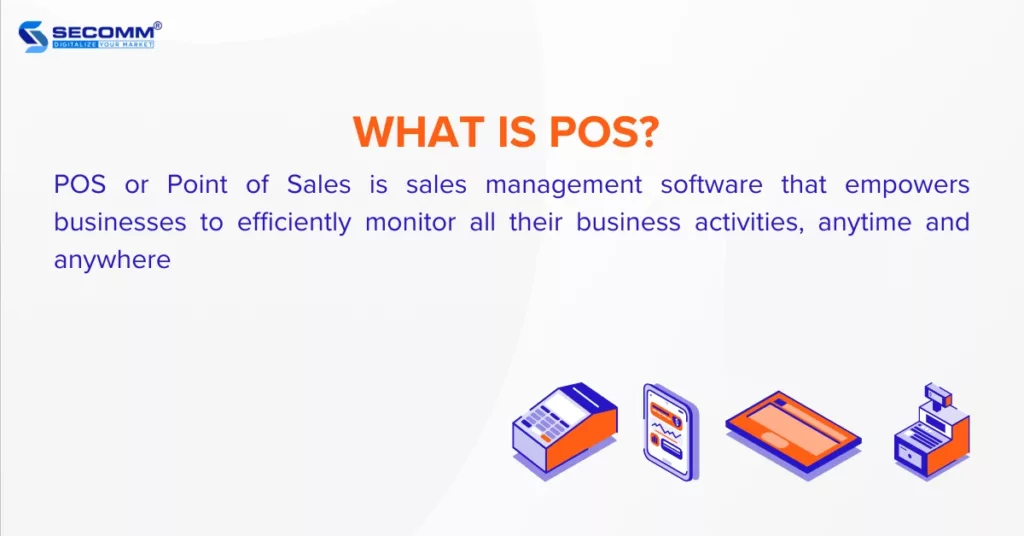
With its robust management capabilities, POS helps businesses oversee and process sales transactions, calculate payments, generate invoices, manage inventory, handle customer relationships, and deliver crucial insights regarding sales performance.
Types of POS system
There are four main types of POS systems that businesses commonly use today, including Legacy POS system, Tablet-based POS system, Mobile POS system and Cloud-based POS system.
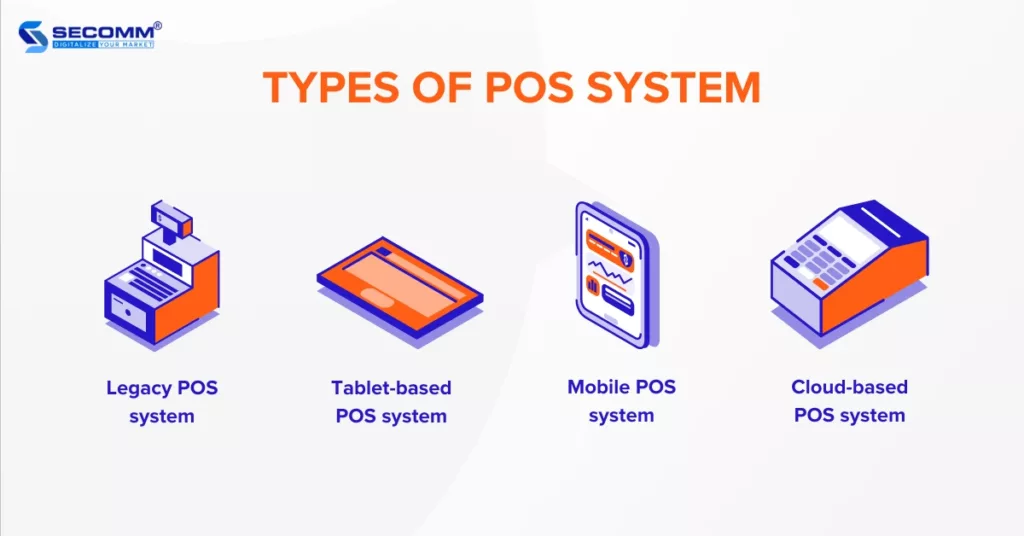
Legacy POS system
The Legacy POS system, also known as on-premise POS, is a type of point-of-sale system that relies on conventional hardware and software to handle sales transactions and manage local data. This means that all transactions and information are stored on a single device, with businesses only able to access the data from that specific device.
As a result, traditional POS systems often require installation and configuration at each individual point of sale, and they typically lack remote accessibility. This can slow down the integration process with eCommerce systems.
For example, some legacy POS systems include Aloha, Oracle MICROS, Squirrel Systems, and more.
Tablet-based POS system
A Tablet-based POS system is a type of POS system that employs tablets as the main devices for processing sales transactions, rather than relying on conventional computers or standalone POS equipment.
Due to its reliance on hardware that is familiar to many, integrating this POS system with eCommerce platforms and training staff tends to be more straightforward compared to legacyPOS systems.
Examples of well-known Tablet-based POS systems include Lightspeed POS, Square, Shopify POS, and others.
Mobile POS system
A Mobile POS system is a type of POS that employs mobile devices like smartphones, tablets, or wearable devices for handling sales transactions. This allows sales staff to move freely within the store or conduct transactions directly at the customer’s location.
This functionality enables sales associates to access product details and customer records via the Mobile POS system, facilitating inventory checks and offering personalized recommendations to customers. Just like Tablet-based POS systems, integrating and training staff to use Mobile POS systems is generally uncomplicated.
Some widely used Mobile POS systems include Lightspeed POS, Clover, Square, and others.
Cloud-based POS system
A Cloud-based POS system leverages cloud computing technology to store and process sales data. Instead of keeping data on local computers or in-house servers, this system adopts an online approach to manage and access data from any device with an internet connection.
The majority of modern POS systems are cloud-based because they offer various advantages, including remote accessibility, flexibility, easy integration, and scalability. They enable businesses to oversee multiple points of sale from a unified platform, providing real-time data and insights for informed decision-making. Furthermore, Cloud-based POS systems reduce hardware demands and installation costs when compared to other POS solutions.
Some prominent examples of top Cloud-based POS systems for businesses include Lightspeed POS, Square, Clover, and others.
Benefits of using POS software
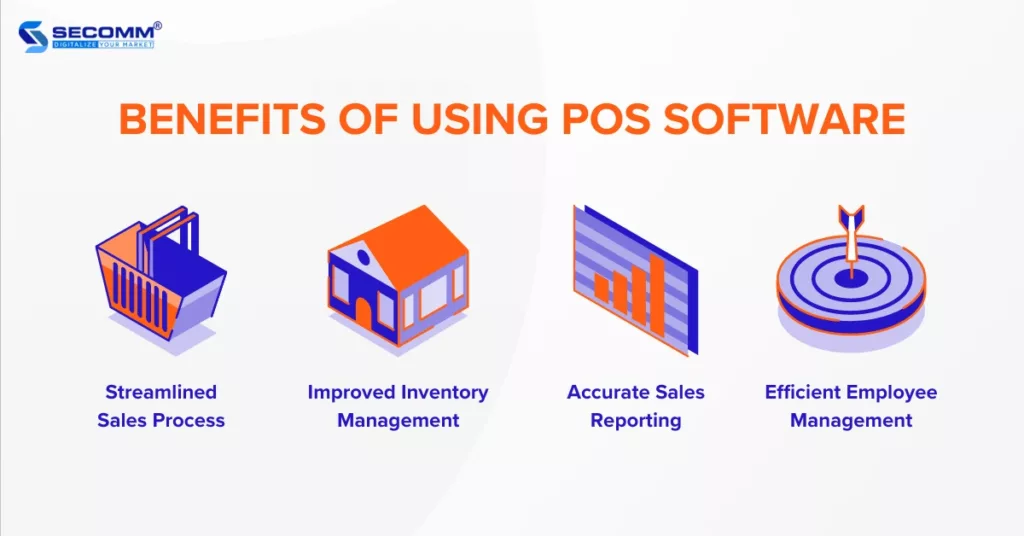
Streamlined Sales Process
The POS system streamlines and automates the sales process, ensuring faster and efficient transactions. Businesses can swiftly process payments, precisely calculate totals, and produce invoices or receipts within mere seconds.
Improved Inventory Management
The POS system empowers businesses to actively monitor and manage their inventory in real-time, receiving alerts when products are running low and automatically initiating reorder processes. This helps prevent stock shortages or excess inventory, ultimately optimizing inventory levels and reducing storage expenses.
Accurate Sales Reporting
The POS system offers the ability to analyze and report detailed revenue data, empowering businesses to monitor their performance, understand consumer trends, identify favored products, and so forth. Consequently, this data forms the basis for businesses to strategize for the future.
Efficient Employee Management
The POS system simplifies the process of monitoring each employee’s sales volume, work hours, and performance indicators. Consequently, businesses can obtain precise data for calculating individual commissions, streamline payroll processing, and identify high-performing team members or those requiring further training.
Overall, POS stands as a vital management software within any eCommerce business framework. Businesses should conduct thorough research on different POS system types to choose the most fitting and effective management software in line with their business model and strategy.
Contact SECOMM or dial our Hotline at (02871089908) for consultation and the implementation of your POS system
 2
2

 9,318
9,318

 0
0

 1
1
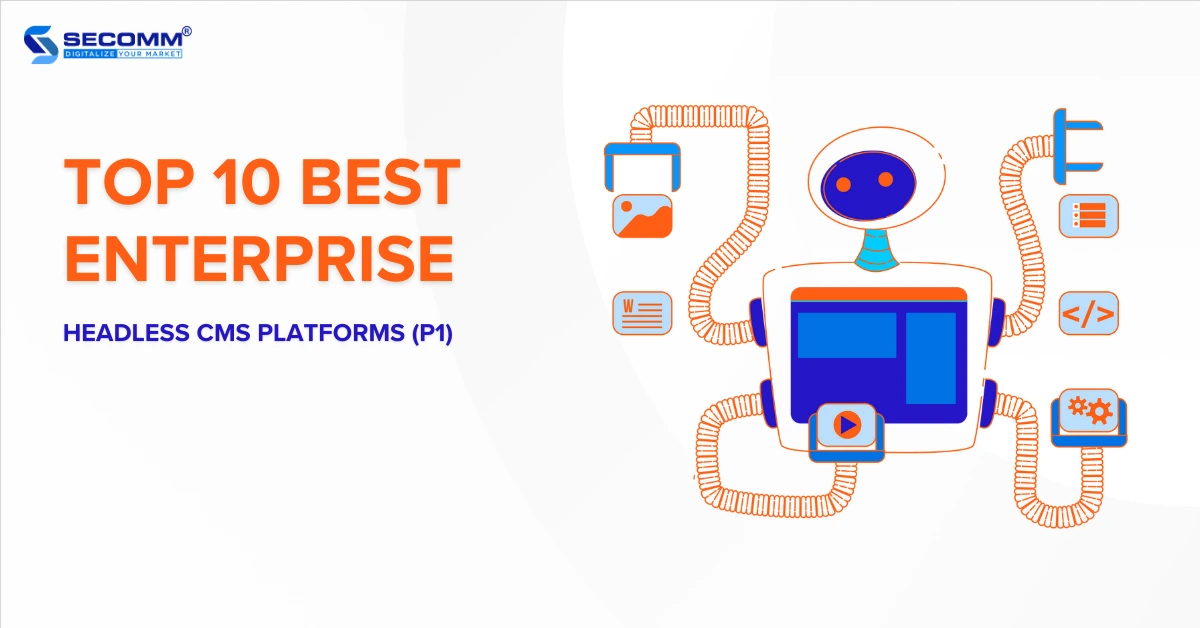
TOP 10 BEST ENTERPRISE HEADLESS CMS PLATFORMS (Pt1)
Table of Contents
The 2022 Headless CMS market was valued at approximately $592.43 million and is projected to reach $672.09 million by the end of 2023. These figures come as no surprise as Headless CMS has become increasingly popular in recent years due to the numerous benefits it offers to businesses. These benefits include cost-effectiveness, the ability to distribute and repurpose content across various channels, high customization and flexibility to work with any technology or framework, a future-proof architecture that can seamlessly integrate with third-party services, and adaptability to emerging technologies.
These advantages have encouraged businesses to adopt Headless CMS to enhance their online presence. However, the first crucial step is selecting the most suitable platform from the many excellent options available.
This article will provide an overview of the top 10 leading Headless CMS platforms, highlighting their distinctive features, as well as their pros and cons, to assist businesses in making an informed choice
Sanity
Sanity stands out as a cloud-based Headless CMS platform that provides businesses with a suite of tools for content creation, editing, organization, and publication. Renowned for its remarkable flexibility and impressive scalability, this platform accommodates projects of varying complexity, from straightforward to intricate. Sanity offers robust support for developers working with an array of frameworks including React, Vue, Next.js, Nust.js, Remix, Svelte, Eleventy, Gatsby, and more.
Moreover, it extends its compatibility to multiple programming languages like JavaScript, PHP, Rust, and others, enabling businesses to seamlessly integrate with diverse platforms such as Shopify, BigCommerce, Algolia, Commerce Layer, Mux, Cloudinary, Transifex, and more.
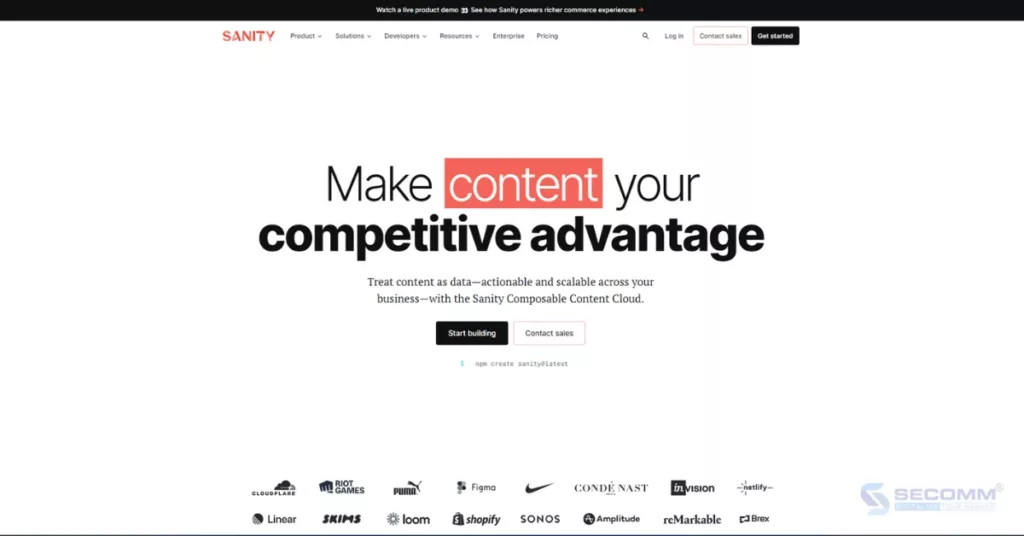
Key features
- Real-time Collaboration: Allows multiple users to collaboratively edit content in real-time.
- Flexible Editing Environment: Supports editing across various devices and enables scheduled content releases or app updates.
- Portable Text Format: Easily creates and manages complex content with embedded data using Portable Text.
- Integration Capabilities: Connects services, user interfaces, applications, scripts, and devices through the Sanity API. Queries content using GROQ or GraphQL.
- Sanity Content Lake: Cloud-hosted content storage managed entirely by Sanity. Accessible via the Sanity API, Sanity’s client libraries, or directly through the HTTP API.
Pros
- Flexibility: Sanity allows businesses to structure content according to specific needs.
- Customizable Content Management Interface: The content management interface can be tailored to align with brand characteristics, ensuring a consistent user experience across channels.
- User Collaboration Transparency: User avatars are displayed when editing content, and the entire content creation and editing process can be directly tracked, enhancing team efficiency.
- Developer-Friendly: Sanity is developer-friendly, providing numerous support tools, APIs, and frontend frameworks for easy content creation, customization, and integration.
Cons
- Besides the costs mentioned in the pricing table, the implementation cost of Sanity will increase depending on specific needs. For example, businesses will incur additional expenses to integrate the Mux plugin for managing video content.
- Many features and technical concepts require users to invest more time and effort in understanding and implementing.
Pricing
Sanity offers four solution packages for businesses to choose from:
- Free Forever: Provides 3 non-admin user accesses.
- Team: $99/month/project, suitable for small businesses, offering 10 non-admin user accesses.
- Business: $949/month/project, designed for medium-sized businesses, providing 20 non-admin user accesses.
- Enterprise: Custom pricing based on needs, intended for large-scale businesses, offering unlimited user access.
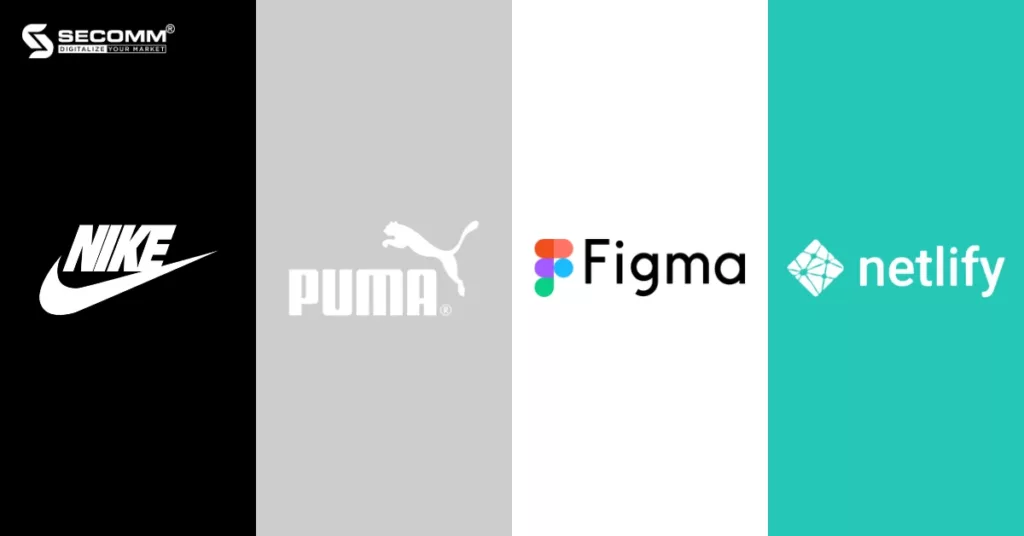
Storyblok
Storyblok is a leading API-first Headless CMS that prioritizes businesses’ ability to effortlessly generate, oversee, and disseminate content across multiple platforms. This software offers a user-friendly interface, empowering content marketers to efficiently oversee and adapt content without demanding extensive technical proficiency. Storyblok also aids developers through various APIs like GraphQL, Management API, and Content Delivery API, and is compatible with frameworks such as React, Vue.js, Angular, Nuxt.js, Next.js, and Gatsby.
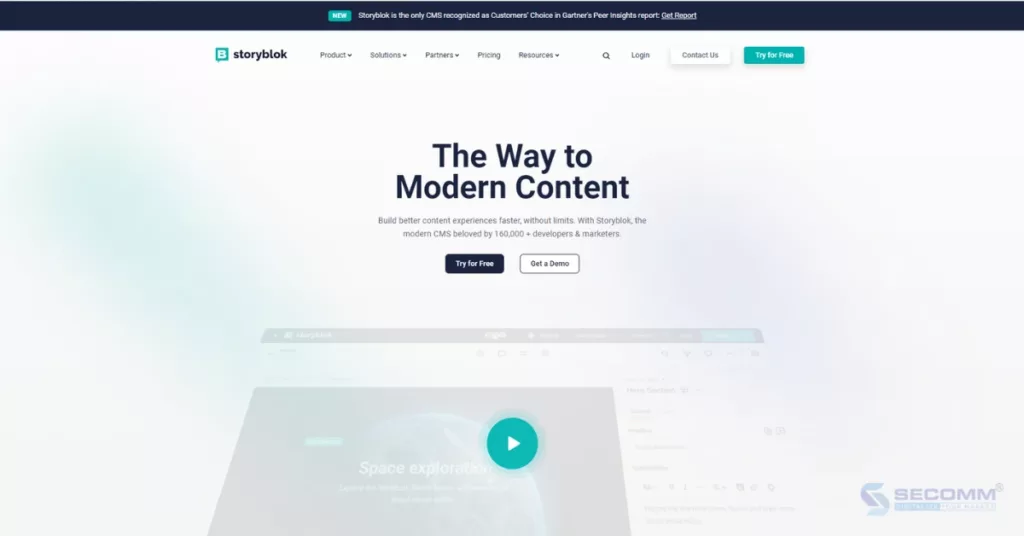
Key features
- Visualize collaboration processes and easily create and edit content through Visual Editor and Collaboration tools.
- Streamline content management for text, images, and videos with the Digital Asset Manager, equipped with advanced tagging and hierarchical folder organization.
- Leverage Storyblok’s Composable Component functionality to convert inflexible templates into versatile, dynamic components that can be seamlessly integrated and reused across diverse digital platforms.
- Achieve multilingual content distribution to international markets with Localization capabilities.
Pros
- High flexibility and customization options enable businesses to add or remove features based on practical needs.
- Storyblok provides in-depth documentation for every topic, assisting developers in understanding how to use features and deploy services effectively
Cons
- Pricing currency is in EUR instead of USD.
- The Visual Editor interface can sometimes lag.
- Monthly bandwidth usage is limited and may require purchasing additional bandwidth at a relatively high cost.
Chi phí
Storyblok offers a variety of solution packages for businesses, including:
- Community: Free forever, includes 1 registered account per user seat.
- Entry: €99/month, 5 registered users, up to 30 registered accounts per user seat. Suitable for small businesses and startups entering the content management system.
- Teams: €449/month, 10 registered users, up to 40 registered accounts per user seat. Suitable for growing businesses with content distribution needs.
- Enterprise: €2,999/month, 30 registered users, and unlimited additional registered accounts per user seat. High-level security and scalability with many outstanding features for large enterprises.
- Enterprise Plus: Custom pricing based on needs, offering the highest level of security and scalability among solution packages.
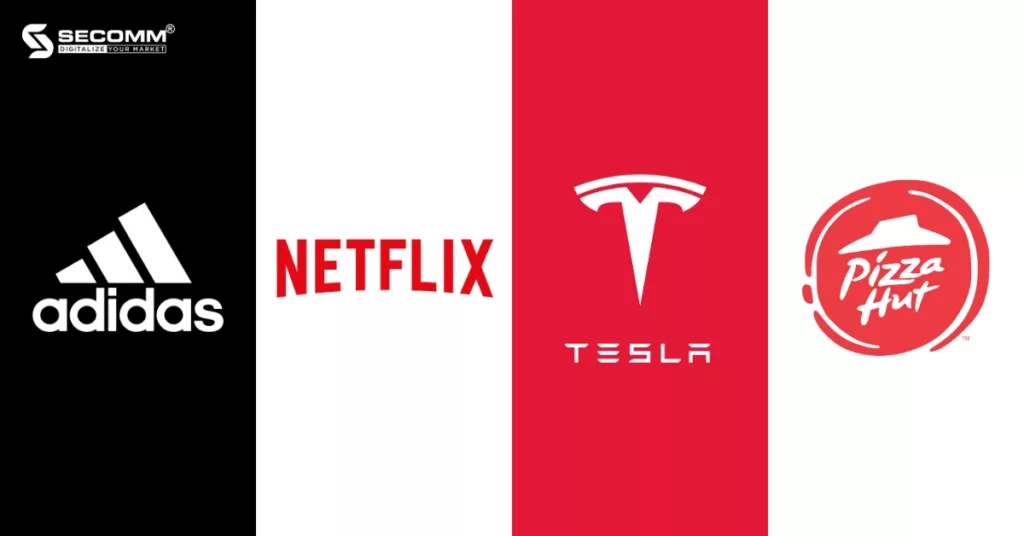
Contentful
Contentful stands out as an API-first Headless CMS, prized for its adaptability and remarkable scalability. It enables businesses to effortlessly craft, oversee, and distribute content across diverse channels and devices, encompassing websites, applications, IoT gadgets, and beyond. Contentful boasts a rich assortment of APIs, such as REST, GraphQL, Content Management API, Content Delivery API, and Content Preview API, among others.
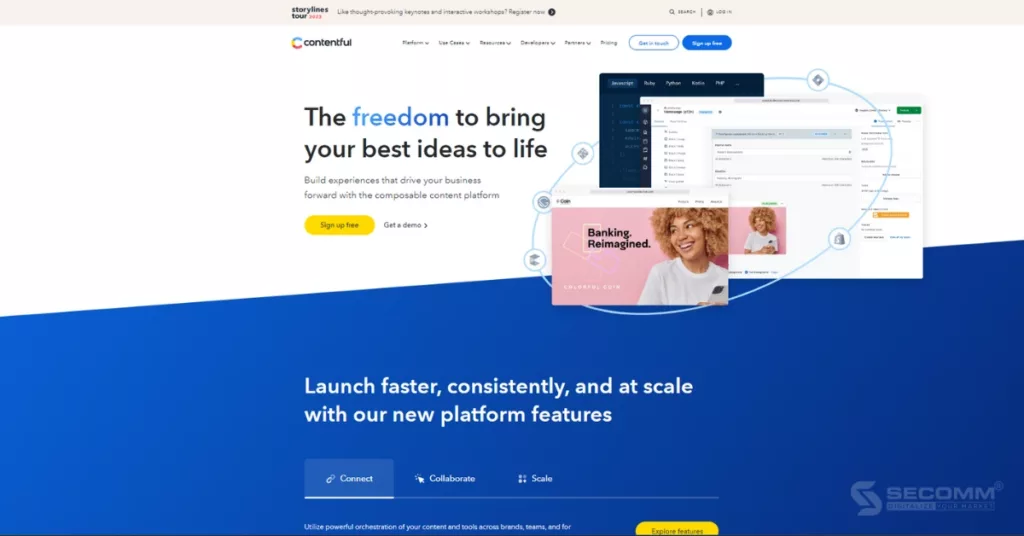
Key features:
- Quickly create projects tailored to your needs using customizable templates based on the Next.js framework and Contentful CMS, whether it’s an eCommerce website or a blog site.
- Leverage Content Apps or integrate with third-party applications to streamline content production and publishing workflows for optimal efficiency.
- Contentful supports content localization for global marketing strategies, enabling you to adapt and target content for international audiences.
- Swiftly review, approve, and schedule the batch publishing of crucial content, such as product launches, advertisements, and rebranding initiatives, all at once.
Pros:
- Contentful offers a friendly and easy-to-use interface.
- It provides extensive support and learning resources for developers to enhance their skills, particularly for complex projects.
- Contentful includes numerous tools for efficient teamwork, such as the Compose app, Launch app, and Workflow app.
Cons:
- Contentful has limitations in terms of previewing and editing images.
- Depending on the subscription plan, businesses are provided with a certain amount of space and components. When these limits are reached, businesses have two options: either delete items to free up space or upgrade their space. This can be inconvenient and may result in additional costs.
Pricing:
Contentful currently offers three solution packages:
- Free: Designed for individual developers working on personal projects. It includes one space license, supports up to 5 users, and does not offer the option to upgrade or purchase additional space.
- Basic: Priced at $300 per month, this package includes one space license and is suitable for teams building websites or apps. It supports a maximum of 20 users and provides the option to upgrade to the Medium plan for an additional cost of $350 per month.
- Premium: Tailored for large enterprises, the pricing for this package is customized based on specific needs and is billed annually. It includes two space licenses, allows for a large number of users (up to thousands), and offers advanced space upgrades to Medium, Large, or Premium spaces for an additional fee.
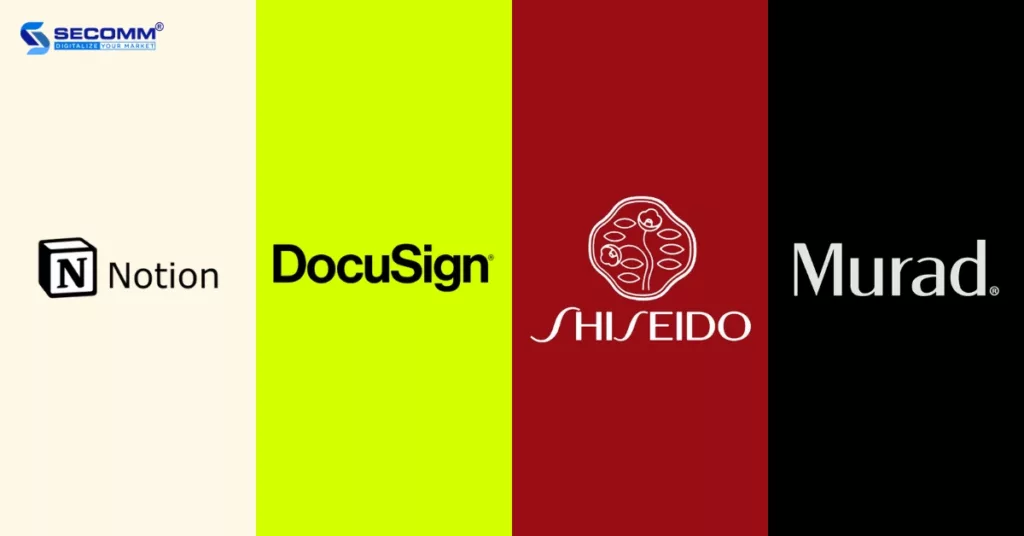
Strapi
Strapi is an open-source JavaScript-based Headless CMS celebrated for its robust customization and expansive capabilities. Strapi provides developers with a wide array of APIs, including REST, GraphQL, Entity Service, Query Engine APIs, and more. Furthermore, it seamlessly integrates with popular frameworks such as Vue.js, Angular, React, Next.js, Eleventy, Svelte, and more.
Notably, Strapi boasts a user-friendly interface, empowering content marketers to swiftly create, edit, and publish content without the need for extensive programming skills. This reduces reliance on developers. Additionally, Strapi shines with its Omnichannel capabilities, enabling content dissemination across diverse channels, including websites, apps, and IoT devices.
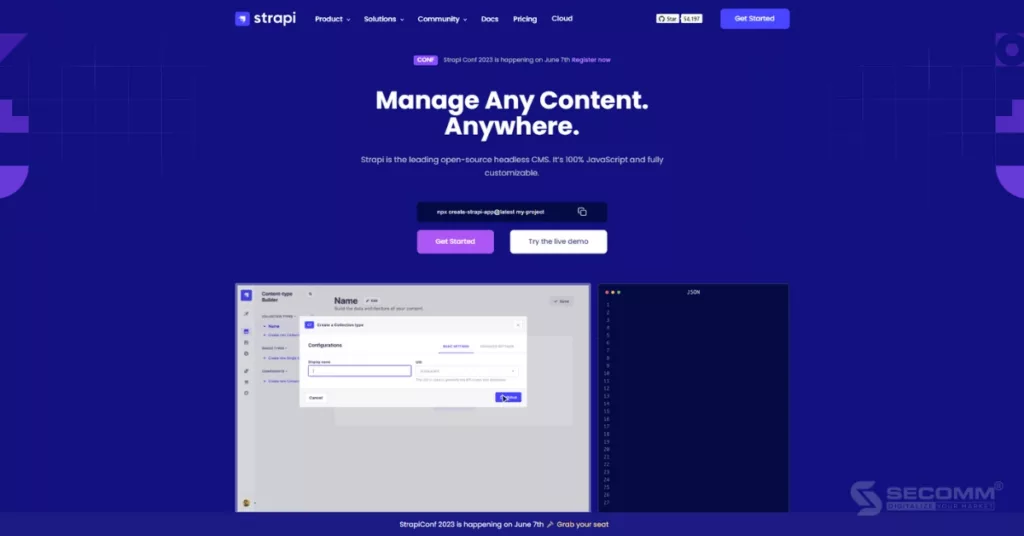
Key features
- Support for multi-database environments, including SQLite, MongoDB, MySQL, and Postgres.
- A single programming language – JavaScript, from frontend to backend.
- Seamless Omnichannel capabilities for distributing content across multiple channels.
- Unlimited support for APIs, content types, admin panel users, and more.
- Webhooks facilitate connections between Strapi apps and other applications to notify them of events, particularly useful for informing third-party applications about the start of processes like continuous integration (CI), building, and deployment.
- Internationalization with the i18n framework, allowing for unlimited multi-language, multi-location projects.
Pros
- Seamless integration with Node.js.
- Easy API customization.
- Scalability and handling high traffic with ease.
- Intuitive and user-friendly user interface (UI).
- Abundant learning resources.
Cons
- Lack of support for advanced JavaScript versions like TypeScript.
- Limitation on the number of registered accounts per user depending on the solution package.
- Several features and specialized concepts may require users to invest significant time and effort in understanding and implementing them.
Pricing
Strapi offers four solution packages for businesses to choose from:
Self-hosted (self-hosted by the business)
- Community Edition: Free forever
- Enterprise Edition: Custom pricing based on needs
Cloud (hosted by Strapi)
- Pro: $99/month/project, with a 14-day free trial
- Team: $499/month/project, with a 14-day free trial
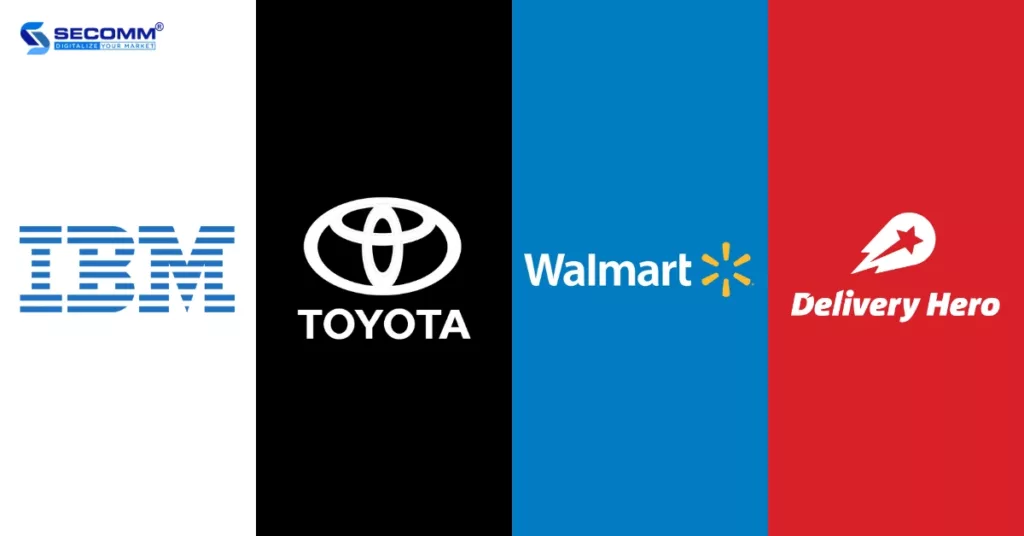
Hygraph
Hygraph is a federated content platform that enables the integration of content data from various sources and backends into a single storage repository through a GraphQL API without the need to move or create multiple copies of that content.
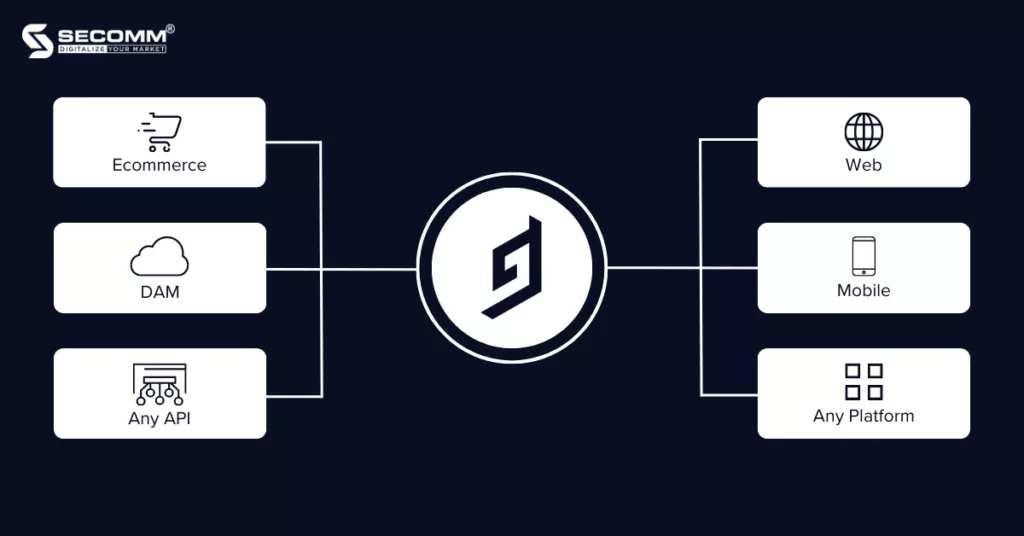
Headless CMS vs Federated Content Platform
user interface, enabling the distribution of content across various digital channels. However, in line with technological advancements, CMS providers are attempting to consolidate all content data within the CMS itself, creating what is known as a Content Hub, from which they distribute content.
Nonetheless, this approach has its drawbacks as it necessitates continuous data synchronization, which may not always ensure data accuracy when delivered to diverse channels. In such scenarios, a Federated Content Platform offers a pragmatic solution by integrating and storing content and data from any third-party system via GraphQL API or REST API, subsequently distributing the original data to multiple channels.
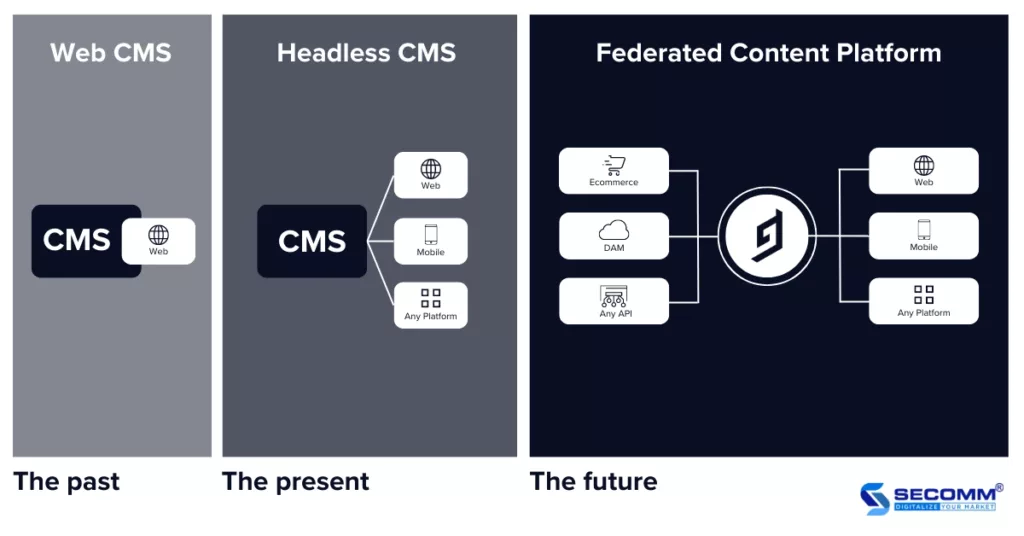
Looking at the scenario with Hygraph, it serves as a central hub for integrating and storing data from various sources. Acting as an API gateway, any changes made to the original data are first updated within Hygraph and then distributed to one or more front-end platforms. Users of Hygraph can access this updated data from multiple sources but are unable to make direct edits, preventing the proliferation of multiple data versions.
Key features
- Schema Builder: Provides developers and content marketers with user-friendly tools for creating templates to meet the diverse content needs of businesses.
- Custom Roles & Permissions: Established by the Administrator and Project Owner, it’s easy to control what users can see based on their roles within the system. There will be various system roles, but they generally include Owner, Admin, Developer, Editor, and Contributor. Owners and Admins can easily create custom roles for developers like “Create New Role” and “Update Existing Roles” using the permissions provided by the Management API. When setting up custom roles, businesses need to select all Read permissions to grant users the essential functionalities required while using the platform.
- Hygraph’s webhooks can integrate with third-party services to quickly update changes in project content in real-time.
- Scheduled Publishing allows content marketers to schedule content or campaigns for publication at a specific time in the future.
- The Rich Text Editor, sometimes called WYSIWYG (What You See Is What You Get), is available for all of Hygraph’s solutions. Businesses can add the Rich Text Editor to any content section through the Schema Builder, making it easy for content marketers to create and edit text and images flexibly.
- Localization – content localization for global marketing strategies.
Pros
- The Content Federation capability ensures that APIs can store and deliver data accurately to various different frontends.
- Customizable roles promote efficient collaboration in the workflow.
- Display content performance analytics for businesses to measure traffic and engagement.
Cons
- The API functionality is rated as somewhat slow, taking from 3 to 8 seconds.
- Many concepts and features require time and effort to grasp.
Pricing
Hygraph offers three main solution packages for businesses:
- Community: Forever free, suitable for individuals and small projects.
- Self-service: Suitable for businesses in development.
- Professional: $399 per month per project.
- Scale: $899 per month per project.
- Enterprise: Custom pricing based on specific needs, suitable for large enterprises.
Brands that use Hygraph include Samsung, Shure, Booking.com, Philips, Telenor, Ashley, Dr. Oetker, Neat, Dmarket, Flybondi.com, etc.
To learn more about Headless CMS and choose the right deployment platform, please contact SECOMM or call our hotline at (028) 7108 9908 for a free consultation.
 2
2

 7,681
7,681

 0
0

 1
1
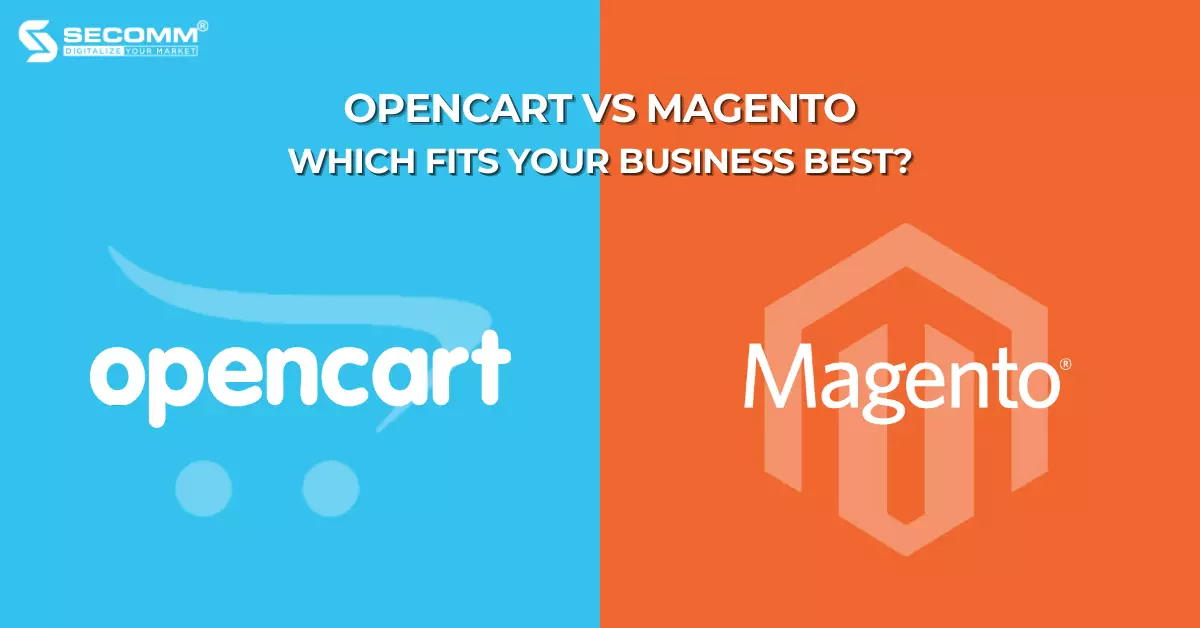
OPENCART VS MAGENTO: WHICH FITS YOUR BUSINESS BEST?
Table of Contents
OpenCart and Magento have consistently been pitted against each other as open-source platforms for businesses in need of building specialized eCommerce websites, particularly for enterprises and corporations.
So, which of these open-source eCommerce platforms, OpenCart or Magento, is the right fit for your business?
OpenCart vs Magento: Overview
What is OpenCart?
OpenCart is a freely developed open-source eCommerce platform designed in PHP. It’s favored for its user-friendliness and simplicity, boasting an easy-to-navigate admin dashboard that allows product management, promotions, order processing, and reporting without requiring technical expertise.
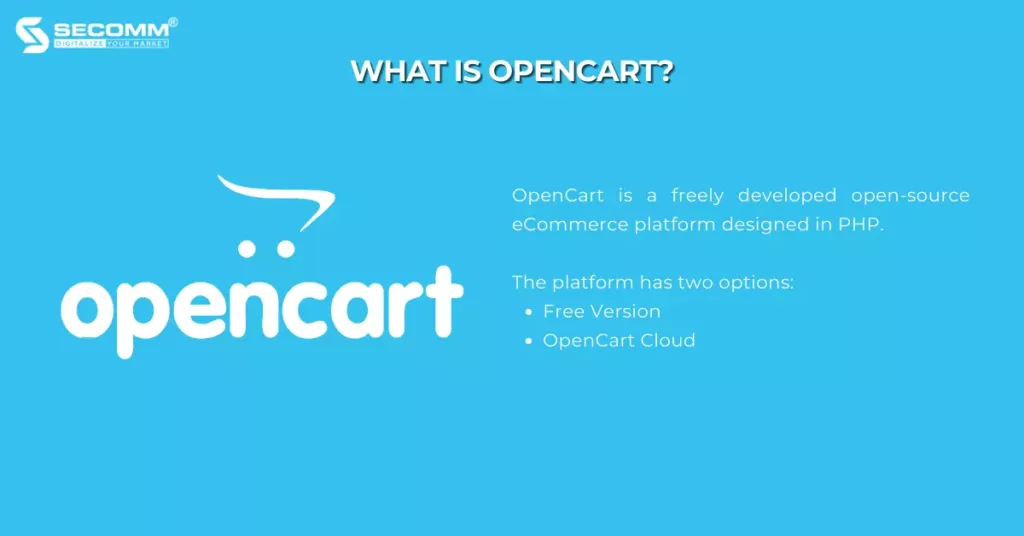
OpenCart offers two options for businesses:
- Free Version: Ideal for businesses looking to build their website using OpenCart’s pre-existing framework.
- OpenCart Cloud: Suited for businesses seeking the expertise of OpenCart’s professional team for website development.
As per Build With data, OpenCart has been adopted by over 400,000 websites, primarily by small to medium-sized businesses in the United States, Russia, the United Kingdom, Ukraine, and Brazil.
Related Reading: What is OpenCart? Key Pros and Cons of OpenCart
What is Magento?
Magento (Adobe Commerce), much like OpenCart, is an open-source eCommerce platform developed using the PHP programming language. Magento stands as the ‘pinnacle’ among all open-source eCommerce platforms due to its comprehensive control and high scalability, offering a plethora of specialized features.
At present, Magento provides three primary editions, which are:
- Open Source: This free version boasts a wealth of exceptional features, making it suitable for businesses just starting with open-source platforms.
- Adobe Commerce (on-premise): This self-hosted version is ideal for businesses seeking the readily available features of Adobe Commerce while maintaining hosting independence.
- Adobe Commerce Cloud: This cloud-hosted version caters to businesses in need of hosting services and features offered by Adobe.
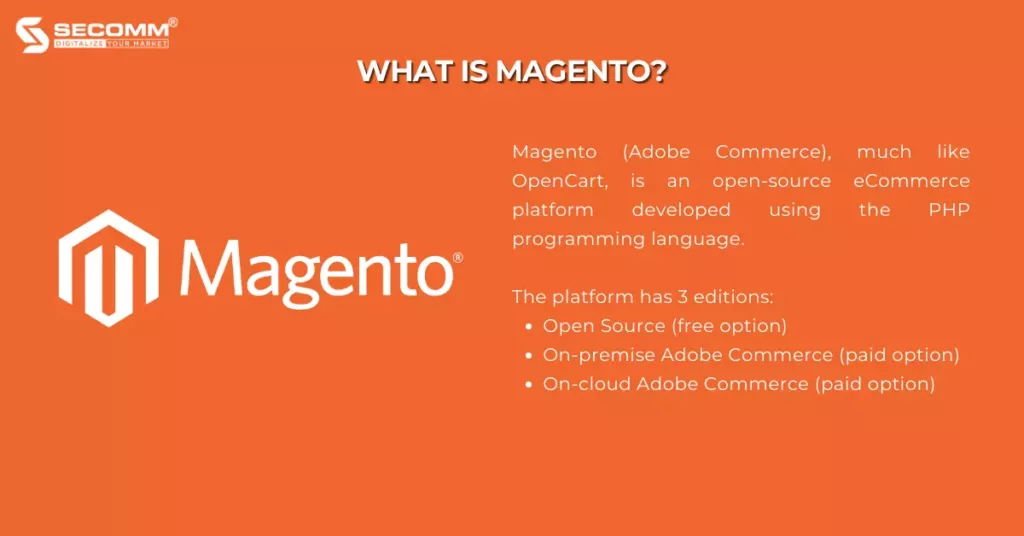
According to BuildWith, Magento supports over 160,000 websites, with significant popularity among large businesses in the United States, the United Kingdom, the Netherlands, and Germany.
Given the differences in service offerings between the paid versions of OpenCart and Magento, this SECOMM article will focus on comparing the two free versions.
Related Reading: What is Magento? Key Pros and Cons of Magento
OpenCart vs Magento: Key Similarities
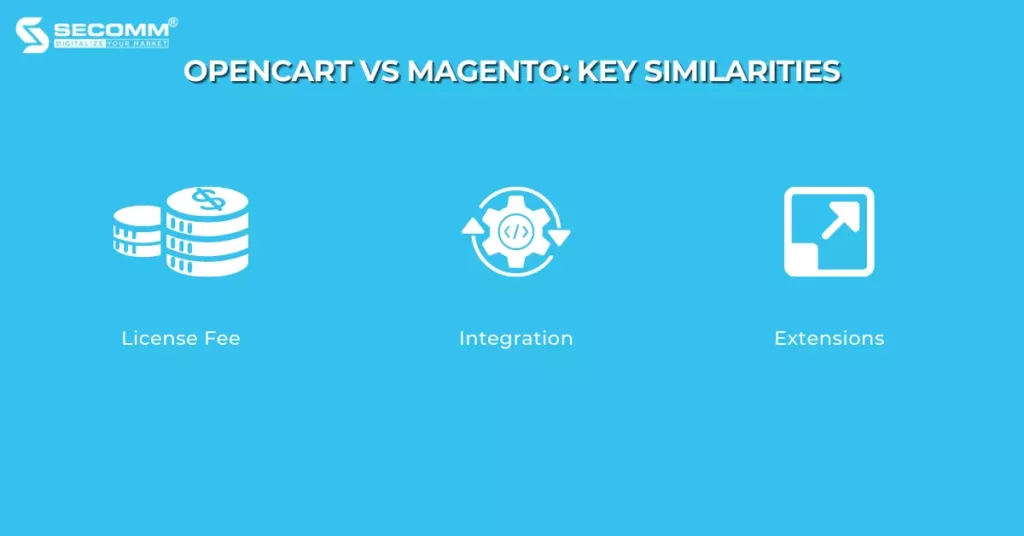
License Fee
Overall, OpenCart and Magento are both open-source platforms developed using PHP. They are both robust eCommerce platforms with powerful features and a multitude of additional utilities.
The usage costs of OpenCart and Magento are quite alike, as both offer free enterprise versions that can be downloaded and installed without any charges.
Integration
Since they are open-source platforms, both possess exceptional customization capabilities for integrating third-party add-ons.
This enables businesses to effortlessly install and manage various management systems like POS, ERP, CRM, and others within a single system.
Extensions
OpenCart offers an extensive library of extensions, with approximately 13,000 extensions at your disposal. Likewise, Magento boasts a vast collection of extensions, with over 5,000 to choose from.
Both platforms enable businesses to enhance their eCommerce websites with a plethora of additional features using these extensions, eliminating the need for coding concerns.
OpenCart vs Magento: Major Differences
Admin Dashboard
OpenCart is recognized as being more user-friendly for beginners, primarily due to its intuitive interface and straightforward installation process. However, businesses should still possess a basic level of technical knowledge related to hosting, FTP (File Transfer Protocol), security upgrades, and the like.
Within the admin dashboard, users can effortlessly navigate through sections such as ‘Catalog,’ “Extensions”, “Sales”, “System”, “Reports”, and “Help”.
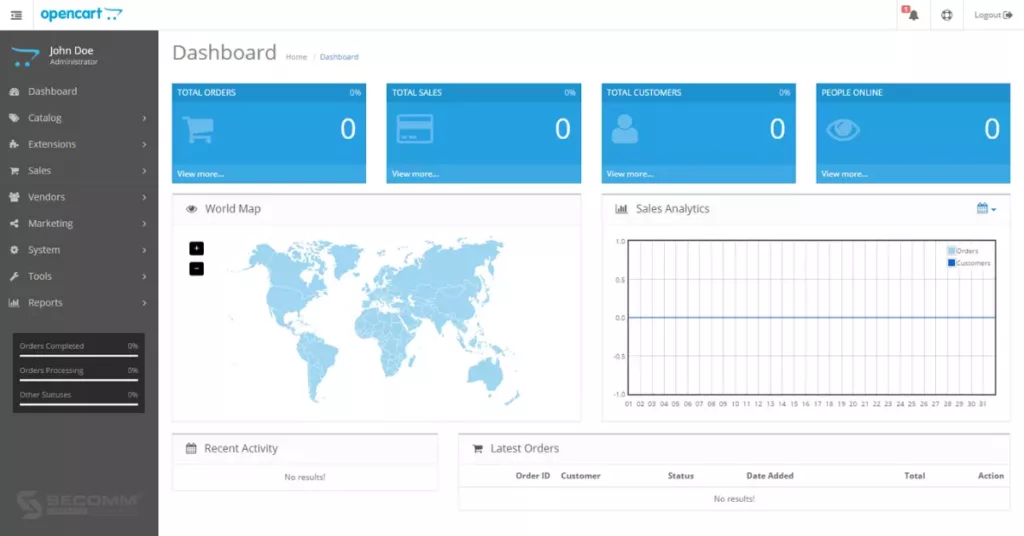
Magento isn’t a “playground” suited for beginners due to its intricate installation process, which demands a high level of technical expertise to set up.
While Magento 2 is considered more user-friendly than Magento 1, the admin dashboard still offers a multitude of options that can pose challenges for newcomers, especially when it comes to understanding Magento-specific terminology, resulting in a time-consuming learning curve.
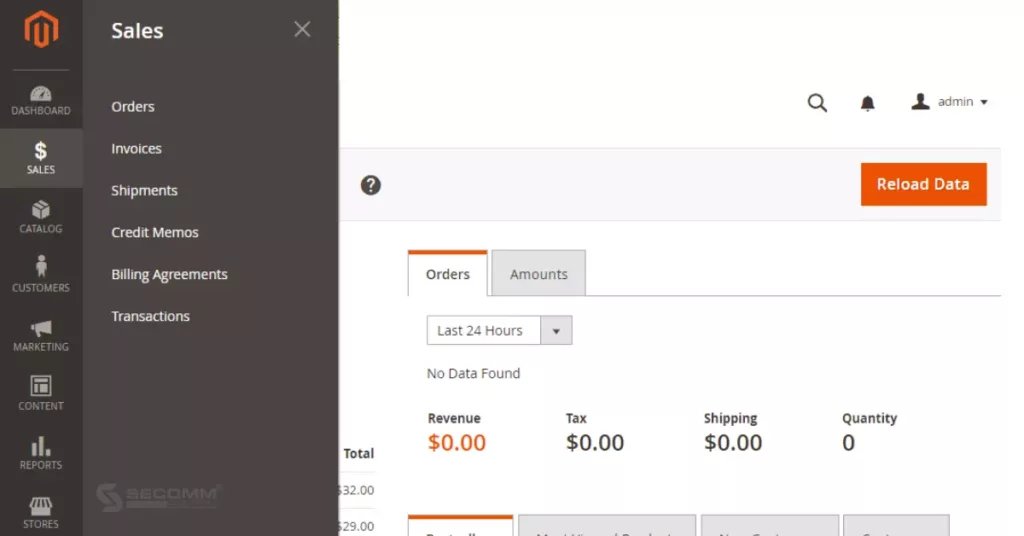
User Interface
OpenCart provides around 500 themes, available in both free and paid options (ranging from $60 to $70), catering to diverse industries. This platform enables businesses to preview their website’s appearance with various themes before making a purchase. Subsequently, businesses can customize these themes according to their specific needs.
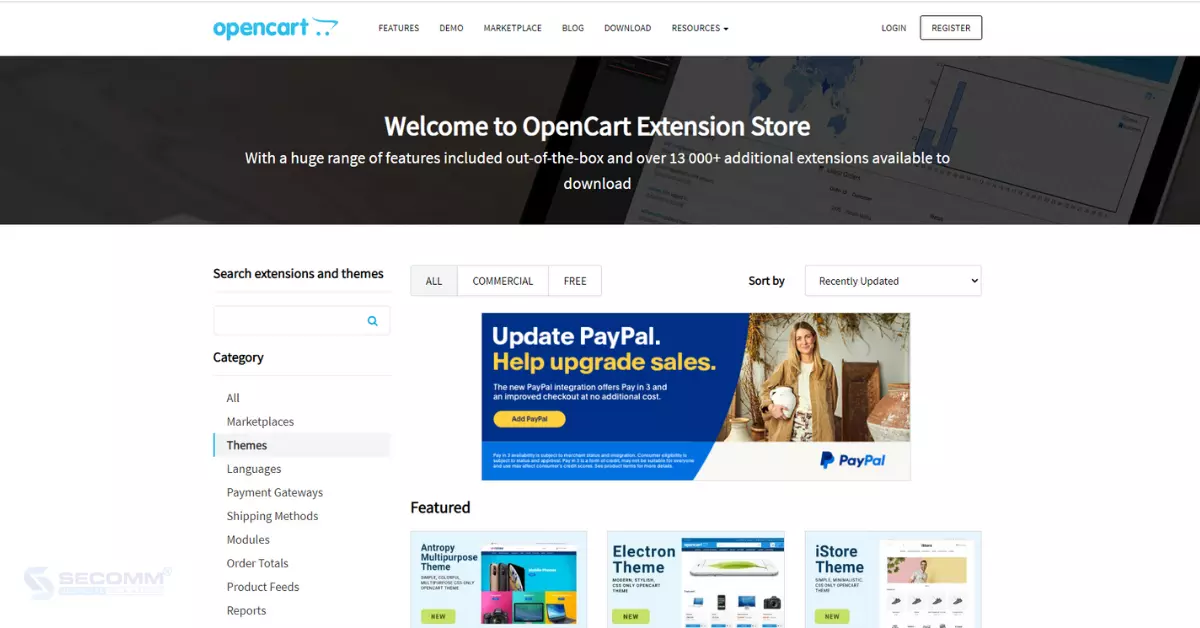
In the case of Magento, businesses have three options for creating user interfaces:
- Utilizing pre-built themes from the Magento Marketplace (ranging from $0 to $500) or theme-selling platforms like Themeforest. This choice provides cost-effective design solutions but may result in a website interface that resembles others.
- Tailoring existing themes. This option enables businesses to save costs while maintaining a unique website interface.
- Crafting a completely bespoke interface with customized themes. While this option sets a business apart from competitors, it comes with a higher price tag compared to the other two methods.
In summary, both OpenCart and Magento offer a wide selection of budget-friendly themes, but Magento allows for more extensive customization to optimize the eCommerce website’s interface.
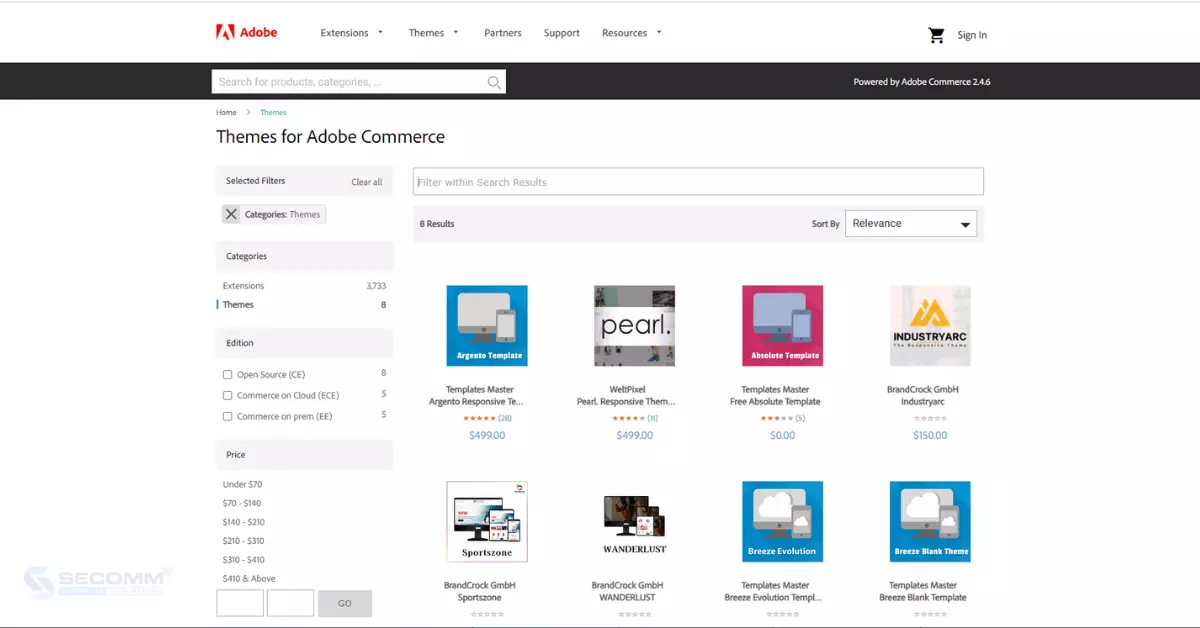
Scalability
In terms of scalability, OpenCart is suitable for small and medium-sized business websites because it can only handle a limited number of products and transactions. On the other hand, Magento is specifically designed to manage large and complex eCommerce websites, capable of handling thousands of products and daily transactions without performance issues.
When it comes to flexibility, OpenCart provides a variety of extensions and add-ons to enhance website functionality. However, its flexibility may be somewhat constrained when dealing with intricate custom requirements. In contrast, Magento offers a higher degree of flexibility, enabling businesses to customize every aspect of their website. It boasts a comprehensive system of modules and better compatibility with third-party integrations, allowing businesses to tailor and expand their website to suit their specific needs.
Overall, Magento surpasses OpenCart in terms of scalability for eCommerce websites.
Support Community
OpenCart offers two types of support to its users:
- Community forums that enable global users to share their knowledge and experiences with OpenCart.
- Paid support services at a monthly fee of $99.
Magento provides a Help Center, but its support staff primarily focuses on Adobe Commerce, which may not fully address the needs of businesses using Open Source. However, Magento boasts a global developer community of over 13,000 individuals, making it relatively straightforward to find solutions.
Security
OpenCart doesn’t assume responsibility for the security of eCommerce websites as it operates on an open-source platform. This means that OpenCart’s code and framework are publicly available, rendering websites more susceptible to potential attacks.
In contrast, despite also being an open-source platform, Magento places a strong emphasis on security. Magento has consistently released security patches since 2015 to identify vulnerabilities. This commitment ensures that eCommerce websites built on Magento maintain a high level of security, instilling confidence in online shoppers.
Through the use of third-party tools such as Mage Report and Mage Scan, businesses can assess their security status. Additionally, Magento employs CSP (Content Security Policy), which offers a structured set of principles for restricting browser content to trusted services only. This allows browsers to determine which web tools to block and which ones to trust.
Development Cost
Even though both OpenCart and Magento are provided with free licenses, there is a significant difference in the development costs for eCommerce websites.
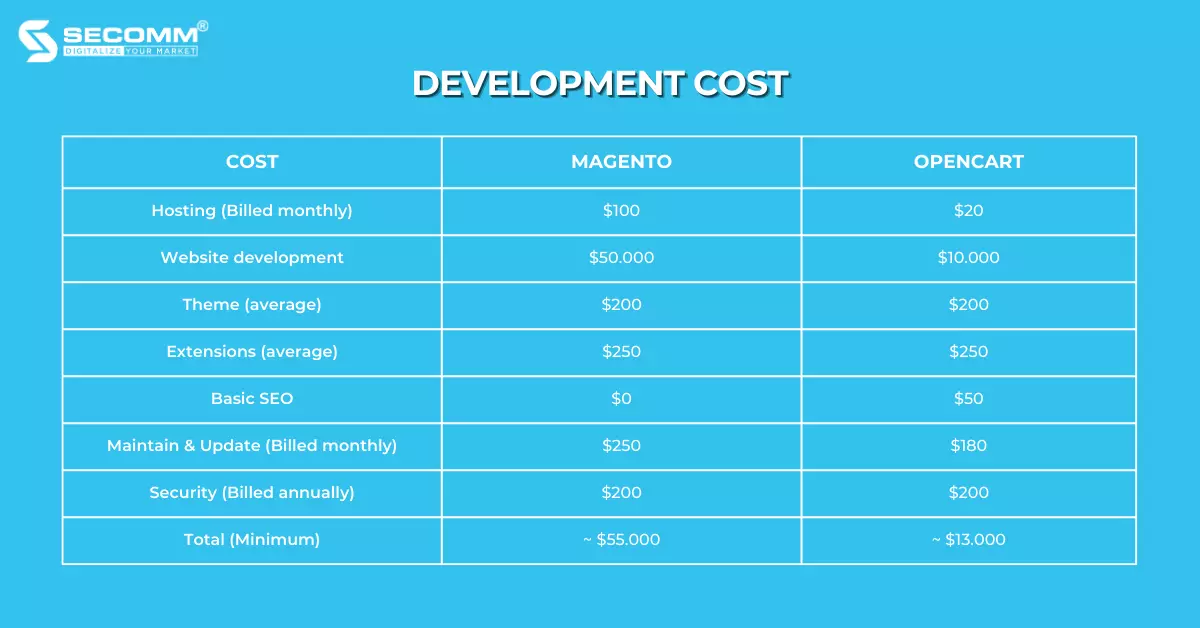
While Magento comes with a higher implementation cost than OpenCart, it offers a plethora of features for eCommerce websites. These include advanced search capabilities with Elasticsearch and OpenSearch, content editing tools that don’t require coding, support for categorizing a wider range of product types, and advanced shipping configuration, among others. In contrast, adding these features to OpenCart would necessitate the use of numerous extensions and increased storage resources to ensure efficient operation.
Considering the evaluations presented earlier, OpenCart proves to be a suitable choice for small and medium-sized enterprises (SMEs) seeking to establish their eCommerce websites. In contrast, Magento is an excellent fit for both SMEs and large corporations with specific and highly customizable eCommerce system requirements. Magento allows businesses to own a tailor-made system by either starting with a basic eCommerce website and gradually enhancing it or by creating a comprehensive system from the ground up.
With our extensive experience in implementing eCommerce solutions for clients across diverse countries, SECOMM comprehends the challenges and complexities that businesses encounter when selecting the ideal platform for constructing a professional eCommerce system.
Contact SECOMM today or call our Hotline at (02871089908) for a complimentary consultation.
 2
2

 6,799
6,799

 0
0

 1
1



